The Hartford Financial Services Group, Inc. | ||
 (Name of Registrant as Specified In Its Charter) | ||
| (Name of Person(s) Filing Proxy Statement, if Other Than the Registrant) | ||
| Filed by the Registrant [X] | ||||
| Filed by a Party other than the Registrant [ ] | ||||
| Check the appropriate box: | ||||
| [ ] | Preliminary Proxy Statement | [ ] | Soliciting Material Under Rule 14a-12 | |
| [ ] | Confidential, For Use of the Commission Only (as permitted by Rule 14a-6(e)(2)) | |||
| [X] | Definitive Proxy Statement | |||
| [ ] | Definitive Additional Materials | |||
The Hartford Financial Services Group, Inc. | ||
 (Name of Registrant as Specified In Its Charter) | ||
| (Name of Person(s) Filing Proxy Statement, if Other Than the Registrant) | ||
| Payment of Filing Fee (Check the appropriate box): | |||||
| [X] | No fee required. | ||||
| [ ] | Fee computed on table below per Exchange Act Rules 14a-6(i)(4) and 0-11. | ||||
| Title of each class of securities to which transaction applies: | |||||
| 2 | |||||
| Aggregate number of securities to which transaction applies: | |||||
| 3 | Per unit price or other underlying value of transaction computed pursuant to Exchange Act Rule 0-11 (set forth the amount on which the filing fee is calculated and state how it was determined): | ||||
| 4 | Proposed maximum aggregate value of transaction: | ||||
| 5 | Total fee paid: | ||||
| [ ] | Fee paid previously with preliminary materials: | ||||
| [ ] | Check box if any part of the fee is offset as provided by Exchange Act Rule 0-11(a)(2) and identify the filing for which the offsetting fee was paid previously. Identify the previous filing by registration statement number, or the form or schedule and the date of its filing. | ||||
| Amount previously paid: | |||||
| Form, Schedule or Registration Statement No.: | |||||
| Filing Party: | |||||
| 4 | Date Filed: | ||||
| NOTICE OF 2018 ANNUAL MEETING OF SHAREHOLDERS |  |
| Date and Time | |
| Wednesday, May 16, 2018 | |
| 12:30 p.m. EDT | |
| Location | |
| One Hartford Plaza | |
| Hartford, CT 06155 | |
| On behalf of the Board of Directors, I am pleased to invite you to attend the Annual Meeting of Shareholders of The Hartford Financial Services Group, Inc. to be held in the Wallace Stevens Theater at our Home Office at 12:30 p.m. EDT. | |
| Voting Items | |
| Shareholders will vote on the following items of business: | |
| 1. | Elect a Board of Directors for the coming year; |
| 2. | Ratify the appointment of Deloitte & Touche LLP as our independent registered public accounting firm for the fiscal year ending December 31, 2018; |
| 3. | Consider and approve, on a non-binding, advisory basis, the compensation of our named executive officers as disclosed in this proxy statement; and |
| 4. | Act upon any other business that may properly come before the Annual Meeting or any adjournment thereof. |
| Record Date | |
You may vote if you were a shareholder of record at the close of business on March 19, 2018. The Hartford’s proxy materials are available via the internet, which allows us to reduce printing and delivery costs and lessen adverse environmental impacts. We hope that you will participate in the Annual Meeting, either by attending and voting in person or by voting through other means. For instructions on voting, please refer to page 66 under “How do I vote my shares?” We urge you to review the proxy statement carefully and exercise your right to vote. | |
| Dated: April 5, 2018 | |
| By order of the Board of Directors, | |
 | |
| Donald C. Hunt | |
| Vice President and Corporate Secretary | |
| VOTING | ||||
 |  | |||
By internet www.proxyvote.com | By toll-free telephone 1-800-690-6903 | |||
 | ||||
 |  |
| |
 | |

NOTICE OF 2015 ANNUAL MEETING OF SHAREHOLDERS
Wednesday, May 20, 2015
12:30 p.m. EDT
Wallace Stevens Theater at The Hartford Financial Services Group, Inc.'s Home Office
On behalf of the Board of Directors, I am pleased to invite you to attend the Annual Meeting of Shareholders of The Hartford Financial Services Group, Inc. to be held in the Wallace Stevens Theater at our Home Office, One Hartford Plaza, Hartford, CT 06155 at 12:30 p.m. EDT.
Shareholders will vote on the following items of business:
1.To elect a Board of Directors for the coming year;
2.To ratify the appointment of Deloitte & Touche LLP as our independent registered public accounting firm for the fiscal year ending December 31, 2015;
3.To consider and approve, on a non-binding, advisory basis, the compensation of our named executive officers as disclosed in this proxy statement;
4.To act upon any other business that may properly come before the Annual Meeting or any adjournment thereof.
You may vote if you were a shareholder of record at the close of business on March 23, 2015. The Hartford's proxy materials are available via the Internet, which allows us to reduce printing and delivery costs and lessen adverse environmental impacts.
We hope that you will participate in the Annual Meeting, either by attending and voting in person or by voting through other means. For instructions on voting, please refer to page77 under "How do I vote my shares?"
We urge you to review the proxy statement carefully and exercise your right to vote.
Dated: April 8, 2015
By order of the Board of Directors,

Donald C. Hunt
Vice President and Corporate Secretary
In person At the Annual Meeting | |||||||||
IMPORTANT INFORMATION IF YOU PLAN TOATTEND THE MEETING IN PERSON: | |||||||||
| Department: | |||||||||
Email: InvestorRelations@TheHartford.com | |||||||||
| Telephone:(860) 547-2537 | |||||||||
| Mail:The Hartford Attn: Investor Relations One Hartford Plaza (TA1-1) Hartford, CT 06155 | |||||||||
If you hold your shares of The Hartford through a brokerage account (in date of March 19, 2018. | |||||||||
You can also join our meeting webcast athttp:// | |||||||||
| 2018 Proxy Statement | 1 | |
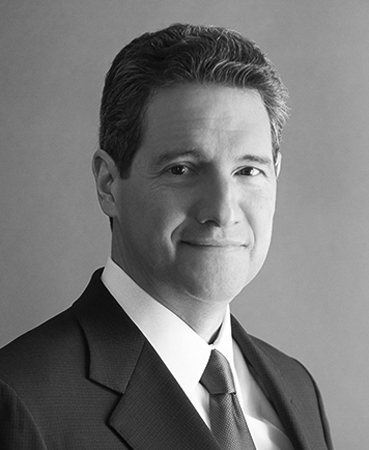 | ||||||
| ||||||
Dear Fellow Shareholders: 2017 was an outstanding year for The Turning to 2018, an improving economy should support opportunities for profitable growth. Stronger employment trends and U.S. GDP growth are a positive for each of our businesses and the insurance industry overall. Higher interest rates should also benefit our investment results, providing an opportunity to invest at more attractive returns. The passage of tax reform and the rollback of regulations are clear pro-growth messages, as U.S. corporations respond to the Consistent with our strategy, everything we do centers around the customer. We see new opportunities to create meaningful differentiation in customer value, risk selection, operating efficiencies and
We know that as an employer, neighbor and steward of the environment, doing business extends beyond our product and service quality. That’s why we are proud to be recognized by the Ethisphere Institute, Bloomberg Financial Services Gender Equality Index, Dow Jones Sustainability Index, and the Human Rights Campaign Corporate Equality Index, among others. We are also grateful to our employees who give their time, talent and generosity as community volunteers to help us achieve our five-year goal of making a positive impact in the lives of 7 million people by the end of 2020. I am pleased with our business’ performance, how we served customers during a historic natural catastrophe year, the strength of our balance sheet and investment results, and our employees’ talent and character. We are well positioned to advance our strategy, and create long-term value for our shareholders, customers, employees and distribution partners. |  | |||||
Dear Fellow Shareholders:
2014 was an outstanding year for The Hartford. Thanks to the commitment and hard work of more than 17,000 employees, we accelerated the transformation of the company and delivered strong financial results. The Hartford's core earnings* grew 9%, or 16% on a diluted per share basis. Net income was $798 million, or $1.73 per diluted share, and our core earnings return on equity* increased a full percentage point.
We continued to focus on increasing shareholder value in 2014. Our accomplishments included expanding core earnings and increasing return on equity in our Property & Casualty, Group Benefits and Mutual Funds businesses; selling the Japan annuity business and thereby substantially reducing the risk in our legacy life and annuity runoff business, known as Talcott Resolution; returning more than $2 billion of capital to shareholders through share repurchases and dividends; and, executing a seamless leadership transition.
No discussion of 2014 would be complete without an expression of our deepest gratitude to Liam McGee and his family. Liam stepped down as Chairman, President and Chief Executive Officer and The Hartford was deeply saddened by his loss in February 2015. Liam was a great leader and made an indelible impression on The Hartford. He restored the company's financial strength and set us on a path to achieve our vision: to be an exceptional company, celebrated for financial performance, character and customer value.
In my previous role as The Hartford's Chief Financial Officer, I worked in partnership with Liam and in my new role as Chairman and Chief Executive Officer, I will continue to execute the strategy we developed for creating shareholder value: 1) profitably grow the company's focused portfolio of businesses, 2) further reduce the size and risk of the legacy annuity liabilities, and 3) deliver more customer value while increasing operating effectiveness and efficiency.
In 2014, we made significant progress in each of these three areas and our strategic and financial transformation is essentially complete. We have placed greater focus on our portfolio of businesses and continue to make important investments for future growth, including investments in products, capabilities, technology and talent.
I am confident that the company is well positioned to create value for our shareholders on a consistent and sustained basis.
Sincerely,

Christopher J. Swift
Chairman and Chief Executive Officer
* Denotes non-GAAP financial measure. See The Hartford's Investor Supplement for the fourth quarter of 2014 available athttp://ir.thehartford.com for more information, including reconciliations to the most directly comparable GAAP financial measures.
www.thehartford.com
2
"
| 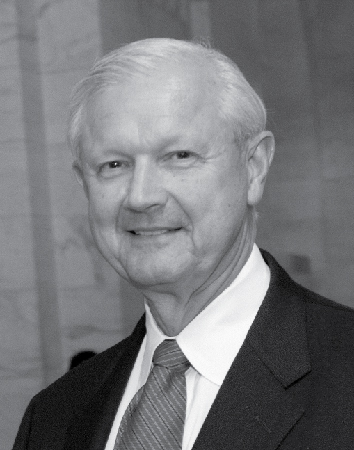 |
Dear Fellow Shareholders:
As fiduciaries of The Hartford, it is the responsibility of the Board to ensure its good governance and to oversee its strategic and operational initiatives in a manner that helps create and protect long-term shareholder value. To that end, the Board focused on a number of key initiatives in 2014, including:
Talent Development and Succession Planning
Talent development and succession planning have been and will continue to be vital components of this Board's governance responsibilities. Accordingly, we routinely discuss key talent indicators with management, meet with potential future leaders of the company, and engage in rigorous succession planning. In 2014, upon Liam McGee's decision to step down as CEO, we realized the return on our investment in talent development and succession planning. It is gratifying that we were in a position to elevate our CFO, Chris Swift, to the role of CEO and appoint from within the company a seasoned leadership team of the caliber we have leading the execution of our strategy.
Strategy and Risk Management
In 2014, the Board remained highly engaged in the company's strategic approach to creating shareholder value. In addition to overseeing the sale of the company's Japan annuity business, a key strategic milestone that significantly reduces the company's risk profile, the Board devoted significant time and discussion throughout the year to intensive review of the company's plans and investments for driving future profitable growth and of its uses of excess capital. The Board also devoted substantial time to risk management. The business and financial operations of The Hartford remain complex, notwithstanding the narrowing of its business model. Risk-taking is an essential part of an insurance business, and the Board worked closely with Chris and his executive leadership team to enable informed judgments on risk within appropriate limitations and oversight.
Executive Compensation
The Board remains committed to establishing transparent executive compensation programs that effectively align the interests of our executive leadership team with the company's shareholders. Accordingly, our programs are designed to be linked to company strategy and provide incentives that correlate with company performance. We regularly review best practices and solicit feedback from our shareholders, which resulted in several changes to the design of our compensation program in 2014.
The members of The Hartford's Board bring a diverse set of skills and perspectives to the oversight of this great company. I am proud to work side-by-side with my fellow directors as the Board's independent presiding director, to serve our shareholders.
Sincerely,

Thomas A. Renyi
Presiding Director
The Hartford Financial Services Group, Inc.2015 Proxy Statement
3
| 2 | www.thehartford.com |
Dear fellow shareholders: As my first year as Lead Director draws to a close, I would like to share my reflections on how the Board worked together to provide independent oversight and represent shareholder interests in 2017. Throughout the year, the Board remained highly engaged in the company's strategy for creating long-term shareholder value by profitably writing business while expanding the range of insurance products and services offered to customers; investing in systems, data and analytical tools and other capabilities to make The Hartford an easier company to do business with; and attracting, retaining and developing top talent. In addition to overseeing the acquisition of Aetna’s U.S. group life and disability business and the sale of Talcott Resolution, the Board devoted significant time and discussion to the company’s long-term plans for driving future profitable growth, allocating time at each board meeting to discuss strategy at the business line and enterprise level. In these sessions, the board discussed advancing existing strategic priorities and investments not only within the framework of the company’s traditional operating plan cycle, but also over a longer period of time. In July, discussions focused on the strategic implications of market outlooks, demographic shifts and industry trends using the year 2025 as a target time horizon to free our thinking from the constraints of the three year planning period, but not so far off as to lack relevance. The Board also devoted substantial time in 2017 to risk management, with a particular focus on cybersecurity and insurance risk. As it discharged these duties, the Board itself underwent fundamental and positive changes to continue our leadership position in corporate governance. In his letter to shareholders last year, my predecessor Tom Renyi described how the Board launched a succession planning process in October 2016 in light of the upcoming retirements of Pat Swygert and Charles Strauss. As a result of that process, which is described in this proxy statement, we were pleased to add to the Board Stephen McGill and Greig Woodring, who bring invaluable insurance industry experience and insights, and Carlos Dominguez, who has a long track record of helping companies develop customer-centric digital strategies to take advantage of disruptive trends. We believe we have the right mix of skills and expertise necessary to support the company’s strategy, however we remain committed to refreshment and, to that end, adopted a 15 year term limit in 2017. We believe this will provide greater transparency and discipline to our refreshment process, improve succession planning, and support Board independence. The company also undertook an initiative to elevate sustainability issues to the full Board, recognizing that not only is it an area of increasing interest to shareholders, but that it makes good business sense. The Hartford has a long history of involvement on environmental, social and governance (ESG) issues. Most recently, its commitment has emphasized four key areas: communities and giving, diversity and inclusion, ethics and governance, and environmental stewardship. The company has established forward-looking goals for each of these areas, and has reported its progress to the Nominating and Corporate Governance Committee annually. In an effort to view ESG topics more holistically, and to better coordinate efforts across the company, in 2017 the company formed a Sustainability Governance Committee comprised of senior management to set and help drive execution of the company's sustainability strategy, with reports to the full Board at least annually. The first such report was a deep dive on climate change and severe weather delivered in February 2018, which, among other things, looked at (1) how the company helps its customers reduce their environmental impact through its products, services and investments; (2) how the company's Enterprise Risk Management function monitors and considers the risks associated with climate change and severe weather; and (3) how the company is reducing its own environmental impact. We believe this new governance framework builds on our early successes, will help drive the coordination of the company’s sustainability efforts and will enable the full Board to oversee ESG risks and opportunities that contribute to the long-term sustainability of the company. In the end, the Board understands that long-term sustainability requires the delivery of value to shareholders, employees, customers, and society at large. As Lead Director, I am proud to work closely with the Chairman and CEO and my fellow independent directors to ensure that The Hartford is a well-governed, shareholder-focused company. Thank you for your continued support. |  | |||||
| "In the end, the Board understands that long-term sustainability requires the delivery of value to shareholders, employees, customers, and society at large." | ||||||
| Sincerely, | ||||||
 | ||||||
| Trevor Fetter | ||||||
| Lead Director | ||||||
| 2018 Proxy Statement | 3 | |
| PROXY SUMMARY | |||
| BOARD AND GOVERNANCE MATTERS | |||
| ITEM | 1: ELECTION OF DIRECTORS | ||
| GOVERNANCE PRACTICES AND FRAMEWORK | |||
| CERTAIN RELATIONSHIPS AND RELATED TRANSACTIONS | |||
| COMMUNICATING WITH THE BOARD | |||
| DIRECTOR NOMINEES | |||
| AUDIT MATTERS | |||
| ITEM | 2: RATIFICATION OF INDEPENDENT REGISTERED ACCOUNTING FIRM | ||
| FEES OF THE | |||
| AUDIT COMMITTEE PRE-APPROVAL POLICIES AND PROCEDURES | |||
| REPORT OF THE AUDIT COMMITTEE | |||
| COMPENSATION MATTERS | |||
| ITEM | |||
| COMPENSATION DISCUSSION AND ANALYSIS | |||
| EXECUTIVE SUMMARY | |||
| COMPONENTS OF COMPENSATION PROGRAM | |||
| PROCESS FOR DETERMINING SENIOR EXECUTIVE COMPENSATION (INCLUDING NEOs) | |||
| PAY FOR PERFORMANCE | |||
| COMPENSATION POLICIES AND PRACTICES | |||
| EFFECT OF TAX AND ACCOUNTING CONSIDERATIONS ON COMPENSATION DESIGN | |||
| COMPENSATION AND MANAGEMENT DEVELOPMENT COMMITTEE INTERLOCKS AND INSIDER PARTICIPATION | |||
| REPORT OF THE COMPENSATION AND MANAGEMENT DEVELOPMENT COMMITTEE | |||
| EXECUTIVE COMPENSATION TABLES | |||
| CEO PAY RATIO | |||
| INFORMATION ON STOCK OWNERSHIP | |||
| INFORMATION ABOUT THE | |||
| APPENDIX A: RECONCILIATION OF GAAP TO NON-GAAP FINANCIAL MEASURES | |||
| 4 | www.thehartford.com |
www.thehartford.com
4
Proxy Summary
Proxy Summary
This summary highlights information contained elsewhere in this proxy statement. This summary does not contain all of the information that you should consider, and you should read the entire proxy statement carefully before voting.
| ITEM 1 | |||
| þ The Board recommends a vote FOR each directornominee | ||
| |||
| |||
| |||
Each director nominee has an established record of accomplishment in areas relevant to overseeing our businesses and possesses qualifications and characteristics that are essential to a well-functioning and deliberative governing body. |
| Director Nominee | Age(1) | Director since | Present or Most Recent Experience | Independent | Current Committees(2) | Other Current Public Company Boards | ||
| Yes | No | |||||||
| Robert B. Allardice III | 71 | 2008 | Former regional CEO, Deutsche Bank Americas | ✓ | • Audit • FIRMCo* | • Ellington Residential Mortgage REIT • GasLog Partners | ||
| Carlos Dominguez | 59 | 2018 | President and COO, Sprinklr | ✓ | • FIRMCo • NCG | • Medidata Solutions | ||
Trevor Fetter(3) | 58 | 2007 | Former Chairman, President and CEO, Tenet Healthcare | ✓ | • Comp • FIRMCo | |||
| Stephen P. McGill | 60 | 2017 | Retired Group President, Aon Plc, Retired Chairman and CEO, Aon Risk Solutions and Aon Benfield | ✓ | • Comp • FIRMCo | |||
| Kathryn A. Mikells | 52 | 2010 | CFO, Diageo plc | ✓ | • Audit • FIRMCo | • Diageo plc | ||
| Michael G. Morris | 71 | 2004 | Former Chairman, President and CEO, American Electric Power Company | ✓ | • Audit • FIRMCo • NCG | • Alcoa • L Brands • Spectra Energy Partners | ||
| Thomas A. Renyi | 72 | 2010 | Former Executive Chairman, Bank of New York Mellon; former Chairman and CEO, Bank of New York Company | ✓ | • Comp • FIRMCo | • Public Service Enterprise Group • Royal Bank of Canada | ||
| Julie G. Richardson | 54 | 2014 | Former Partner, Providence Equity Partners | ✓ | • Audit* • FIRMCo | • UBS • VEREIT • Yext | ||
| Teresa W. Roseborough | 59 | 2015 | Executive Vice President, General Counsel and Corporate Secretary, The Home Depot | ✓ | • Comp • FIRMCo • NCG | |||
| Virginia P. Ruesterholz | 56 | 2013 | Former Executive Vice President, Verizon Communications | ✓ | • Comp* • FIRMCo • NCG | • Bed Bath & Beyond • Frontier Communications | ||
| Christopher J. Swift | 57 | 2014 | Chairman and CEO, The Hartford | û | • FIRMCo | |||
| Greig Woodring | 66 | 2017 | Retired President and CEO, Reinsurance Group of America | ✓ | • Audit • FIRMCo | |||
| Denotes committee chair |
| (1) | As of April 5, 2018 |
| (2) | Full committee names are as follows: Audit – Audit Committee; Comp – Compensation and Management Development Committee; FIRMCo – Finance, Investment and Risk Management Committee; NCG – Nominating and Corporate Governance Committee |
| (3) | Mr. Fetter serves as the Lead Director. For more details on the Lead Director’s role, see page 11 |
| Board Tenure and Diversity |
 |
| 2018 Proxy Statement | 5 | |
| PROXY SUMMARY | ||
| What we heard from shareholders | Board actions taken |
| It is essential that boards have a strong lead independent director with clearly defined authorities and responsibilities | Amended The Hartford's Corporate Governance Guidelines to reflect the expanded responsibilities the Lead Director has assumed over the years (page 11) |
| Boards, as part of their oversight of strategy, must ensure that management consider and communicate how environmental and social issues affect long-term strategy | Formed a Sustainability Governance Committee comprised of senior leaders to set and help drive execution of the company's sustainability strategy, with periodic reports up to the full Board (page 17) |
| It is important to bring fresh perspectives, new skills, and diversity to the boardroom, and boards should have discretion to decide how to promote refreshment | Adopted a policy that an independent director generally may not stand for reelection after serving as a director for 15 years in order to promote regular refreshment (page 18) |
| Independent | ✓ | Majority independent directors | ||
| ✓ | Independent key committees (Audit, Compensation, Nominating) | |||
| ✓ | Strong and engaged independent Lead Director | |||
| Engaged Board /Shareholder Rights | ✓ | Directors elected annually | ||
| ✓ | Majority vote standard (with plurality carve-out for contested elections) | |||
| ✓ | Proxy access right | |||
| ✓ | Director resignation policy | |||
| ✓ | Over-boarding policy limits total public company boards, including The Hartford, to 5 for non-CEOs and 2 for sitting CEOs | |||
| ✓ | Rigorous Board and committee self-evaluation conducted annually | |||
| ✓ | Meaningful Board education and training on recent and emerging governance and industry trends | |||
| ✓ | Annual shareholder engagement on governance, compensation and sustainability issues | |||
| Good Governance | ✓ | Board diversity of experience, tenure, age and gender | ||
| ✓ | Annual review of CEO succession plan by the independent directors with the CEO | |||
| ✓ | Annual Board review of senior management long-term and emergency succession plans | |||
| ✓ | Stock-ownership guidelines of 6x salary for CEO and 4x salary for other named executive officers | |||
| ✓ | Annual Nominating Committee review of The Hartford's political and lobbying policies and expenditures | |||
| Commitment to Sustainability | ✓ | Board oversight of sustainability matters; Nominating Committee oversight of sustainability governance framework | ||
| ✓ | Sustainability Governance Committee comprised of senior management charged with overseeing a comprehensive sustainability strategy and ensuring that the full Board is briefed at least annually | |||
| 6 | www.thehartford.com |
| PROXY SUMMARY | ||
| ITEM 2 | ||
RATIFICATION OF INDEPENDENT REGISTERED ACCOUNTING FIRM | þ The Board recommends a vote FOR this item | |
| As a matter of good corporate governance, the Board is asking shareholders to ratify the selection of Deloitte & Touche LLP as our independent registered public accounting firm for | ||
| ITEM 3 | ||||
ADVISORY VOTE TO APPROVE EXECUTIVE COMPENSATION | þ The Board recommends a vote FOR this item | |||
| The Board is asking shareholders to approve, on an advisory basis, the compensation of our named executive officers | ||||
2017 FINANCIAL RESULTS
5
Proxy Summary
Performance Summary
Executing on our Strategy
We achieved outstanding performance in 2014. We continued to transform our business to improve profitability's U.S. group life and reduce risk, we used our financial strength to return capital to our shareholders,disability business; and we underwent a seamless leadership transition. Highlighted below are somethe transfer of 29% of our key accomplishments in 2014. We view the transformation we began in 2012 as essentially complete, and we are focused on the future. Our primary objectives areoutstanding pension liabilities to improve return on equity and grow book value per share to drive top quartile shareholder returns. While there is still work to be done, the Board and management are pleased with the progress we made in 2014.
Key Accomplishments in 2014
Prudential Financial, Inc.
| Announced Agreement to Sell Talcott Resolution | ||||||
| Reduced | ||||||
• Sale will complete our exit of individual life and annuity run-off business • Expected to improve future return on equity ("ROE") and earnings growth profile and enhance financial flexibility • Provides $2.7 billion of value to shareholders • Resulted in a net loss on discontinued operations of approximately $2.9 billion | • Makes us the second largest group life and disability insurer in the U.S.(1) • Increases operating scale and enhances analytical and claims capabilities • Included industry-leading claims and administration technology, which will enhance the experience we deliver to customers • Enhances The Hartford's distribution footprint | |||||
• • Entrusts the pension benefits of approximately 16,000 former employees to a highly-rated, experienced retirement benefits provider in the industry • • Resulted in |
|
|
| |||
* Combined ratio, excluding catastrophes
Delivering Superior Shareholder Returns
Strong financial performance, a significantly improved risk profilethe year, which do not include the three charges to net income listed above, were $1.0 billion, an 11% increase from 2016.
| 2018 Proxy Statement | 7 | |
| PROXY SUMMARY | ||
One-Year Total Shareholder Return*

www.thehartford.com
6
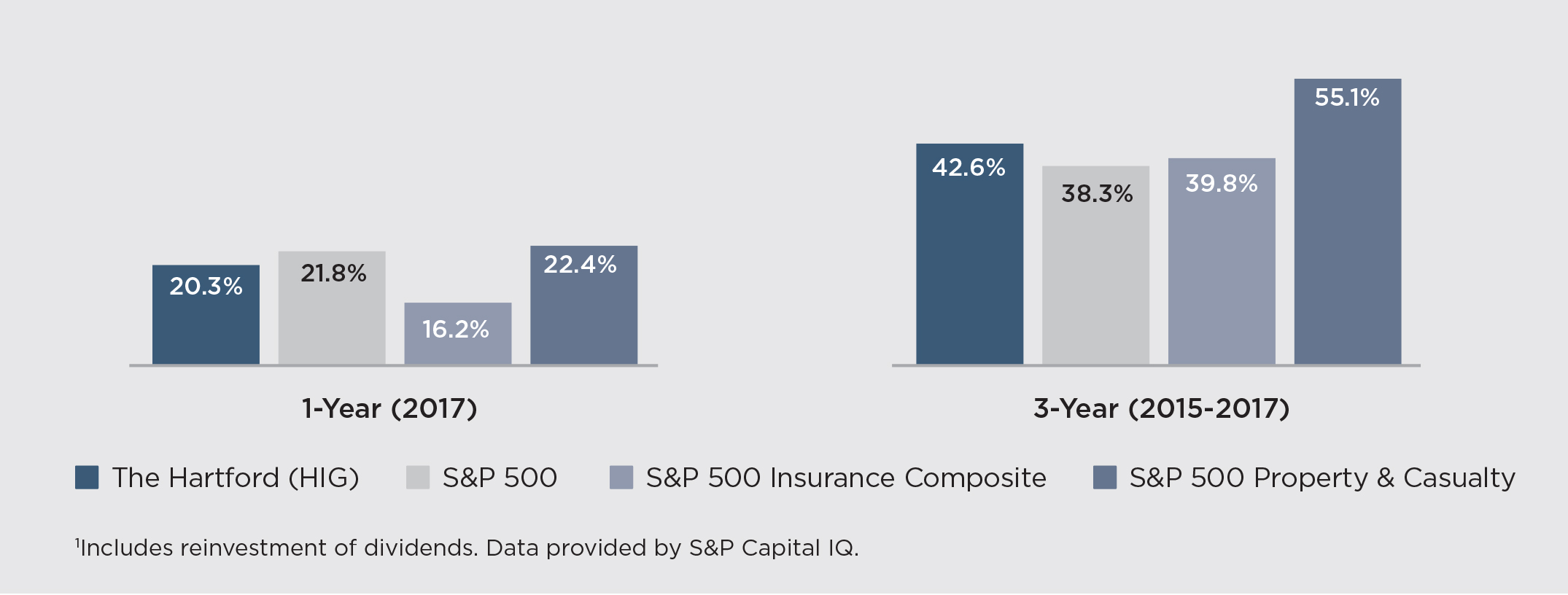
Proxy Summary
Three-Year Total Shareholder Return and Key Management Actions*
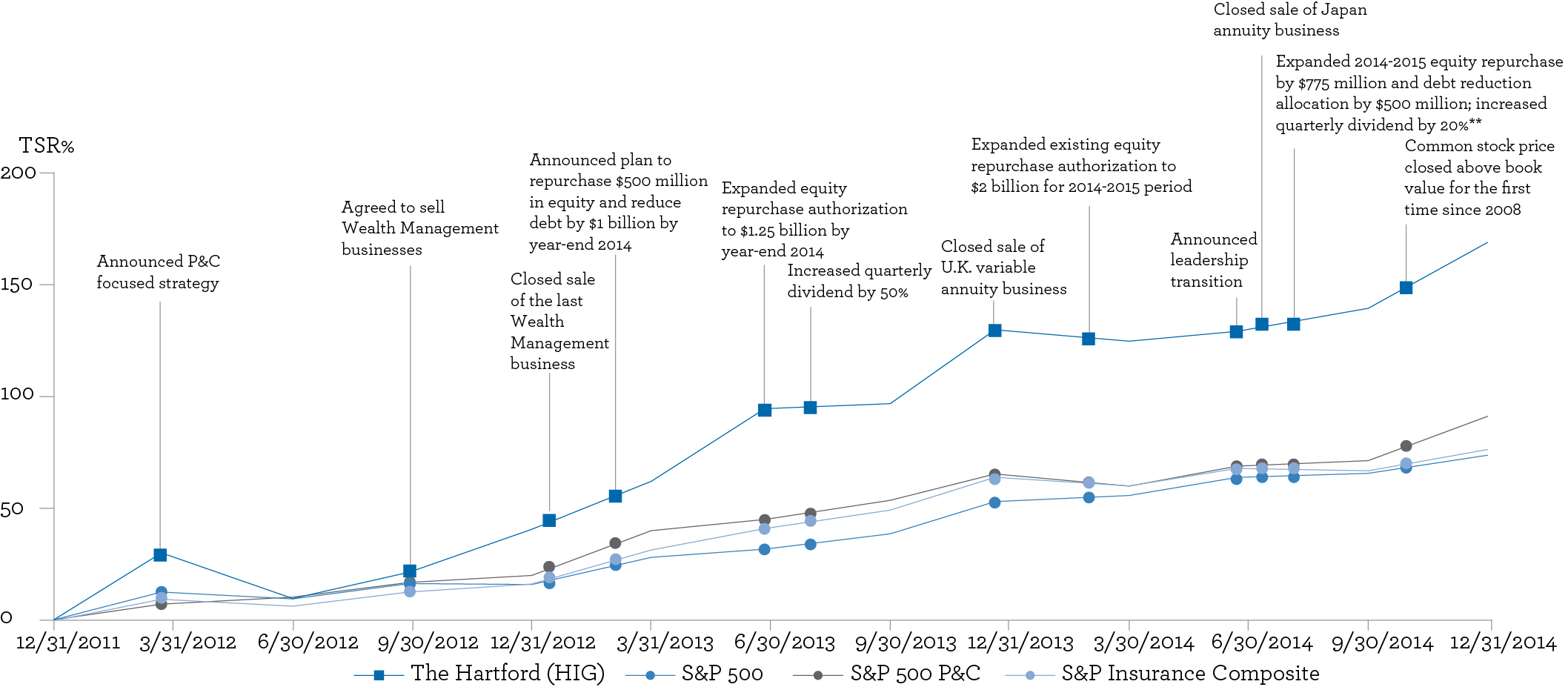
*Timeline not to scale.
**Total capital management plan authorization for 2014-2015: $2.775 billion in equity repurchases; $1.156 billion in debt reduction; and 20% increase to quarterly dividend.
Board and Governance Highlights
Governance Decisions
| ||
| ||
|
The Hartford Financial Services Group, Inc.2015 Proxy Statement
7
Proxy Summary
Board Nominees
•Audit* •FIRMCo •Ellington Residential Mortgage REIT •GasLog Partners •Comp* •FIRMCo •Tenet Healthcare •Comp •FIRMCo •Audit •FIRMCo •NCG •Alcoa •L Brands •Spectra Energy •Comp •FIRMCo •Public Service Enterprise Group •Royal Bank of Canada •Audit •FIRMCo •NCG •FIRMCo •Audit •FIRMCo •NCG •Frontier Communications •Audit •FIRMCo* •NCG •FIRMCo •Comp •FIRMCo •NCG* •United Technologies Corporation Name Age Director since Experience Independent Current
Committee Memberships(1) Other Current
Public Company BoardsYes No Robert B.
Allardice III 68 2008 Former regional CEO, Deutsche Bank Americas ✓ Trevor Fetter 55 2007 President and CEO, Tenet Healthcare ✓ Kathryn A. Mikells 49 2010 CFO, Xerox ✓ Michael G. Morris 68 2004 Former Chairman, President and CEO, American Electric Power Company ✓ Thomas A. Renyi(2) 69 2010 Former Executive Chairman, Bank of New York Mellon; former Chairman and CEO, Bank of New York Company ✓ Julie G. Richardson 52 2014 Former Partner, Providence Equity Partners ✓ Teresa W. Roseborough 56 2015 Executive Vice President, General Counsel and Corporate Secretary, The Home Depot ✓ Virginia P. Ruesterholz 53 2013 Former Executive Vice President, Verizon Communications ✓ Charles B. Strauss 72 2001 Former President and CEO, Unilever U.S. ✓ Christopher J. Swift 54 2014 Chairman and CEO, The Hartford ✓ H. Patrick Swygert 72 1996 President Emeritus and professor emeritus, Howard University ✓
www.thehartford.com
8
Proxy Summary
Governance Best Practices
The Board and management regularly review best practices in corporate governance and modify our governance policies and practices as warranted. Our current best practices include:
Compensation Highlights
2014 Compensation Decisions
The Hartford Financial Services Group, Inc.2015 Proxy Statement
9
Proxy Summary
2014 Active NEO Compensation Summary
The table below reflects the 20142017 compensation package (base salary, AIPannual incentive plan ("AIP") award and long-term incentive ("LTI"(“LTI”) award) for each active NEO.named executive officer ("NEO"). Although this table is not a substitute for theSummary Compensation Tableinformation beginning on page55, 50, we believe it provides a simple and concise picture of2017 compensation decisions made for the active NEOs in 2014.
Compensation Component C. Swift B. Bombara D. Elliot B. Johnson R. Rupp Base Salary Rate(1) $ 1,000,000 $ 625,000 $ 900,000 $ 500,000 $ 600,000 2014 AIP Award $ 2,139,000 $ 1,350,000 $ 1,800,000 $ 1,450,000 $ 1,600,000 2014 LTI Award(2) $ 2,200,000 $ 1,000,000 $ 2,000,000 $ 1,100,000 $ 1,400,000 Total 2014 Compensation Package(3) $ 5,339,000 $ 2,975,000 $ 4,700,000 $ 3,050,000 $ 3,600,000
decisions.
| Compensation Component | C. Swift | B. Bombara | D. Elliot | B. Johnson | W. Bloom | ||||||||||||||
| Base Salary Rate | $ | 1,100,000 | $ | 700,000 | $ | 925,000 | $ | 525,000 | $ | 550,000 | |||||||||
| 2017 AIP Award | $ | 4,675,000 | $ | 1,900,000 | $ | 3,150,000 | $ | 2,300,000 | $ | 1,575,000 | |||||||||
| 2017 LTI Award | $ | 7,500,000 | $ | 1,750,000 | $ | 5,000,000 | $ | 1,500,000 | $ | 1,000,000 | |||||||||
| Total 2017 Compensation Package | $ | 13,275,000 | $ | 4,350,000 | $ | 9,075,000 | $ | 4,325,000 | $ | 3,125,000 | |||||||||
| 2017 Compensation Decision | Rationale |
| The Compensation Committee approved an AIP funding level of 170% of target. | Performance against pre-established Compensation Core Earnings targets resulted in a formulaic AIP funding level of 183% of target. The Compensation Committee reduced this funding level to 170% based on certain qualitative factors, including quality of P&C earnings (excluding catastrophes), which, while strong in a very competitive market, were relatively flat to budget. (page 44) |
| The Compensation Committee certified a 2015-2017 performance share award payout at 104% of target. | The company's TSR during the performance period was at the 40th percentile relative to 18 peer companies, resulting in a payout of 75% of target for the TSR component (50% of the award). The company's average annual Compensation Core ROE during the performance period was 9.4%, resulting in a payout of 134% of target for the ROE component (50% of the award). (page 47) |
| As a result of the December 3, 2017 agreement to sell the Talcott Resolution business, the Compensation Committee took actions to ensure that Talcott Resolution core earnings through September 30, 2017 were included in the determination of the AIP funding level and ROE results for performance shares. | Upon signing an agreement to sell Talcott Resolution, GAAP accounting required that financial results from the business be reclassified as discontinued operations, which are excluded from core earnings. The Compensation Committee determined that including Talcott Resolution core earnings for the period in which management was both actively managing the business and separately reporting its results externally was appropriate. In addition, AIP and performance share targets were established assuming Talcott Resolution operating results were included in the business mix. (page 44) |
| The Compensation Committee excluded the results of the group life and disability business acquired from Aetna on November 1, 2017 in determining the 2017 AIP funding level. | While including the results of the acquired business would have slightly increased the 2017 AIP funding level, the Compensation Committee determined that excluding them was appropriate based upon overall immateriality, and because the results of the business were not part of the business mix when the AIP target was established. (page 44) |
| 8 | www.thehartford.com |
The Compensation Committee regularly reviews
| What We Do | |||
| ✓ | Approximately | ||
| ✓ | Senior Executives are eligible for the same benefits as full-time employees generally, including health, life insurance, disability and retirement benefits | ||
| ✓ | |||
| ✓ | Double trigger requirement for | ||
| ✓ | |||
| Independent Board compensation consultant | |||
| ✓ | Comprehensive risk mitigation in plan design and annual review of compensation plans, policies and practices | ||
| ✓ | All employees and directors are prohibited from engaging in hedging, monetization, derivative and similar transactions with company securities | ||
| ✓ | Senior Executives are prohibited from pledging company securities | ||
| ✓ | |||
| ✓ | Compensation peer groups are evaluated periodically to align with investor expectations and changes in market practice or our | ||
| ✓ | Competitive burn rate and dilution for equity program | ||
| What We Don't Do | |||
| û | No excise tax gross-up upon a change of control or income tax gross-up for | ||
In furtherance of our commitment to best practices, our 2014 Incentive Stock Plan does not allow the following:
| û | No individual employment agreements | ||
PAY MIX | CEO | PAY MIX | OTHER NEOs | |
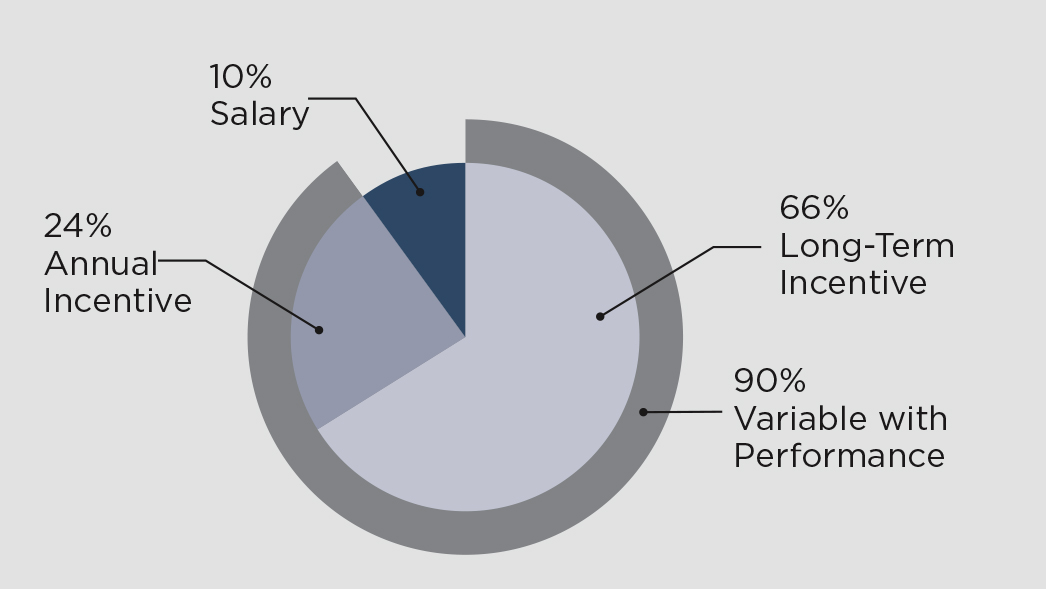 | 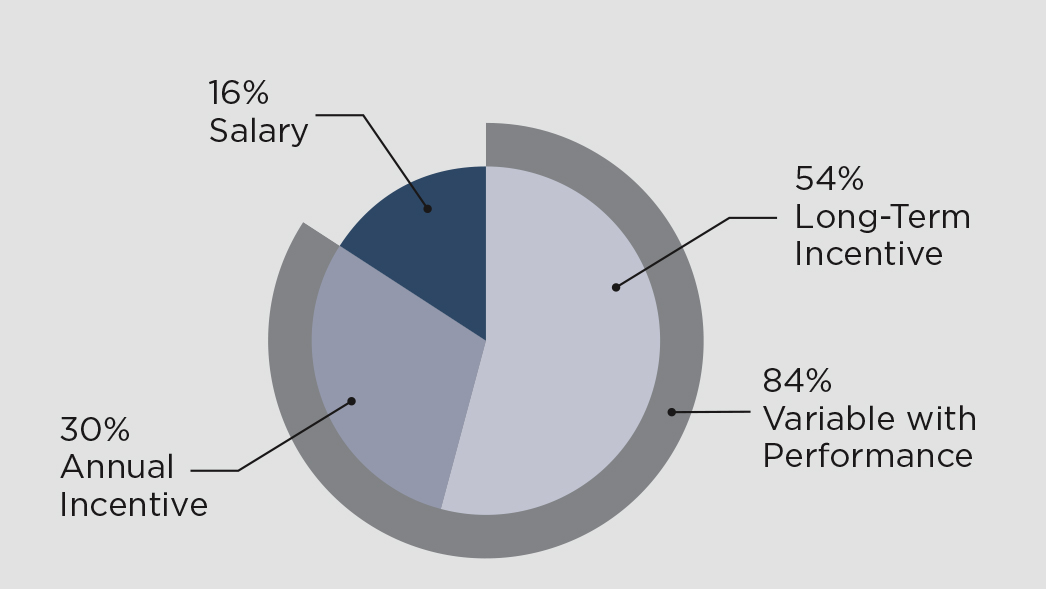 | |
www.thehartford.com
10
| 2018 Proxy Statement | 9 | |
Board and Governance Matters
Board and Governance Matters

The Hartford Financial Services Group, Inc.2015 Proxy Statement
11
Letter from the Chairman of our Nominating and Corporate Governance Committee
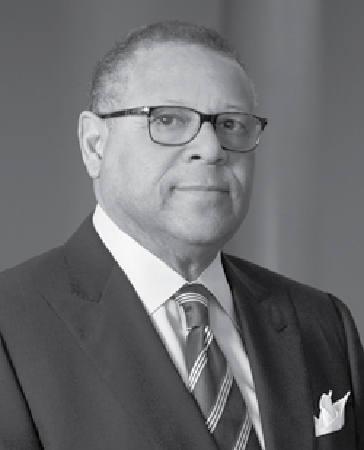 |
| |
| ITEM 1 | ||
| ELECTION OF DIRECTORS |  The Board recommends that shareholders vote “FOR”all nominees for election as directors. The Board recommends that shareholders vote “FOR”all nominees for election as directors. | |
| The Nominating Committee believes that the director nominees possess qualifications, skills and experience that are consistent with the standards for the selection of nominees for election to the Board set forth in our Corporate Governance Guidelines described on pages 18-20 and that they have demonstrated the ability to effectively oversee The Hartford’s corporate, investment and business operations. Biographical information for each director nominee is described beginning on page 25, including the principal occupation and other public company directorships (if any) held in the past five years and a description of the specific experience and expertise that qualifies each nominee to serve as a director of The Hartford. | ||
Dear Fellow Shareholders:
In 2014, the Board carefully considered its board leadership structure. While we consider the appropriateness of the structure regularly, that deliberation is never more critical than in the context of leadership succession.
In June 2014, the company announced that after five years of leading the company through a successful financial turnaround and strategic transformation, Liam E. McGee would step down as the CEO and Christopher J. Swift would be appointed CEO, effective July 1, 2014. Upon the appointment of Mr. Swift to the role of CEO, the Board determined that it was in the best interests of the company and its shareholders for Mr. McGee to continue his service as Executive Chairman for a transitional period.
The Board deliberated extensively on what the company's board leadership structure should be following that transitional period, sought feedback from shareholders and considered extensive expert corporate governance analysis. In December, the Board concluded that the company's historical approach of combining the roles of CEO and Chairman while maintaining strong independent Board leadership continues to be the optimal leadership structure from which to carry out its oversight of the company's strategy, business operations and risk management. Accordingly, upon Mr. McGee's resignation from the Board on January 5, Mr. Swift was vested with the responsibilities of Chairman and CEO.
In reaching its decision to recombine the roles of CEO and Chairman, the Board took into account the following factors:
•Mr. Swift, a partner to Mr. McGee in developing the company's strategy and the principal leader of business operations, is uniquely positioned to identify and communicate key strategic and operational issues and the interests of the company's stakeholders to the Board.
•The Board has strong, diverse and active independent directors of varying tenures.
•Elements of the company's corporate governance structure, including a strong presiding director role and mandatory meetings of the non-management directors, effectively protect against any potential conflicts that may result from combining the roles of CEO and Chairman.
•The strength of Mr. Swift's performance both during his tenure as CFO and subsequently as CEO.
As we looked to carry the momentum of 2014 forward, we concluded that combining the roles of Chairman and CEO, with a strong independent presiding director, is in the best interests of shareholders as it best positions the company for future success.
Sincerely,

Pat Swygert
Chairman of the Nominating and Corporate Governance Committee
www.thehartford.com
12
Governance Practices and Framework
Governance Practices and Framework
At The Hartford, we aspire to be an exceptional company celebrated for financial performance, character, and customer value. We believe that good governance practices and responsible corporate behavior are central to this vision and contribute to our long-term performance. Accordingly, the Board and management regularly reviewconsider best practices in corporate governance and shareholder feedback and modify our governance policies and practices as warranted. Our current best practices include:
| Independent Oversight | ✓ | Majority independent directors | ||
| ✓ | ||||
| ✓ | Strong and engaged independent | |||
| Engaged Board /Shareholder Rights | ✓ | Directors elected annually | ||
| ✓ | Majority vote standard (with plurality carve-out for contested elections) | |||
| ✓ | Proxy access right | |||
| ✓ | Director resignation policy | |||
| ✓ | Over-boarding policy limits total public company boards, including The Hartford, to 5 for non-CEOs and 2 for sitting CEOs | |||
| ✓ | Rigorous Board and committee | |||
| ✓ | ||||
| ✓ | Annual shareholder engagement | |||
| Good Governance | ✓ | Board diversity of experience, tenure, age and gender | ||
| ✓ | Annual review of CEO succession plan by the independent directors with the CEO | |||
| ✓ | Annual Board review of senior management long-term and emergency succession plans | |||
| ✓ | Stock-ownership guidelines of 6x salary for CEO and 4x salary for other named executive officers | |||
| ✓ | Annual Nominating Committee review of The Hartford's political and lobbying policies and expenditures | |||
| Commitment to Sustainability | ✓ | Board oversight of sustainability matters; Nominating Committee oversight of sustainability governance framework | ||
| ✓ | Sustainability Governance Committee comprised of senior management charged with overseeing a comprehensive sustainability strategy and ensuring that the full Board is briefed at least annually | |||
•
•
•
•
| 10 | www.thehartford.com |
| BOARD AND GOVERNANCE MATTERS | ||
• (the Audit Committee; the Compensation and Management Development Committee ("Compensation Committee"); the Finance, Investment and Risk Management Committee ("FIRMCo"); and the Nominating and Corporate Governance Committee ("Nominating Committee"))
•
•
•years, including the following:
•
•
•approvingBoard and meeting agendas for the Board;
The Hartford Financial Services Group, Inc.2015 Proxy Statement
13
Governance Practices and Framework
•approving the Board meeting schedules to help ensure that there is sufficient time for discussion of all agenda items;
•calling and presiding over
• information for the independent non-management sessions and briefing, as appropriate, the Chairman on any issues arising out of these sessions;
oversight. As part of its evaluation process, the Board has committed to undertaking an annual review of its leadership structure to ensure it continues to serve the best interests of shareholders and positions the company for future success.
| 2018 Proxy Statement | 11 | |
| BOARD AND GOVERNANCE MATTERS | ||

| Component | Actions |
Board Evaluation and Development of Goals (May) | The Lead Director leads a Board evaluation discussion in executive session guided by the Board’s self-assessment questionnaire and the key themes identified through the one-on-one discussions. The Board identifies successes and areas for improvement from the prior Board year and establishes formal goals for the year ahead. |
Annual Corporate Governance Review / Shareholder Engagement Program (October to December) | The Nominating Committee performs an annual review of The Hartford's corporate governance policies and practices in light of best practices, recent developments and trends. In addition, the Nominating Committee reviews feedback on governance issues provided by shareholders during our annual shareholder engagement program. |
Interim Review of Goals (December) | The Lead Director leads an interim review of progress made against the goals established during the Board evaluation discussion in May. |
Board Self-Assessment Questionnaires (February) | The governance review and shareholder feedback informs the development of written questionnaires that the Board and its standing committees use to help guide self-assessment. The Board’s questionnaire covers a wide range of topics, including the Board’s: •fulfillment of its responsibilities under the Corporate Governance Guidelines; •effectiveness in overseeing our business plan, strategy and riskmanagement; •leadership structure and composition, including mix of experience, skills, diversityand tenure; •relationship with management; and •processes to support the Board’s oversight function. |
One-on-One Discussions (February to May) | The Lead Director meets individually with each independent director on Board effectiveness, dynamics and areas for improvement. |
| 2016-2017 Board Year Goal | Key Results |
| Further enhance communication with management both during and between meetings, including more opportunities to communicate one-on-one with the CEO and off-cycle communications on the status of initiatives and market developments | Board communication materially improved, including more frequent off-cycle meetings between Chairman and Lead Director, Board letters, and updates on strategic initiatives and market developments |
| Use metrics, competitor analysis and benchmarking to an even greater extent | Use of metrics and benchmarking improved, contributing to better informed Board discussions |
Meet in executive session both at the beginning and end of Board meetings | Executive sessions are more frequent, productive and meaningful |
| 12 | www.thehartford.com |
| BOARD AND GOVERNANCE MATTERS | ||
| AUDIT COMMITTEE | |||
Current Members:* R. Allardice K. Mikells M. Morris J. Richardson (Chair) C. Strauss G. Woodring Meetings in 2017:10 | “With the number of significant and complex transactions, most recently the acquisition of Aetna’s group benefits business and the agreement to sell the Talcott business, the Committee focused on controls over the accounting for these transactions to help ensure the integrity of our financial reporting. The Committee also prioritized oversight of controls associated with the Company’s deferred tax assets.” Julie G. Richardson, Committee Chair since 2016 Roles and Responsibilities •Overseesthe integrity of our financial statements •Oversees our accounting, financial reporting and disclosure processes and theadequacy of management’s systems of internal control over financial reporting •Oversees The Hartford's relationship with, and the performance of, the independent registered public accounting firm, including its qualifications andindependence •Oversees the performance of our internal audit function •Oversees our compliance with legal and regulatory requirements and our Code ofEthics and Business Conduct •Discusses with management policies with respect to risk assessment and riskmanagement | ||
| * | All members are “financially literate” within the meaning of the listing standards of the NYSE. Directors Allardice, Mikells, Morris, Richardson and Strauss are “audit committee financial experts” within the meaning of the SEC’s regulations. | ||
| COMPENSATION AND MANAGEMENT DEVELOPMENT COMMITTEE | ||
Current Members: T. Fetter S. McGill T. Renyi T. Roseborough V. Ruesterholz (Chair) H. Swygert Meetings in 2017:6 | “While the Committee considers talent development and succession planning annually, it was an area of increased attention with a number of important management changes in 2017, including the internal promotion of our new Chief Risk Officer; expanded responsibilities for the head of our Small Commercial business, who also assumed leadership for the Personal Lines business; and key external hires, including our new Chief Underwriting Officer.” Virginia Ruesterholz, Committee Chair since 2016 Roles and Responsibilities •Oversees executive compensation and assists us in defining an executive totalcompensation policy •Works with management to develop a clear relationship between pay levels,performance and returns to shareholders, and to align our compensation structurewith our objectives •Has the ability to delegate, and has delegated to the Executive Vice President,Human Resources, or her designee, responsibility for the day-to-day operations ofour compensation plans and programs •Has sole authority to retain, compensate and terminate any consulting firm used toevaluate and advise on executive compensation matters •Considers independence standards required by the NYSE or applicable law inregards to compensation consultants, accountants, legal counsel or other advisors,prior to their retention •In consultation with a senior risk officer, meets annually to discuss and evaluatewhether incentive compensation arrangements create material risks to thecompany •Retains responsibility for compensation actions and decisions with respect tocertain senior executives, as described in theCompensation Discussion and Analysisbeginning on page 35 | |
| 2018 Proxy Statement | 13 | |
| BOARD AND GOVERNANCE MATTERS | ||
| FINANCE, INVESTMENT AND RISK MANAGEMENT COMMITTEE | ||
Current Members: R. Allardice (Chair) C. Dominguez T. Fetter S. McGill K. Mikells M. Morris T. Renyi J. Richardson T. Roseborough V. Ruesterholz C. Strauss C. Swift H. Swygert G. Woodring Meetings in 2017:5 | “In 2017, FIRMCo continued to focus on the management of cyber risks including the potential impacts on The Hartford and its customers. While the Committee continued to manage investment risks, insurance risks were also a focal point as a result of the elevated catastrophe events in 2017, with the Committee concentrating on the Company’s underwriting discipline and management of catastrophe risks.” Robert B. Allardice III, Committee Chair since 2016 Roles and Responsibilities •Reviews and recommends changes to enterprise policies governing managementactivities relating to major risk exposures such as market risk, liquidity and capitalrequirements, insurance risks and cybersecurity •Reviews our overall risk appetite framework, which includes an enterprise riskappetite statement, risk preferences, risk tolerances, and an associated limitstructure for each of our major risks •Reviews and recommends changes to our financial, investment and riskmanagement guidelines •Provides a forum for discussion among management and the entire Board of keyfinancial, investment, and risk management matters | |
| NOMINATING AND CORPORATE GOVERNANCE COMMITTEE | ||
Current Members: C. Dominguez M. Morris T. Roseborough V. Ruesterholz C. Strauss (Chair) H. Swygert Meetings in 2017: 5 | “The Committee principally focused on board refreshment and ESG governance in 2017. Following a robust director search, we added three new directors who bring insurance industry and digital expertise, in addition to adopting a term limit policy that ensures a healthy mix of director tenures and experience. We also developed a new governance framework that enables the full Board to oversee ESG risks and opportunities that contribute to the long-term sustainability of the company.” Charles B. Strauss, Committee Chair since 2016 Roles and Responsibilities •Advises and makes recommendations to the Board on corporate governancematters •Considers potential nominees to the Board •Makes recommendations on the organization, size and composition of the Boardand its committees •Considers the qualifications, compensation and retirement of directors •Reviews our policies and reports on political contributions • Oversees the establishment, management and processes related to our ESG activities | |
| 14 | www.thehartford.com |
| BOARD AND GOVERNANCE MATTERS | ||
Amonghas primary risk oversight responsibility for all matters within the current director nominees, six have fewer than five yearsscope of service, two have over 10 yearsits charter. Annually, each committee reviews and reassesses the adequacy of service,its charter and the remaining three nominees have between fiveNominating Committee reviews all charters and ten yearsrecommends any changes to the Board for approval. The chart below provides examples of tenure. each committee’s risk oversight responsibilities.
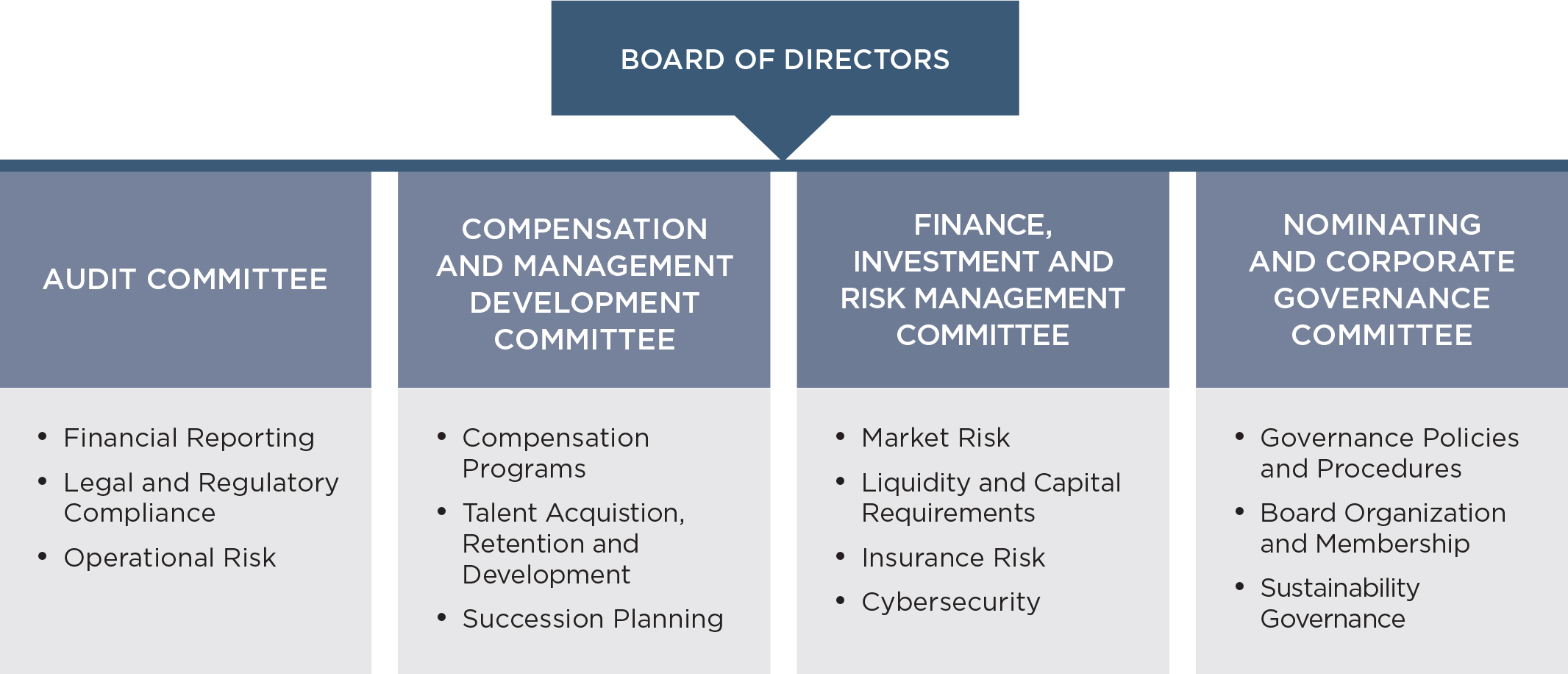
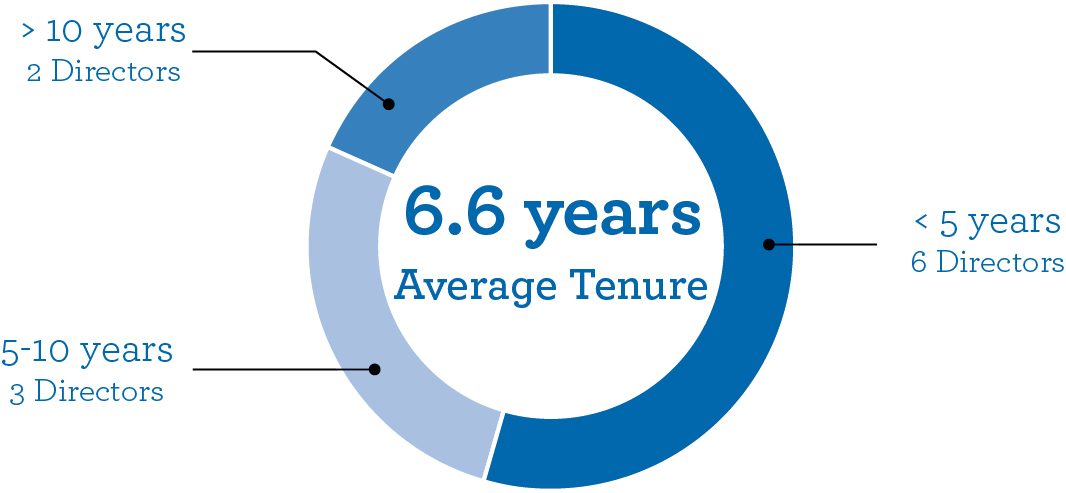
Talent DevelopmentEnterprise Risk Management, Information Protection and Succession Planning
Internal Audit functions. The topics covered by these reports include The Hartford's activities, policies and procedures to prevent, detect and respond to cybersecurity incidents, as well as lessons learned from cybersecurity incidents at other companies. From time to time, FIRMCo engages third party experts to gain an outside perspective on cybersecurity risk.
| 2018 Proxy Statement | 15 | |
| BOARD AND GOVERNANCE MATTERS | ||
| What we heard from shareholders | Board actions taken |
It is essential that boards have a strong lead independent director with clearly defined authorities and responsibilities | Amended The Hartford's Corporate Governance Guidelines to reflect the expanded responsibilities the Lead Director has assumed over the years (page 11) |
Boards, as part of their oversight of strategy, must ensure that management consider and communicate how environmental and social issues affect long-term strategy | Formed a Sustainability Governance Committee comprised of senior leaders to set and help drive execution of the company's sustainability strategy, with periodic reports up to the full Board (page 17) |
| It is important to bring fresh perspectives, new skills, and diversity to the boardroom, and boards should have discretion to decide how to promote refreshment | Adopted a policy that an independent director generally may not stand for reelection after serving as a director for 15 years in order to promote regular refreshment (page 18) |
The Board has four standing committees:company’s most senior roles, most recently in 2017, the Audit Committee;internal promotion of our new Chief Risk Officer, and expanded responsibilities for the Compensation and Management Development Committee;head of our Small Commercial business, who also assumed leadership for the Finance, Investment and Risk Management Committee; and the Nominating and Corporate Governance Committee. The Board has determined that all of the members of the Audit Committee, the Compensation and Management Development Committee and the Nominating and Corporate Governance Committee are "independent" directors within the meaning of the SEC's regulations, the listing standards of the NYSE and our Corporate Governance Guidelines. Each committee conducts a self-evaluation of its performance on an annual basis.
The current members of the Board and the committees on which they serve are identified below. The primary functions of each committee are as follows:
www.thehartford.com
14
Governance Practices and Framework
  | |||
| |||
|
| ||
The Hartford Financial Services Group, Inc.2015 Proxy Statement
15
Governance Practices and Framework
 | |||
| |||
|
| ||
www.thehartford.com
16
Governance Practices and Framework
The Board as a whole has ultimate responsibility for risk oversight. It exercises its oversight function through its standing committees, each of which has primary risk oversight responsibility for all matters within the scope of its charter. Annually, each committee reviews and reassesses the adequacy of its charter and the Nominating and Corporate Governance Committee reviews all charters and recommends any changes to the Board for approval. The table below provides examples of each committee's risk oversight responsibilities. For a more detailed description of each committee's responsibilities, see pages15-16.
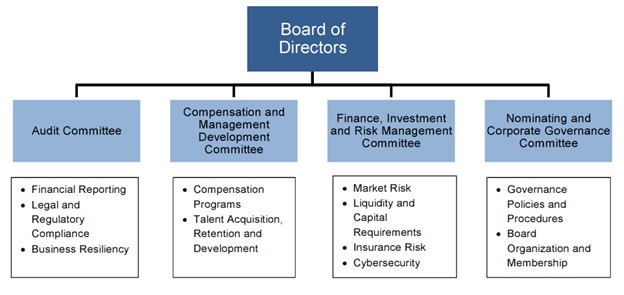
In addition to the risks identified above, the Finance, Investment and Risk Management Committee has responsibility for oversight of all risks that do not fall within the oversight responsibility of any other standing committee. In addition, the Audit Committee discusses with management policies with respect to risk assessment and risk management.
To assist it in discharging its oversight function, from time to time, the Board deems it advisable to form either a special committee or a working group to lead oversight of key strategic matters, with regular reports to the full board. Beginning in 2012, the Board established a Variable Annuity Working Group to review strategies for mitigating our variable annuity exposures. This group, consisting of Barry Allardice, Tom Renyi, Julie Richardson, Virginia Ruesterholz and Charles Strauss, met six times in 2014, was regularly briefed on the status of the Japan sales process and evaluated with management the offers received, culminating in the sale of the Japan annuity company. The evaluation included, among other things, an analysis of impacts of a sale and related accounting, purchase price adjustment mechanism and impact to the hedge program, as well as the regulatory approval process.
At the management level, we have established an Enterprise Risk and Capital Committee ("ERCC"), which manages our risk profile, capital structure and risk management practices. The ERCC reports to the Board primarily through the Finance, Investment and Risk Management Committee and also through interactions with the Audit Committee.
|
The Hartford Financial Services Group, Inc.2015 Proxy Statement
17
Governance Practices and Framework
|
Striving to do the right thing every day and in every situation is fundamental to our culture, and we are proud that we have been recognized seventen times, including in 2018, by The EthisphereEthisphere® Institute as one of the "World's“World’s Most Ethical Companies."” We have adopted a Code of Ethics and Business Conduct, which applies to all of our employees, including our principal executive officer, principal financial officer and principal accounting officer. We have also adopted a Code of Ethics and Business Conduct for Members of the Board of Directors (the “Board Code of Ethics”) and a Code of Ethics and Political Compliance. These codes require that all of our employees and directors engage in honest and ethical conduct in performing their duties, provide guidelines for the ethical handling of actual or apparent conflicts of interest, and provide mechanisms to report unethical conduct.
Directors certify compliance with the Board Code of Ethics annually.
Certain Relationships and Related Transactions
The Board has adopted a written Policy for the Review, Approval or Ratification of Transactions with Related Persons. This policy requires our directors and Section 16 executive officers to promptly disclose any actual or potential material conflict of interest to the Chairman of the Nominating and Corporate Governance Committee and the Chairman of the Board for evaluation and resolution. If the transaction involves a Section 16 executive officer or an immediate family member of a Section 16 executive officer, the matter must also be disclosed to our General Auditor or Director of Compliance for evaluation and resolution.
We did not have any transactions requiring review under this policy during 2014.
Shareholders and other interested parties may communicate with directors by contacting the Corporate Secretary at The Hartford Financial Services Group, Inc., One Hartford Plaza, Hartford, CT 06155. The Corporate Secretary will relay appropriate questions or messages to the directors. Only items related to the duties and responsibilities of the Board will be forwarded.
Anyone interested in raising a complaint or concern regarding accounting issues or other compliance matters directly with the Audit Committee may do so anonymously and confidentially by contacting EthicsPoint:
| 16 | www.thehartford.com |
www.thehartford.com
18
Governance Practices and Framework
BoardDiversity & Inclusion. We are committed to building an inclusive and Shareholder Meeting Attendance
The Board met 12 times during 2014engaging culture where people are respected for who they are, recognized for how they contribute and celebrated for growth and exceptional performance. We value the diversity of our employees' skills and life experiences and invest in their development so they can deliver on our strategy and propel our company forward.
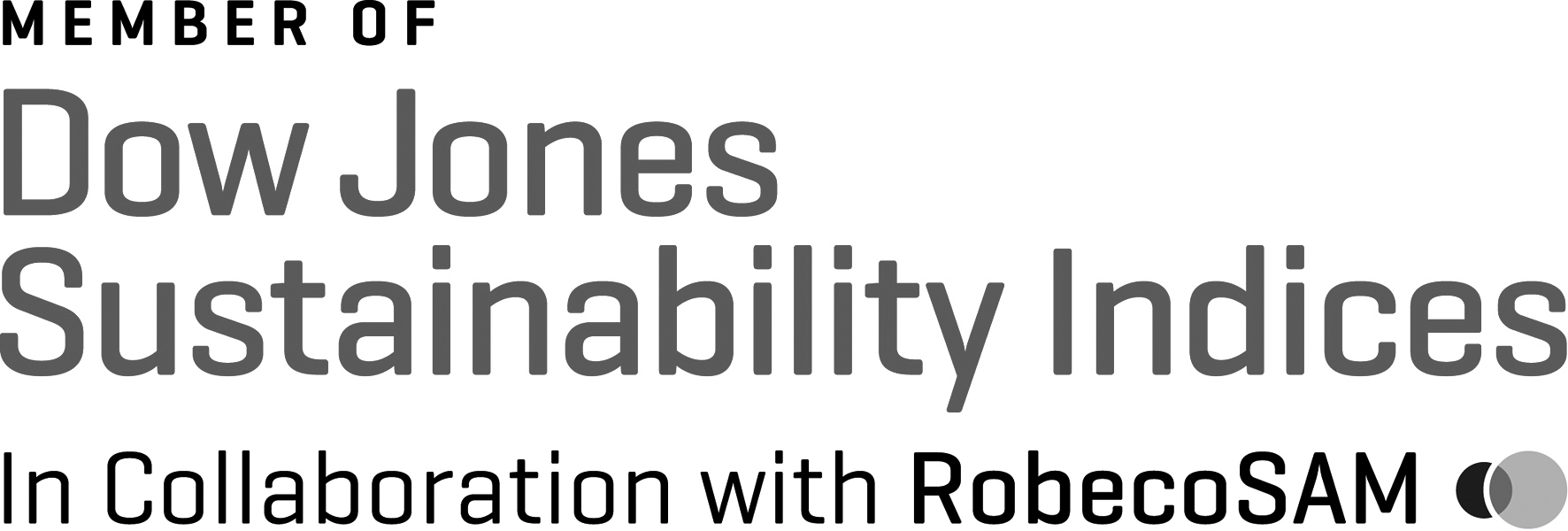 | Included in the Dow Jones Sustainability Indices in 2017 for the sixth year, one of only five U.S. insurers |
 | Participated in the CDP reporting process in 2017, publicly disclosing our progress toward environmental goals for the 10th year in a row; one of only four U.S. insurers to be featured in the Leadership category |
| Sustainability Governance | ||
In 2017, we took actions to improve our sustainability practices and enable the full Board to oversee ESG risks and opportunities that contribute to the long-term sustainability of the company: • First, we better defined the scope of ESG priorities at the company based, in part, on a materiality assessment we conducted in May, 2017, in which stakeholders (investors, employees, customers, community member and suppliers) were asked to identify and prioritize the ESG factors most important to them. •Second, we formed a Sustainability Governance Committee comprised of senior leaders to set and help drive execution of the company's sustainability strategy, which reports up to the full Board at least annually. The first such report was a deep dive on climate change and severe weather in February 2018, which, among other things, looked at (1) how the company is reducing its environmental impact; (2) how the company helps its customers reduce their environmental impact through its products, services and investments; and (3) how the company's Enterprise Risk Management function monitors and manages the risks associated with climate change and severe weather. | ||
| 2018 Proxy Statement | 17 | |
Criteria for Nomination to the Board of Directors and Diversity
| BOARD AND GOVERNANCE MATTERS | ||
•experience and its relevance to our business and objectives;
•financial and accounting expertise;
•ability to meet the required independence criteria and avoid conflicts of interest;
•personal and professional ethics, integrity and values; and
•availability to attend Board meetings and to devote appropriate time to preparation for such meetings.
In addition, the Nominating Committee considers the candidate's potential contribution to the diversity of the Board.
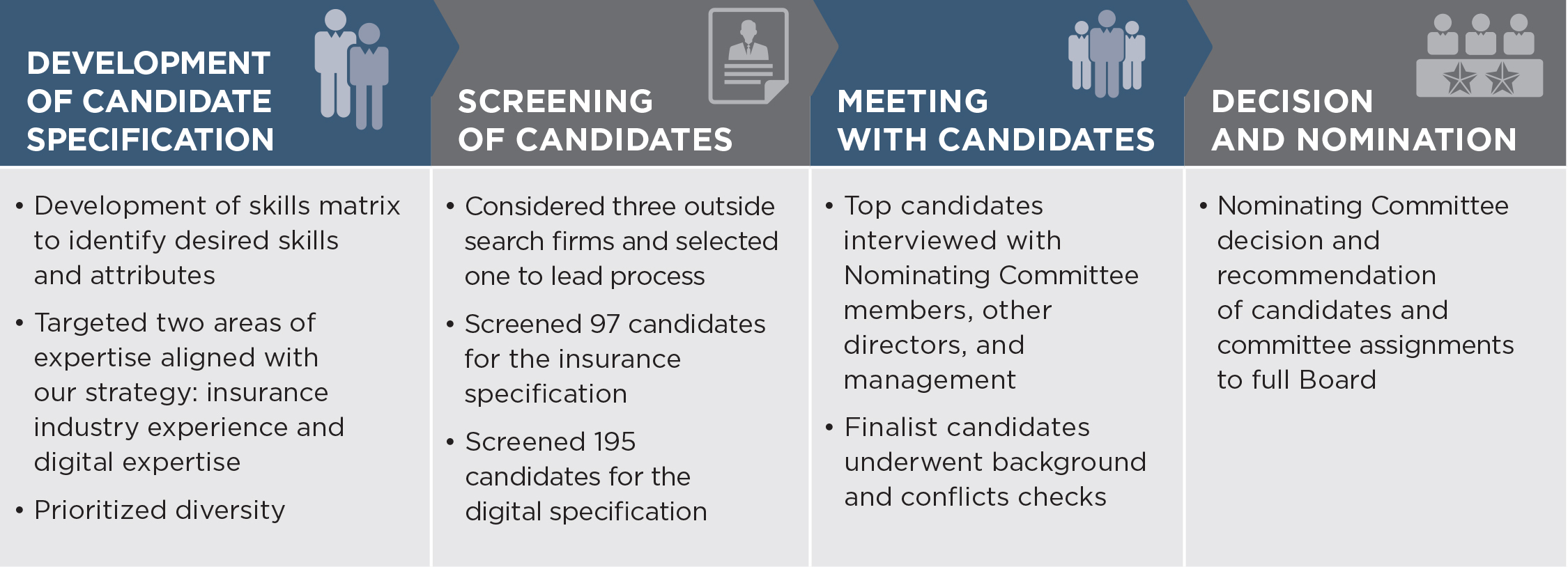
| • | Retirement Age.An independent director may not be nominated to stand for election or reelection to the Board after his or her 75th birthday, with limited exceptions for newly appointed directors over age 70, who may serve on the Board up to five years. |
| • | Tenure Policy.An independent director may not stand for reelection after serving as a director for 15 years.(1) |
| 18 | www.thehartford.com |
| BOARD AND GOVERNANCE MATTERS | ||
The Nominating Committee makes a recommendation As part of our continuing efforts to the full Board as to the persons who should be nominated by the Board, and the Board determines the nominees after considering the recommendation and report of the Nominating Committee.

New Director Appointed in 2015
As described above, the Nominating Committee devotes substantial time to identifying qualified director candidates who complement the skills and experiences of existing directors so that the full Board brings a range of competencies andbring diverse perspectives to the oversightBoard, since 2010 we have added four female directors. In 2016, two became chairs of our Audit Committee and Compensation Committee, significantly increasing female leadership on the Board.
| BOARD TENURE AND DIVERSITY | ||||
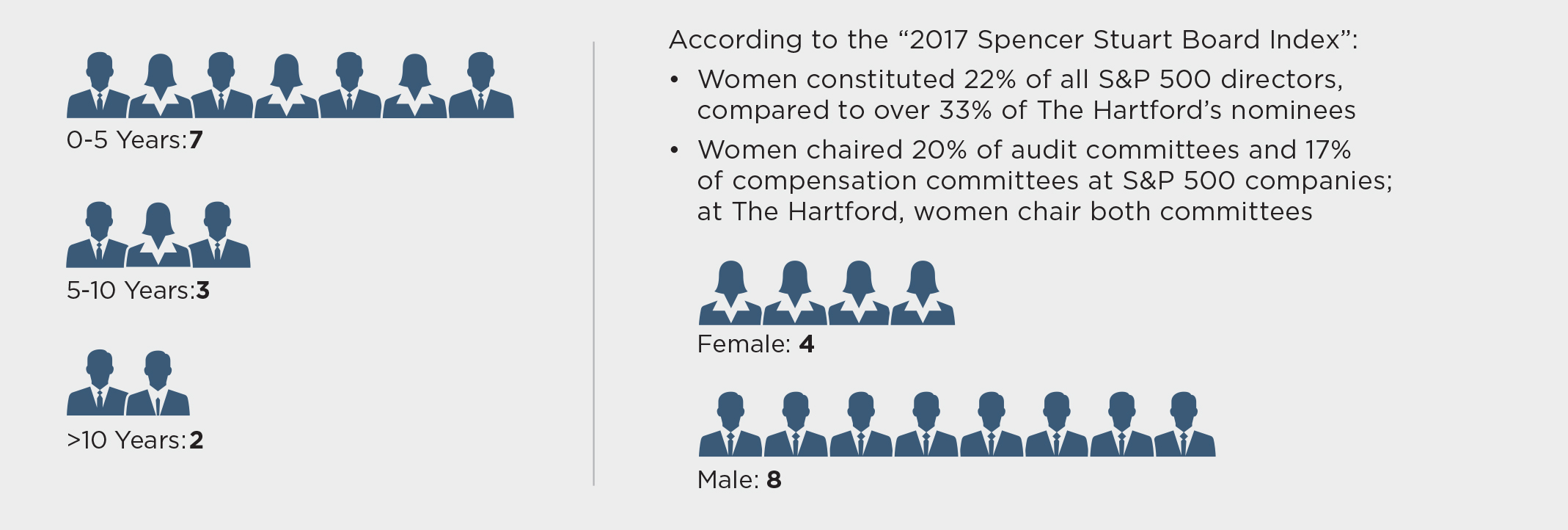 | ||||
The Hartford Financial Services Group, Inc.2015 Proxy Statement
19
Governance Practices and Framework
Shareholder Proposed Nominees
The Nominating Committee will consider director candidates recommended by shareholders using the same criteria described above. Shareholders may also directly nominate someone at an annual meeting. Nominations for director candidates are closed for 2015.2018. To recommendnominate a candidate forat our 20162019 Annual Meeting, shareholders must deliver or mail their nomination submission to Donald C. Hunt, Vice President and Corporate Secretary, The Hartford Financial Services Group, Inc., One Hartford Plaza, Hartford, CT 06155. Nominationsnotice must be received by our Corporate Secretary at the address below by February 19, 201615, 2019 and must include the information specified in our By-laws, including, but not limited to, the name of the candidate, together with a brief biography, an indication of the candidate'scandidate’s willingness to serve if elected, and evidence of the nominating shareholder'sshareholder’s ownership of our stock.
www.thehartford.com
20
| 2018 Proxy Statement | 19 | |
| BOARD AND GOVERNANCE MATTERS | ||
BackIn each case, submissions must be delivered or mailed to Contents
Director Compensation
Director Compensation
| 20 | www.thehartford.com |
| BOARD AND GOVERNANCE MATTERS | ||
stock units (“RSUs”).
below. In October 2016, following a market assessment, the Board increased the Nominating Committee Chair retainer from $10,000 to $15,000 and the Lead Director retainer from $25,000 to $35,000 to bring both retainers to market median levels effective for the 2017-2018 Board service year.
Annual Cash Compensation(1) | Director Compensation Program | |
| Annual Retainer | $100,000 | |
| Chair Retainer | $25,000 $25,000 $25,000 $ | |
| $ | ||
Talcott Resolution Board Working Group Stipend(2) | $10,000 | |
| (1) | Directors |
| (2) |
Directors receiving restricted stock may not sell, assign or otherwise dispose of it until the restriction period ends. For awards granted in 2014, the restriction period lapses on the earlier of (i) May 20, 2015, the last day of the 2014-2015 Board service year or (ii) the first anniversary of the grant date. To the extent any of the following events occur prior to the date upon which restrictions lapse, the restriction period will end with respect to all of the restricted stock currently held by a director: (i) the director's retirement at age 75, (ii) a "change of control" (as defined in the 2014 Incentive Stock Plan), (iii) the director's death, or (iv) the director's disability (as defined in the 2014 Incentive Stock Plan). In the event the director's Board service otherwise terminates prior to the lapse of the restriction period, the restricted stock will be forfeited if the Compensation and Management Development Committee, in its sole discretion, so determines.
For the 2015-2016 Board service year beginning on May 20, 2015, directors will be granted $160,000 in the form of restricted stock units ("RSUs") rather than restricted stock. These RSUs will vest at the end of the Board service year and will be distributed as common stock unless the director has elected to defer the distribution until the end of Board service.
Also for the 2015-2016 Board service year, directors may elect to defer all or part of the $100,000 annual Board cash retainer (and any Committee Chair or Presiding Director cash retainer) into RSUs, to be distributed as common stock following the end of the director's Board service.
The Hartford Financial Services Group, Inc.2015 Proxy Statement
21
Director Compensation
We provide each director with $100,000 of group life insurance coverage and $750,000 of accidental death and dismemberment and permanent total disability coverage while he or she serves on the Board. We also reimburse directors for travel and related expenses they incur in connection with their Board and committee service.
Stock Ownership Guidelines and Restrictions on Trading
Director Summary Compensation Table
| 2018 Proxy Statement | 21 | |
| BOARD AND GOVERNANCE MATTERS | ||
Name Fees Earned or
Paid in Cash ($)Stock Awards
($)(1)All Other
Compensation ($)Total ($) Robert Allardice(2) 151,000 160,000 1,878 312,878 Trevor Fetter 138,500 160,000 630 299,130 Paul G. Kirk(3) 12,000 - 1,384 13,384 Kathryn A. Mikells(4) 113,500 160,000 534 274,034 Michael G. Morris(4) 115,500 160,000 1,878 277,378 Thomas Renyi(2,4) 146,500 160,000 1,878 308,378 Julie G. Richardson(2,4,5) 150,400 216,300 624 367,324 Virginia P. Ruesterholz(2) 126,000 160,000 630 286,630 Charles B. Strauss(2) 150,500 160,000 2,826 313,326 H. Patrick Swygert 128,000 160,000 2,826 290,826
2017.
| Name | Fees Earned or Paid in Cash ($)(1) | Stock Awards ($)(2) | All Other Compensation ($) | Total ($) | |||||||
Robert Allardice(3) | 135,000 | 160,000 | 2,767 | 297,767 | |||||||
| Trevor Fetter | 135,000 | 160,000 | 811 | 295,811 | |||||||
Stephen P. McGill(4) | 41,700 | — | 312 | 42,012 | |||||||
| Kathryn A. Mikells | 100,000 | 160,000 | 271 | 260,271 | |||||||
| Michael G. Morris | 100,000 | 160,000 | 2,767 | 262,767 | |||||||
| Thomas Renyi | 100,000 | 160,000 | 2,767 | 262,767 | |||||||
Julie G. Richardson(3) | 135,000 | 160,000 | 571 | 295,571 | |||||||
| Teresa W. Roseborough | 100,000 | 160,000 | 811 | 260,811 | |||||||
Virginia P. Ruesterholz(3) | 135,000 | 160,000 | 811 | 295,811 | |||||||
Charles B. Strauss(3) | 125,000 | 160,000 | 2,767 | 287,767 | |||||||
| H. Patrick Swygert | 100,000 | 160,000 | 2,767 | 262,767 | |||||||
Greig Woodring(4) | 41,700 | — | 344 | 42,044 | |||||||
| (1) | Directors Fetter, Mikells and Renyi each elected to receive vested RSUs in lieu of cash compensation. Ms. Richardson elected to receive vested RSUs in lieu of $125,000 of her cash compensation; the remaining $10,000 stipend was paid to her in cash. The vested RSUs will be distributed as common stock following the end of the director's Board service. |
| (2) | These amounts |
| A $10,000 stipend for service in the |
www.thehartford.com
22
| 22 | www.thehartford.com |
Director Compensation
Director Compensation Table—Outstanding Equity
| BOARD AND GOVERNANCE MATTERS | ||
Stock Awards Name Stock
Grant DateNumber
of Shares or
Units of Stock
That Have Not
Vested (#)(1)Market Value
of Shares or
Units of Stock
That Have Not
Vested ($)Robert Allardice 8/1/2014 4,702 196,026 Trevor Fetter 8/1/2014 4,702 196,026 Kathryn A. Mikells 8/1/2014 4,702 196,026 Michael G. Morris 8/1/2014 4,702 196,026 Thomas Renyi 8/1/2014 4,702 196,026 Julie G. Richardson 8/1/2014 4,702 196,026 Virginia P. Ruesterholz 8/1/2014 4,702 196,026 Charles B. Strauss 8/1/2014 4,702 196,026 H. Patrick Swygert 8/1/2014 4,702 196,026
Stock Awards(1) | |||||||
| Name | Stock Grant Date(2) | Number of Shares or Units of Stock That Have Not Vested (#)(3) | Market Value of Shares or Units of Stock That Have Not Vested ($) | ||||
| Robert Allardice | 7/31/2017 | 2,921 | 164,394 | ||||
| Trevor Fetter | 7/31/2017 | 2,921 | 164,394 | ||||
Stephen P. McGill(4) | — | — | — | ||||
| Kathryn A. Mikells | 7/31/2017 | 2,921 | 164,394 | ||||
| Michael G. Morris | 7/31/2017 | 2,921 | 164,394 | ||||
| Thomas Renyi | 7/31/2017 | 2,921 | 164,394 | ||||
| Julie G. Richardson | 7/31/2017 | 2,921 | 164,394 | ||||
| Teresa W. Roseborough | 7/31/2017 | 2,921 | 164,394 | ||||
| Virginia P. Ruesterholz | 7/31/2017 | 2,921 | 164,394 | ||||
| Charles B. Strauss | 7/31/2017 | 2,921 | 164,394 | ||||
| H. Patrick Swygert | 7/31/2017 | 2,921 | 164,394 | ||||
Greig Woodring(4) | — | — | — | ||||
| (1) | Additional stock ownership information is set forth in the beneficial ownership table on page 63. |
| (2) | The RSUs were granted on July 31, 2017, the first day of the scheduled trading window following the filing of our Form 10-Q for the quarter ended June 30, 2017. |
| (3) | The number of RSUs of each award was determined by dividing $160,000 by $55.00, the closing price of our common stock as reported on the NYSE on the date of the award. The RSUs will vest on May 16, 2018, and will be distributed at that time in shares of the company’s common stock unless the director had previously elected to defer distribution of all or a portion of his or her annual RSU award until the end of Board service. Directors Fetter, Mikells, Renyi and Richardson have made elections to defer distribution of 100% of their RSU award. |
| (4) | Mr. McGill and Mr. Woodring each received a pro-rated restricted stock unit award valued at $66,700 on February 27, 2018, the first day of the Company’s scheduled trading window following the filing of the Company’s 2017 year-end report on Form 10-K. The number of RSUs subject to the award was determined by dividing the grant value ($66,700) by the closing market price per share of The Hartford common stock on the grant date of February 27, 2018. These awards will fully vest on the last day of the 2017-2018 Board year. Mr. McGill has elected to defer receipt of his RSU award until the end of his Board service. |
| BOARD AND GOVERNANCE MATTERS | ||
23
Director Nominees
| By internet | By telephone | By mail |
 |  |  |
Visit 24/7 www.ethicspoint.com | 1-866-737-6812 (U.S. and Canada) 1-866-737-6850 (all other countries) | The Hartford c/o EthicsPoint P.O. Box 230369 Portland, Oregon 97281 |
Director Nominees
| 24 | www.thehartford.com |
| BOARD AND GOVERNANCE MATTERS | ||
| Experience / Qualification | Relevance to The Hartford |
| Leadership | Experience in significant leadership positions provides us with |
| Insurance and Financial Services | Extensive experience in the insurance and financial services |
| Digital/Technology | Digital and technology expertise is important in light of the speed of digital progress and the development of disruptive technologies both in the insurance industry and more broadly. |
| Corporate Governance | An understanding of organizations and governance supports management accountability, transparency and protection of shareholder interests. |
| Risk Management | Risk management experience is critical in overseeing the risks we face today and those emerging risks that could present in the future. |
| Finance and Accounting | Finance and accounting experience is important in understanding and reviewing our business operations, strategy and financial results. |
| Business Operations and Strategic Planning | An understanding of |
| An understanding of | |
www.thehartford.com
24
| 2018 Proxy Statement | 25 | |
Director Nominees
| BOARD AND GOVERNANCE MATTERS | ||
| ROBERT B. ALLARDICE, III | ||
 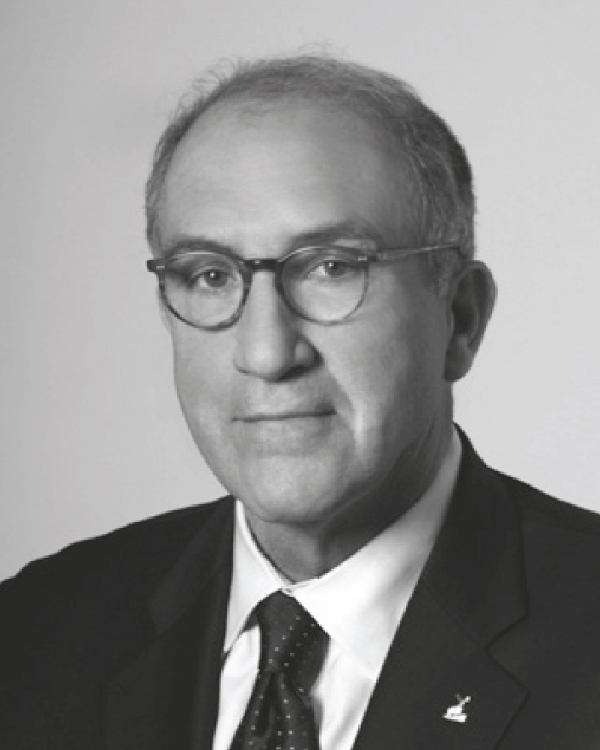 | 71 |
|

| CARLOS DOMINGUEZ | |
 | Age:59 Director since: 2018 Independent Committees: Management; Nominating and Corporate Governance Other Public Company Directorships: Medidata Solutions, Inc. (2008-present) Skills and Qualifications Relevant to The Hartford: Mr. Dominguez has more than 30 years of enterprise technology experience. He brings to the Board extensive and relevant digital expertise as the company focuses on data analytics and digital capabilities to continuously improve the way it operates and delivers value to customers. As president and chief operating officer of Sprinklr, Inc., Mr. Dominguez guides strategic direction and leads the marketing, sales, services, and partnerships teams for a leading social media management company. Prior to joining Sprinklr, he spent seven years as a technology representative for the chairman and CEO of Cisco Systems, Inc. In this role, Mr. Dominguez engaged with senior executives in the Fortune 500 and government leaders worldwide, sharing insights on how to leverage technology to enhance and transform their businesses. In addition, he led the creation and implementation of Cisco's Innovation Academy that delivered innovation content to Cisco employees globally. |

| 26 | www.thehartford.com |

| BOARD AND GOVERNANCE MATTERS | ||
| TREVOR FETTER | ||
 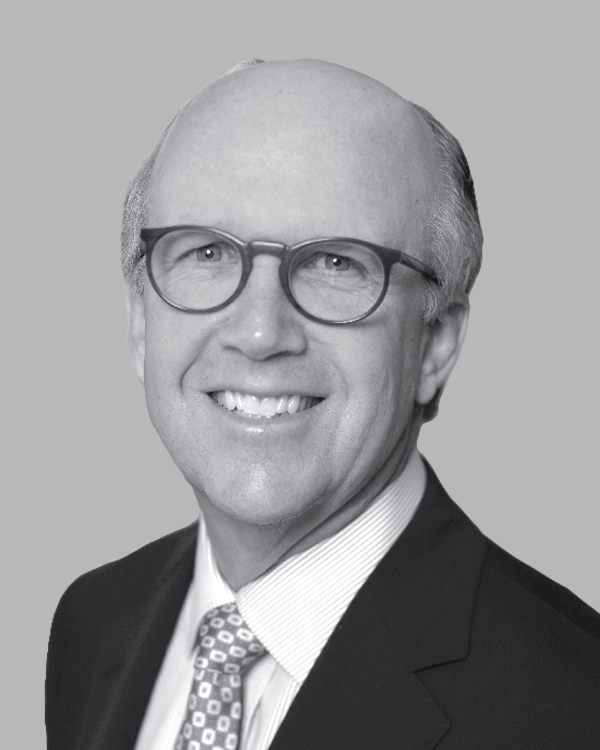 | 58 |
|

| STEPHEN P. McGILL | ||
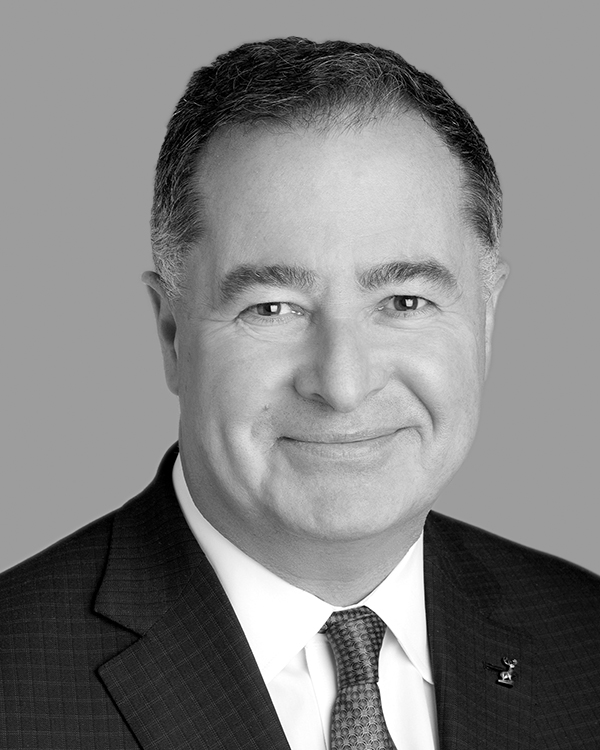 | Age: 60 Director since: 2017 Independent Committees: Compensation and Management Development; Finance, Investment and Risk Management Other Public Company Directorships: None Skills and Qualifications Relevant to The Hartford: Mr. McGill has over 25 years of insurance industry experience. With his deep understanding of the insurance industry, Mr. McGill brings significant and relevant risk management, regulatory and business expertise to the Board. As the leader of an international risk management and reinsurance brokerage, Mr. McGill is able to provide the Board with insights into complex distribution channels, what it takes to succeed in the marketplace, and profitably grow the company’s businesses. In addition, Mr. McGill brings an international perspective to the Board. He serves on the International Advisory Board of British American Business, and is past president of the Insurance Institute of London. In 2014, Mr. McGill was awarded a Commander of the British Empire (CBE) by Queen Elizabeth II in recognition for his exceptional service to the insurance industry and also for humanitarian services. | |


The Hartford Financial Services Group, Inc.2015 Proxy Statement
25
| 2018 Proxy Statement | 27 | |
Director Nominees
| BOARD AND GOVERNANCE MATTERS | ||
| KATHRYN A. MIKELLS | ||
 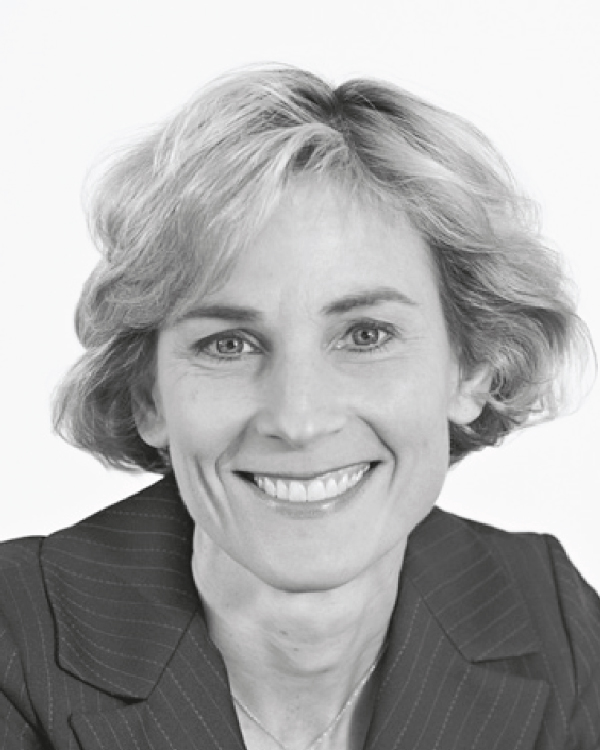 | 52 |
|


| MICHAEL G. MORRIS | ||
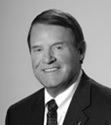 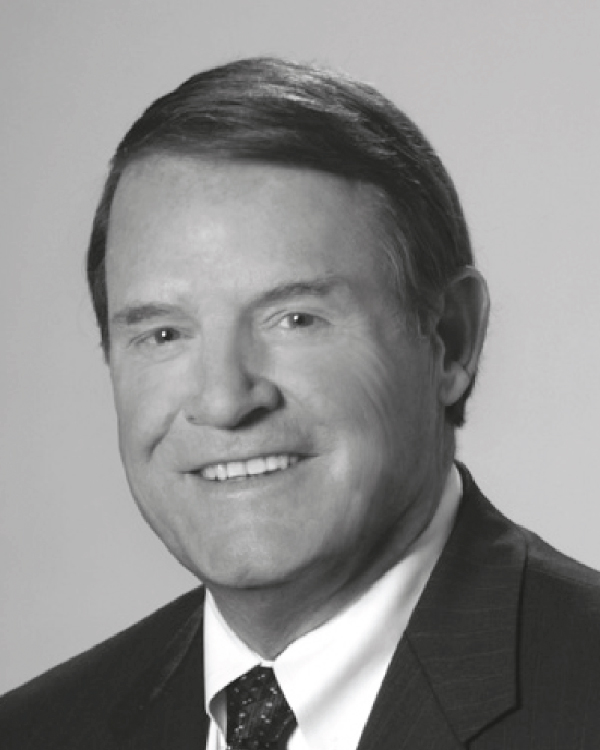 | 71 |
|

| |
| 28 | www.thehartford.com |

www.thehartford.com
26
Director Nominees
| BOARD AND GOVERNANCE MATTERS | ||
| THOMAS A. RENYI | ||
  | 72 |
|

| |

| JULIE G. RICHARDSON | ||
  | 54 |
|

| ||
| 2018 Proxy Statement | 29 | |

The Hartford Financial Services Group, Inc.2015 Proxy Statement
27
Director Nominees
| BOARD AND GOVERNANCE MATTERS | ||
| TERESA WYNN ROSEBOROUGH | ||
  | 59 |
|

| VIRGINIA P. RUESTERHOLZ | ||
 | Age: 56 Director since: 2013 Independent Committees:Compensation andManagement Development (Chair); Finance,Investment and Risk Management; Nominating and Corporate Governance Other Public Company Directorships: | |

Frontier CommunicationsCorporation (2013-present); Bed Bath & Beyond Inc. (2017-present) |
|
Ms. Ruesterholz has held a variety of senior executive positions, including as Executive Vice President at Verizon Communications and President of the former Verizon Services Operations.
|

| |
| 30 | www.thehartford.com |

www.thehartford.com
28
Director Nominees
| BOARD AND GOVERNANCE MATTERS | ||
 |
|
|
| ||

| CHRISTOPHER J. SWIFT | ||
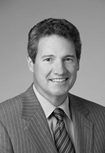  | 57 |
|

| |
| GREIG WOODRING | |
 | Age:66 Director since:2017 Committees: Audit; Finance, Investment and Risk Management Other Public Company Directorships: Reinsurance Group of America, Incorporated (1993-2016); Sun Life Financial Inc. (Jan. - April 2017) Skills and Qualifications Relevant to The Hartford: Mr. Woodring brings significant and valuable insurance industry and leadership experience to the Board, demonstrated by his more than two decades leading Reinsurance Group of America, Incorporated (RGA), a leading life reinsurer with global operations. During his tenure, RGA grew to become one of the world’s leading life reinsurers, with offices in 26 countries and annual revenues of more than $10 billion. Mr. Woodring has demonstrated skills in areas that are relevant to the oversight of the company, including risk management, finance, and operational expertise. Mr. Woodring serves as chairman of the International Insurance Society, and is a fellow of the Society of Actuaries and a member of the American Academy of Actuaries. |

| 2018 Proxy Statement | 31 | |
| ITEM 2 | ||

The Hartford Financial Services Group, Inc.2015 Proxy Statement
29
Director Nominees
| RATIFICATION OF THE APPOINTMENT OF INDEPENDENT REGISTERED PUBLIC ACCOUNTING FIRM | ||||
 The Board recommends that shareholders vote “FOR”the ratification of the appointment of Deloitte & ToucheLLP as our independent registered public accounting firmfor the fiscal year ending December 31, 2018 The Board recommends that shareholders vote “FOR”the ratification of the appointment of Deloitte & ToucheLLP as our independent registered public accounting firmfor the fiscal year ending December 31, 2018 | ||||
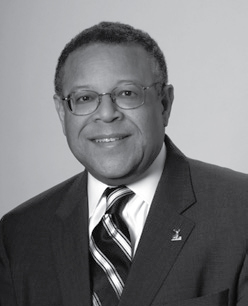 |
|
In selecting D&T for fiscal year 2018, the Audit Committee carefully considered, among other items: •the professional qualifications of D&T, the lead audit partner and •D&T’s depth of understanding of the company’s businesses, accounting policies and practices andinternal control over financial reporting; •D&T’s quality controls and its processes for maintaining independence; and •the appropriateness of D&T’s fees for audit and non-audit services. The Audit Committee oversees and is ultimately responsible for the outcome of audit fee negotiations associated with
Although shareholder ratification of the Representatives of D&T will attend the Annual Meeting, will have the opportunity to make a statement if they desire to do so, and will be available to respond to appropriate questions. | ||
| ||||

www.thehartford.com
30
Election of Directors
Item 1 Election of Directors
The Nominating Committee believes that the director nominees possess qualifications, skills and experience that are consistent with the standards for the selection of nominees for election to the Board set forth in our Corporate Governance Guidelines described on page24 and that they have demonstrated the ability to effectively oversee The Hartford's corporate, investment and business operations. Biographical information for each director nominee is set forth above, including the principal occupation and other public company directorships (if any) held in the past five years and a description of the specific experience and expertise that qualifies each nominee to serve as a director of The Hartford.
The Board recommends that shareholders vote "FOR" all nominees for election as directors.
The Hartford Financial Services Group, Inc.2015 Proxy Statement
31
Audit Matters
Audit Matters

www.thehartford.com
32
Report of the Audit Committee
Report of the Audit Committee
The Audit Committee oversees The Hartford's financial reporting process on behalf of the Board. Management has the primary responsibility for establishing and maintaining adequate internal financial controls, for preparing the financial statements and for the public reporting process. Deloitte & Touche LLP ("D&T"), our independent registered public accounting firm for 2014, is responsible for expressing opinions that (1) our consolidated financial statements present fairly, in all material respects, the financial position, results of operations and cash flows in conformity with generally accepted accounting principles and (2) we maintained, in all material respects, effective internal control over financial reporting as of December 31, 2014.
In this context, the Audit Committee has:
(1) reviewed and discussed the audited financial statements for the year ended December 31, 2014 with management;
(2) discussed with D&T the matters required to be discussed by Public Company Accounting Oversight Board ("PCAOB") Auditing Standard No. 16, Communications with Audit Committees; and
(3) received the written disclosures and the letter from D&T required by applicable requirements of the PCAOB regarding the independent accountant's communications with the Audit Committee concerning independence, and has discussed with D&T the independent accountant's independence.
Based on the review and discussions described in this report, the Audit Committee recommended to the Board that the audited financial statements should be included in the company's Annual Report on Form 10-K for the fiscal year ended December 31, 2014 for filing with the SEC.
Report Submitted: February 25, 2015
Members of the Audit Committee:
Robert B. Allardice, III, ChairmanMichael G. MorrisJulie G. RichardsonVirginia RuesterholzCharles B. Strauss
Fees of the Independent Registered Public Accounting Firm
The following table presents fees for professional services provided by D&T, the member firms of Deloitte Touche Tohmatsu, and their respective affiliates (collectively, the "Deloitte Entities"“Deloitte Entities”) for the years ended December 31, 20142017 and 2013.
Year Ended
December 31, 2014Year Ended
December 31, 2013Audit fees $ 15,188,000 $ 16,205,000 Audit-related fees(1) 1,048,000 1,018,000 Tax fees(2) 1,070,000 307,000 All other fees(3) 134,000 690,000 Total $ 17,440,000 $ 18,220,000
2016.
| Year Ended December 31, 2017 | Year Ended December 31, 2016 | ||||||
| Audit fees | $ | 13,881,000 | $ | 14,457,000 | |||
Audit-related fees(1) | $ | 1,356,000 | $ | 591,000 | |||
Tax fees(2) | $ | 184,000 | $ | 474,000 | |||
All other fees(3) | $ | — | $ | 69,000 | |||
| Total | $ | 15,421,000 | $ | 15,591,000 | |||
| (1) | Fees for the years ended December 31, |
| (2) | Fees for the years ended December 31, |
| (3) | Fees for the |
The Hartford Financial Services Group, Inc.2015 Proxy Statement
33
| 32 | www.thehartford.com |
Audit Committee Pre-Approval Policies and Procedures
Audit Committee Pre-Approval Policies and Procedures
| AUDIT MATTERS | ||
At the beginning of the year, the
www.thehartford.com
34
RatificationThe Audit Committee currently consists of Independent Public Accounting Firm
Item 2 Ratificationsix independent directors, each of whom is “financially literate” within the meaning of the Appointmentlisting standards of Independent Registered Public Accounting Firm
Consistent with SEC policiesthe NYSE. Directors Richardson, Allardice, Mikells, Morris and in accordance with its Board-approved charter,Strauss are “audit committee financial experts” within the meaning of the SEC’s regulations. The Audit Committee oversees The Hartford's financial reporting process on behalf of the Board. Management has appointedthe primary responsibility for establishing and maintaining adequate internal financial controls, for preparing the financial statements and for the public reporting process. Deloitte & Touche LLP as(“D&T”), our independent registered public accounting firm for 2017, is responsible for expressing opinions that (1) our consolidated financial statements present fairly, in all material respects, the fiscal year endingfinancial position, results of operations and cash flows in conformity with generally accepted accounting principles and (2) we maintained, in all material respects, effective internal control over financial reporting as of December 31, 2015. Prior to2017.
| (1) | reviewed and discussed the audited financial statements for the year ended December 31, 2017 with management; |
| (2) | discussed with D&T the matters required to be discussed by Public Company Accounting Oversight Board (“PCAOB”) Auditing Standard No. 1301, Communications with Audit Committees; and |
| (3) | received the written disclosures and the letter from D&T required by applicable requirements of the PCAOB regarding the independent accountant’s communications with the Audit Committee concerning independence, and has discussed with D&T the independent accountant’s independence. |
Although shareholder ratification of the appointment of Deloitte & Touche LLP is not required, the Board requests ratification ofdiscussions described in this appointment by the shareholders. If shareholders fail to ratify the selection,report, the Audit Committee will reconsider whether or notrecommended to retain Deloitte & Touche LLP.
Representatives of Deloitte & Touche LLP will attend the Board that the audited financial statements should be included in the company’s Annual Meeting, will have the opportunity to make a statement if they desire to do so, and will be available to respond to appropriate questions.
The Board recommends that shareholders vote "FOR" the ratification of the appointment of Deloitte & Touche LLP as our independent registered public accounting firmReport on Form 10-K for the fiscal year endingended December 31, 2015.
The Hartford Financial Services Group, Inc.2015 Proxy Statement
35
| 2018 Proxy Statement | 33 | |
Compensation Matters
Compensation Matters
| ITEM 3 | ||
| ADVISORY APPROVAL OF 2017 COMPENSATION OF NAMED EXECUTIVE OFFICERS |  The Board recommends that shareholders vote “FOR” thebelow resolution to approve our compensation of namedexecutive officers as disclosed in theCompensation Discussionand Analysis, the compensation tables and the narrativediscussion contained in this proxy statement. The Board recommends that shareholders vote “FOR” thebelow resolution to approve our compensation of namedexecutive officers as disclosed in theCompensation Discussionand Analysis, the compensation tables and the narrativediscussion contained in this proxy statement. | |
Section 14A of the Securities Exchange Act of 1934, as amended, provides our shareholders with the opportunity to vote to approve, on an advisory basis, the compensation of our NEOs as disclosed in this proxy statement in accordance with the rules of the SEC. We currently intend to hold these votes on an annual basis. As described in detail in the Compensation Discussion and Analysis beginning on page 35, our executive compensation program is designed to promote long-term shareholder value creation and support our strategy by: (1) encouraging profitable growth consistent with prudent risk management, (2) attracting and retaining key talent, and (3) appropriately aligning pay with short- and long-term performance. The advisory vote on this resolution is not intended to address any specific element of compensation; rather, it relates to the overall compensation of our NEOs, as well as the philosophy, policies and practices described in this proxy statement. You have the opportunity to vote for, against or abstain from voting on the following resolution relating to executive compensation: RESOLVED, that the shareholders approve, on an advisory basis, the compensation of the named executive officers, as disclosed pursuant to the compensation disclosure rules of the Securities and Exchange Commission, including the Compensation Discussion and Analysis, the compensation tables and the narrative discussion contained in this proxy statement. Because the required vote is advisory, it will not be binding upon the Board. The Compensation Committee will, however, take into account the outcome of the vote when considering future executive compensation arrangements. | ||

www.thehartford.com
36
| 34 | www.thehartford.com |
Compensation Discussion and Analysis
Compensation Discussion and Analysis
| COMPENSATION MATTERS | ||
| Name | Title |
| Christopher Swift | Chairman and Chief Executive Officer |
| Beth Bombara | Executive Vice President and Chief Financial Officer |
| Douglas Elliot | President |
| Brion Johnson | Executive Vice President and Chief Investment Officer; President of HIMCO and Talcott Resolution |
| William Bloom | Executive Vice President, Operations, Technology & Data |
| Robert Rupp | Former Executive Vice President and Chief Risk Officer |
Beginning in 2012, we launched a multi-year strategy to transform from a diversified financial services company to one focused on our Property & Casualty ("P&C"), Group Benefits,annuity run-off business; the acquisition of Aetna Inc.'s U.S. group life and Mutual Funds businesses. We generated significant capital benefits throughdisability business; and the salestransfer of 29% of our Individual Life and Retirement Plans businesses, and stopped selling new annuity policies, a business that had contributedoutstanding pension liabilities to our stock price volatility in recent years. Most recently, we sold our U.K. and Japan life subsidiaries in December 2013 and June 2014, respectively. The Japan sale was particularly important to our strategy, as it permanently eliminated what was the most volatile portion of our annuity book of business.
Using OurPrudential Financial, Strength to Return Capital to Our Shareholders
In 2014 we improved profitability. Core earnings expanded in P&C, Group Benefits and Mutual Funds. In addition, written premiums and underwriting margin increased in P&C, core earnings after-tax margin improved in Group Benefits and sales remained strong in Mutual Funds. Our increased financial flexibility has allowed us to invest in technology to enhance our competitiveness and the quality of our customer experience, and to take significant actions to return capital to our shareholders. In February 2014 we announced a 2014-2015 equity and debt capital management plan totaling $2.656 billion. The sale of our Japan life subsidiary allowed us to increase the capital management plan in July 2014, bringing the total authorization for the 2014-2015 period to approximately $4 billion, including $2.775 billion for equity repurchases and $1.156 billion in debt reduction. In 2014, we executed share repurchases of approximately $1.8 billion, increased our quarterly common stock dividend by 20% to $0.18 per share and repaid $200 million of debt.
Transitioning to New Leadership
We underwent a significant leadership transition in 2014. The Board appointed a new executive management team following Liam McGee's decision in June to step down as CEO and President. All members of the new leadership team were internal candidates, a testament to the strength of the Board's succession planning. The new leadership team had also been instrumental in developing and executing our strategy, enabling a smooth transition.
Focusing on the Future
Following the Japan sale and the successful leadership transition, we view our transformation as essentially complete, and we are focused on the future. Our primary objectives are to improve return on equity and grow book value per share to drive top quartile shareholder returns. While there is still work to be done, the Board and management are pleased with the progress we made in 2014.
Key Accomplishments in 2014
Inc.
| Announced Agreement to Sell Talcott Resolution | Acquired Aetna's U.S. Group Life and Disability Business | Reduced Pension Liabilities by $1.6 Billion | ||
• Sale will complete our exit of individual life and annuity run-off business • Expected to improve future return on equity ("ROE") and earnings growth profile and enhance financial flexibility • Provides $2.7 billion of value to shareholders • Resulted in a net loss on discontinued operations of approximately $2.9 billion | • Makes us the second largest group life and disability insurer in the U.S.(1) • Increases operating scale and enhances analytical and claims capabilities • Included industry-leading claims and administration technology, which will enhance the experience we deliver to customers • Enhances The Hartford's distribution footprint | • Reduces our long-term pension obligations and exposure to potential future volatility • Entrusts the pension benefits of approximately 16,000 former employees to a highly-rated, experienced retirement benefits provider in the industry • Ensured uninterrupted service and processing • Resulted in a $488 million charge after tax | ||
| 2018 Proxy Statement | 35 | |
| COMPENSATION MATTERS | ||
| Commercial Lines | • Combined ratio of 97.3 was higher than plan, primarily due to higher catastrophe losses | |||||
| • Underlying combined ratio* of 92.0 was modestly higher than plan, primarily due to higher expenses | ||||||
| • Combined ratio of 104.2 was higher than plan due to higher catastrophe losses | ||||||
| • Underlying combined ratio of 93.0 was favorable to plan due to profitability improvement initiatives | ||||||
| • Net income and core earnings margin* were 7.2% and 5.8% respectively, both exceeding plan | ||||||
| • Acquired Aetna's U.S. group life and disability business, making The Hartford the second largest group life and disability insurer in the U.S. | ||||||
| • Net income was $106 million, exceeding plan | ||||||
| • Total assets under management increased 18% over 2016, driven by market appreciation and positive net flows | ||||||
| • Total P&C net investment income before tax was $1,196 million, reflecting returns on limited partnerships and other alternative investments well ahead of plan | ||||||
•
|
|
|
| |||
* Combined ratio, excluding catastrophes and prior year loss reserve development for P&C; after-tax core earnings margin for Group Benefits
The Hartford Financial Services Group, Inc.2015 Proxy Statement
37
Compensation Discussion and Analysis
Delivering Superior Shareholder Returns
Strong financial performance, a significantly improved risk profileAs we enter 2018, we are focused on the successful integration of the Aetna acquisition and the financial flexibility to return capital to shareholders while continuing to investseparation and sale of Talcott Resolution, as well as the continued investment in our businesses has helped drive superiorfor long-term growth and shareholder returns. In 2014, we outperformed relevant benchmarks, including the S&P 500, S&P 500 P&C and S&P Insurance Composite indices, as illustrated on the right. We significantly outperformed these indices over three years as well. The chart below illustrates our performance,value creation. Management and the transformative actionsBoard are confident that we have taken, beginningare taking the right steps to continue to drive profitable growth, with an improved risk, earnings growth and ROE profile due in 2012.
One-Yearlarge part to our strategic accomplishments in 2017.

Three-Year Total Shareholder Return and Key Management Actions*

*Timeline not to scale.
**Total capital management plan authorization for 2014-2015: $2.775 billion in equity repurchases; $1.156 billion in debt reduction; and 20% increase to quarterly dividend.
During the year the company repurchased 20.2 million common shares for $1.0 billion, repaid $416 million of senior debt at maturity, declared a 9% increase in the quarterly dividend to $0.25 per common share and paid $341 million of common dividends. The following chart shows The Hartford’s total shareholder returns ("TSR") relative to the S&P 500, S&P 500 Insurance Composite, and S&P P&C indices. | 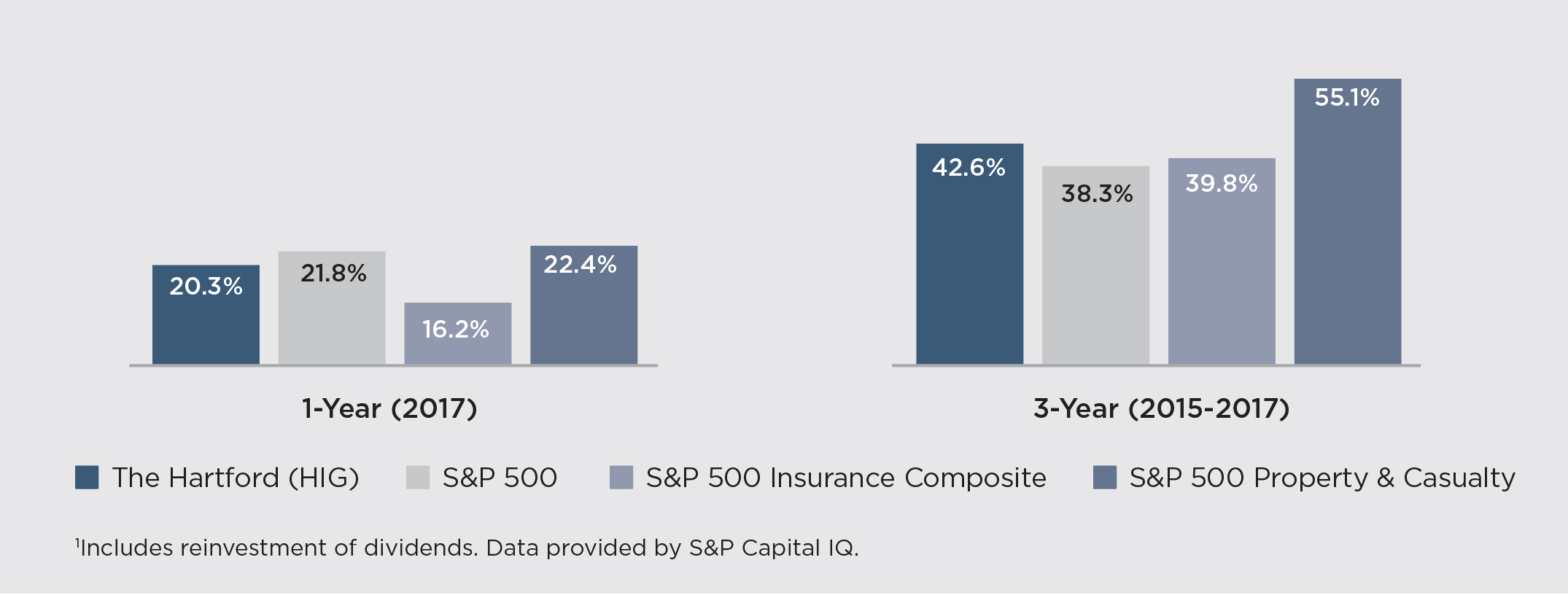 |
www.thehartford.com
38
| 36 | www.thehartford.com |
Compensation Discussion and Analysis
2014 Compensation Highlights
| COMPENSATION MATTERS | ||
The table below reflects the 2014 compensation package (base salary, AIP award and long-term incentive ("LTI") award) for each active NEO. Although this table is not a substitute for the Summary Compensation Table information beginning on page55, we believe it provides a simple and concise picture of compensation decisions made for the active NEOs in 2014.
Compensation Component C. Swift B. Bombara D. Elliot B. Johnson R. Rupp Base Salary Rate(1) $ 1,000,000 $ 625,000 $ 900,000 $ 500,000 $ 600,000 2014 AIP Award $ 2,139,000 $ 1,350,000 $ 1,800,000 $ 1,450,000 $ 1,600,000 2014 LTI Award(2) $ 2,200,000 $ 1,000,000 $ 2,000,000 $ 1,100,000 $ 1,400,000 Total 2014 Compensation Package(3) $ 5,339,000 $ 2,975,000 $ 4,700,000 $ 3,050,000 $ 3,600,000
Shareholder Engagement and "Say-on-Pay" Results
In the fall of 2014, as part of the annual shareholder outreach program we began in 2011, management engaged with shareholders representing over 40% of shares outstanding to discuss the 2014 "Say-on-Pay" vote and other important compensation and governance matters. At last year's Annual Meeting, shareholders voted 80% in favor of our "Say-on-Pay" proposal. This is a lower level of support than we have received in the past which, based on discussions with shareholders, we believe reflects, in part, shareholder reaction to special equity awards granted to certain of our Senior Executives in October 2013. No such awards were made in 2014. Shareholder feedback is shared with the Compensation Committee and the Nominating and Corporate Governance Committee and provides a deeper understanding of voting results.
In general, the feedback received was positive and most of the shareholders we engaged with:
•Supported re-combining the roles of Chairman and CEO, provided the Board maintains a strong independent presiding director role;
•Validated the Compensation Committee's use of qualitative factors to adjust the formulaic AIP funding factor so long as any adjustment is reasonable and thoroughly explained;
•Expressed a desire for robust disclosure of talent development, succession planning and director skills and qualifications; and
•Confirmed that our compensation and governance policies and practices were generally sound and aligned with shareholders' interests.
The Hartford Financial Services Group, Inc.2015 Proxy Statement
39
Compensation Discussion and Analysis
Each year, the Compensation Committee takes the results of the Say-on-Pay vote and the shareholder engagement program into consideration as it makes compensation decisions. Many elements of our 2014 compensation plan design are directly responsive to feedback we have received from shareholders:.
Overview of Compensation Program
Our executive compensation program is designed to promote long-term shareholder value creation and support our strategy by: (1) encouraging profitable growth consistent with prudent risk management, (2) attracting and retaining key talent, and (3) appropriately aligning pay with short- and long-term performance.
| Compensation Component | C. Swift | B. Bombara | D. Elliot | B. Johnson | W. Bloom | ||||||||||||||
| Base Salary Rate | $ | 1,100,000 | $ | 700,000 | $ | 925,000 | $ | 525,000 | $ | 550,000 | |||||||||
| 2017 AIP Award | $ | 4,675,000 | $ | 1,900,000 | $ | 3,150,000 | $ | 2,300,000 | $ | 1,575,000 | |||||||||
| 2017 LTI Award | $ | 7,500,000 | $ | 1,750,000 | $ | 5,000,000 | $ | 1,500,000 | $ | 1,000,000 | |||||||||
| Total 2017 Compensation Package | $ | 13,275,000 | $ | 4,350,000 | $ | 9,075,000 | $ | 4,325,000 | $ | 3,125,000 | |||||||||
| 2017 Compensation Decision | Rationale |
| The Compensation Committee approved an AIP funding level of 170% of target. | Performance against pre-established Compensation Core Earnings targets resulted in a formulaic AIP funding level of 183% of target. The Compensation Committee reduced this funding level to 170% based on certain qualitative factors, including quality of P&C earnings (excluding catastrophes), which, while strong in a very competitive market, were relatively flat to budget. (page 44) |
| The Compensation Committee certified a 2015-2017 performance share award payout at 104% of target. | The company's TSR during the performance period was at the 40th percentile relative to 18 peer companies, resulting in a payout of 75% of target for the TSR component (50% of the award). The company's average annual Compensation Core ROE during the performance period was 9.4%, resulting in a payout of 134% of target for the ROE component (50% of the award). (page 47) |
| As a result of the December 3, 2017 agreement to sell the Talcott Resolution business, the Compensation Committee took actions to ensure that Talcott Resolution core earnings through September 30, 2017 were included in the determination of the AIP funding level and ROE results for performance shares. | Upon signing an agreement to sell Talcott Resolution, GAAP accounting required that financial results from the business be reclassified as discontinued operations, which are excluded from core earnings. The Compensation Committee determined that including Talcott Resolution core earnings for the period in which management was both actively managing the business and separately reporting its results externally was appropriate. In addition, AIP and performance share targets were established assuming Talcott Resolution operating results were included in the business mix. (page 44) |
| The Compensation Committee excluded the results of the group life and disability business acquired from Aetna on November 1, 2017 in determining the 2017 AIP funding level. | While including the results of the acquired business would have slightly increased the 2017 AIP funding level, the Compensation Committee determined that excluding them was appropriate based upon overall immateriality, and because the results of the business were not part of the business mix when the AIP target was established. (page 44) |
| “SAY-ON-PAY” RESULTS | 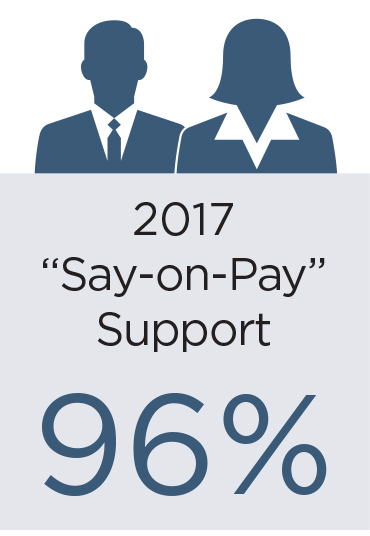 | |
| At last year’s Annual Meeting, shareholders voted 96% in favor of our “Say-on-Pay” proposal. The Compensation Committee considered the vote to be an endorsement of The Hartford’s executive compensation programs and policies, and took this strong level of support into account in reviewing those programs and policies. Management also discussed the vote, along with aspects of its executive compensation, sustainability and corporate governance practices, during our annual shareholder outreach program to gain a deeper understanding of shareholders’ perspectives. | ||
| 2018 Proxy Statement | 37 | |
The Compensation Committee regularly reviews
| COMPENSATION MATTERS | ||
| What We Do | |||
| ✓ | Approximately | ||
| ✓ | Senior Executives are eligible for the same benefits as full-time employees generally, including health, life insurance, disability and retirement benefits | ||
| ✓ | |||
| ✓ | Double trigger requirement for | ||
| ✓ | |||
| Independent Board compensation consultant | |||
| ✓ | Comprehensive risk mitigation in plan design and annual review of compensation plans, policies and practices | ||
| ✓ | All employees and directors are prohibited from engaging in hedging, monetization, derivative and similar transactions with company securities | ||
| ✓ | Senior Executives are prohibited from pledging company securities | ||
| ✓ | |||
| ✓ | Compensation peer groups are evaluated periodically to align with investor expectations and changes in market practice or our | ||
| ✓ | Competitive burn rate and dilution for equity program | ||
| What We Don't Do | |||
| û | No excise tax gross-up upon a change of control or income tax gross-up for | ||
In furtherance of our commitment to best practices, our 2014 Incentive Stock Plan does not allow the following:
| û | No individual employment agreements | ||
www.thehartford.com
40
Compensation Discussion and Analysis
Pay Mix
NEO compensation is weighted towards variable compensation (annual and long-term incentives), where actual amounts earned may differ from targeted amounts based on company and individual performance. Each NEO has a target total compensation opportunity that is assessedreviewed annually by the Compensation Committee (and by the independent directors, in(in the case of the CEO)CEO, by the independent directors) to ensure alignment with our compensation objectives and market practice.
As the following charts show, approximately 88%

*Excludes Mr. McGee
performance:
PAY MIX | CEO | PAY MIX | OTHER NEOs | |
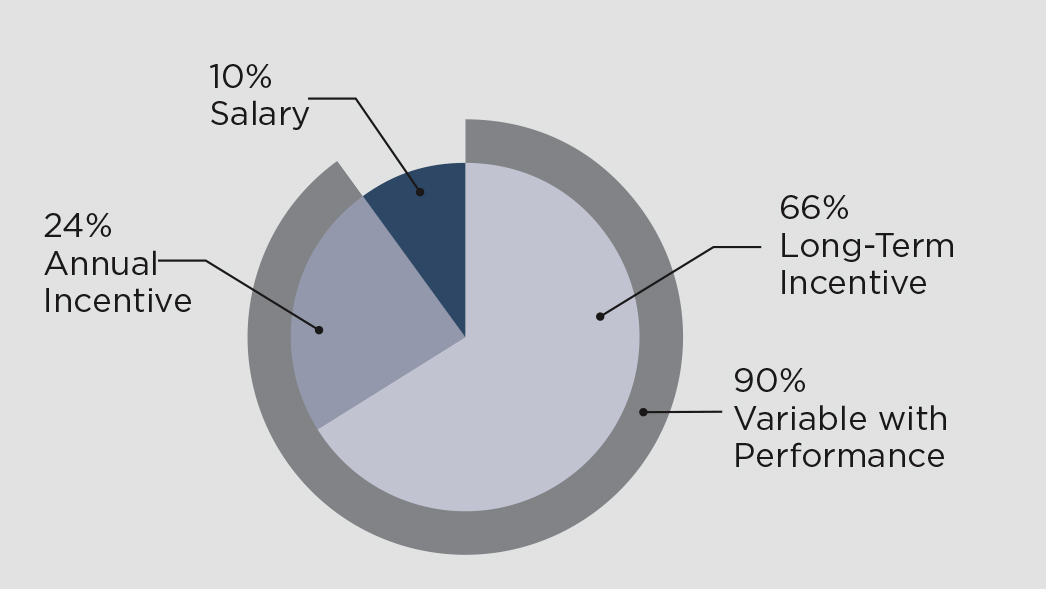 |  | |
| 38 | www.thehartford.com |
| COMPENSATION MATTERS | ||
Base Salary
44.
Annual Incentive Plan ("AIP") Awards
| STEP 1: Financial Performance Against Target (Primary Criterion) | Produces the formulaic company AIP funding level |
_____________________1 Employees and Senior Executives directly supporting our mutual funds business have an independent compensation program and thus do not participate inagainst the AIP or LTI programs described in this section. Noneannual operating plan reviewed by the Board at the start of the Senior Executives who directly support the mutual funds business is a current NEO.
The Hartford Financial Services Group, Inc.2015 Proxy Statement
41
Compensation Discussion and Analysis
Step 1: Financial Performance Against Target (Primary Criterion)
Financial performance against target is the primary criterion in determining the AIP funding factor. Core earnings is the basis for measuring financial performance.performance/fiscal year. The Compensation Committee selected core earnings because:
•
•
•
it.
At the beginning of each year, the Compensation Committee approves a definition of "Compensation Core Earnings" that specifies in advance certain items that will be adjustedCertain adjustments are made to core earnings for at the end of that year, such as accounting changes, catastrophe losses above or below budget, or unusual or non-recurring items. The Compensation Committee excludes the impact of these items because it believes they do not reflect the performance of our underlying businesses, and it wantscompensation purposes to ensure that management is held accountable for performance it controlsoperating decisions made that year, and is neither advantaged nor disadvantaged for the effect of certain items outside its control. TheAt the beginning of the year, the Compensation Committee'sCommittee approves a definition of "Compensation Core Earnings." The definition lists adjustments that will be made to core earnings at year-end in order to arrive at "Compensation Core Earnings," such as accounting changes, catastrophe losses above or below budget, and unusual or non-recurring items. The 2017 definition and a reconciliation from GAAP net income to Compensation Core Earnings for 2014 isare provided inAppendix A.
In addition to setting a target, the Compensation Committee establishes a threshold performance level, below which no AIP awards are earned, as well as a maximum funding level for performance significantly exceeding target. Actual company performance in relation to target results in a formulaicAs described on p. 44, for 2017 AIP funding factor, as illustrated below.
awards, the Compensation Committee revised the Compensation Core Earnings
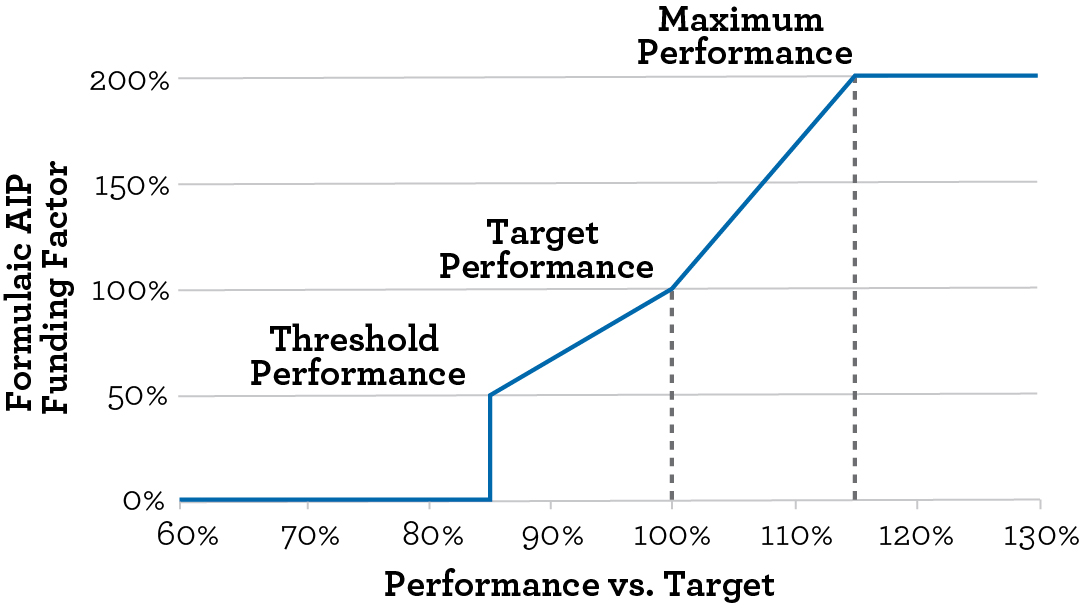
target as a result of the sale of Talcott Resolution.
•Key business metrics within the plan, such as combined ratios and P&C net investment income, drive core earnings •The outlook for these metrics are announced to investors at the beginning of each year, which helps align the interests of our Senior Executives with our shareholders, as meeting or exceeding the outlooks is a major determinant of the AIP funding level. COMPENSATION CORE EARNINGS |  | |||

Step 2: Qualitative Review (Secondary Criteria)
Once the formulaic AIP funding factor is determined,
| 2018 Proxy Statement | 39 | |
| COMPENSATION MATTERS | ||
| STEP 2: Qualitative Review | Produces the final company AIP funding level |
| Performance Criteria | and Metrics | Rationale | ||
| ||||
www.thehartford.com
42
Compensation Discussion and Analysis
| ||||
Non-Financial and Strategic Objectives: strategic initiatives and transactions, diversity, employee engagement, risk management and compliance | ||||
Peer-relative Performance: performance relative to peers on metrics such as stock price and earnings |
Historical Qualitative Adjustments to Formulaic AIP Funding Factor

interests.

Step 3: Individual Performance

The LTI program is designed to promotedrive long-term performance and encourage share ownership among Senior Executives, further aligning their interests with those of shareholders, to promote shareholder value creation.shareholders. LTI awards are granted on an annual basis following an assessment of individual performance, and potential, and a review of market data. 20142017 LTI awards for Senior Executives consist of performance shares (50% of the award value) and stock options (50% of the award value). This mix is used to provideprovides LTI awards that appropriately blend an incentive related solely to actual stock price performance, an incentive related to comparative stock price performance and an incentive related to actual operating performance.
The Hartford Financial Services Group, Inc.2015 Proxy Statement
43
Compensation Discussion and Analysis
| |
|
Sharesshares of common stock ranging from 0% to 200% of the number of performance shares granted may be payable depending upon the performance achieved.
achieved on the following metrics:
| Performance Metric | Rationale |
Compensation Core ROE (50% weighting) | Important strategic measure that drives shareholder value creation |
Peer-relative TSR (50% weighting) | Important measure of our performance against peers that are competinginvestment choices in the capital markets |
ROE:
For 50% of the performance share award, payouts at the end of the performance period, if any, will depend upon| 40 | www.thehartford.com |
| COMPENSATION MATTERS | ||
TSR:
For 50% of the performance share award, payouts at the end of the performance period, if any, will be made based on company TSR performance relative to a Performance Peer Groupfollowing changes:
| – | Added Hanover Insurance Group because it is a competitor in Small Commercial, Middle Market and Personal Lines |
| – | Added Markel Corporation because, with the acquisition of Maxum Specialty Insurance Group, it represents a competitor in the excess and surplus business and helps further diversify the Performance Peer Group |
| – | Removed MetLife, Inc., which was in the process of exiting the annuity business and was therefore no longer aligned with our Talcott Resolution business |
2014 Performance Peer Group*
85
th percentile.| 2017 Performance Peer Group | Three-Year Relative TSR Ranking | |
 | ||
| Allstate Corp. | ||
| American Financial Group, Inc. | ||
| Aon plc | ||
| Arthur J. Gallagher & Co. | ||
| The Chubb Corp. | ||
| Cincinnati Financial Corp. | ||
Hanover Insurance Group — NEW | ||
| Marsh & McLennan Companies, Inc. | ||
Markel Corporation — NEW | ||
| Mercury General Corp. | ||
| Old Republic International Corp. | ||
| The Progressive Corp. | ||
| Prudential Financial, Inc. | ||
| The Travelers Companies, Inc. | ||
| Unum | ||
Three-year Relative TSR Ranking
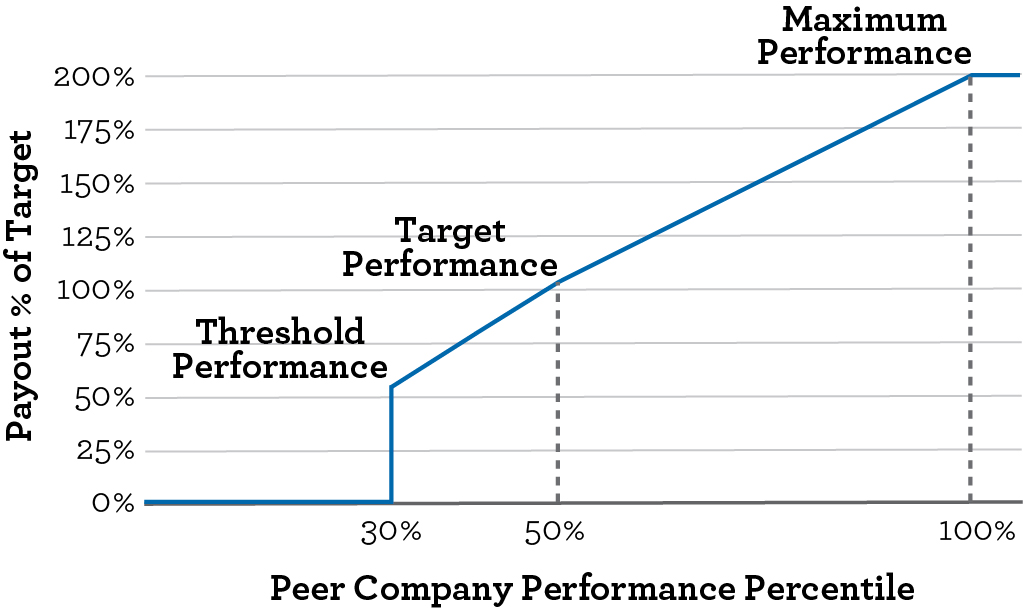
www.thehartford.com
44
Compensation Discussion and Analysis
Stock Options (50% of LTI Awards)
Periodic Retention Awards and Special Equity Grants
The Compensation Committee periodically provides cash or equity awards on a selective basis to executives based on business need. Recipients are generally those identified as critical talent and/or who have high potential to move into key roles. No such awards were made to NEOs in 2014.
Executive Benefits and Perquisites
term.
| 2018 Proxy Statement | 41 | |
| COMPENSATION MATTERS | ||
in 2017.
Compensation Committee
The Hartford Financial Services Group, Inc.2015 Proxy Statement
45
Meridian Compensation Discussion and Analysis
Compensation Consultant
Exequity,Partners, LLP ("Meridian") is the Compensation Committee'sCommittee’s independent compensation consultant and has regularly attendsattended Compensation Committee meetings.meetings since its engagement. Pursuant to our company policy, Exequity provides nothe Compensation Committee's charter, Meridian has not provided services to the company other than consulting services provided to the Compensation Committee. Exequity provides market data, analysis,Committee and, advice regarding executive compensation.
For 2014,with respect to CEO and director compensation, the Board.
Role of Management
officers are described in more detail below.
| 42 | www.thehartford.com |
| COMPENSATION MATTERS | ||
2014 Corporate Peer Group
Group.
Company Name(2) Revenues Assets Market Cap ACE Limited $ 19,211 $ 98,248 $ 38,110 Aetna Inc. $ 58,003 $ 53,402 $ 31,242 Allstate Corp (The) $ 34,826 $ 108,533 $ 29,465 CNA Financial Corp $ 9,429 $ 55,566 $ 10,450 Chubb Corp (The) $ 14,056 $ 51,286 $ 24,400 Cigna Corp $ 34,914 $ 55,896 $ 26,919 Cincinnati Financial Corporation $ 4,945 $ 18,753 $ 8,474 Lincoln National Corp $ 13,424 $ 253,377 $ 14,982 Marsh & McLennan Companies, Inc. $ 12,951 $ 17,840 $ 30,961 MetLife, Inc. $ 73,949 $ 902,337 $ 61,449 Principal Financial Group, Inc. $ 10,329 $ 219,087 $ 15,253 Progressive Corp (The) $ 19,377 $ 25,788 $ 15,865 Prudential Financial Inc $ 54,131 $ 766,655 $ 41,250 Travelers Companies Inc (The) $ 27,162 $ 103,078 $ 35,079 Unum Group $ 10,510 $ 62,497 $ 8,789 Voya Financial, Inc. $ 11,067 $ 226,951 $ 10,249 W.R. Berkley Corporation $ 6,997 $ 21,717 $ 6,505
Company Name(2) | Revenues | Assets | Market Cap | ||||||||
| Aetna Inc. | $ | 60,447 | $ | 55,151 | $ | 58,838 | |||||
| Allstate Corp | $ | 37,834 | $ | 112,422 | $ | 37,573 | |||||
| Berkley (W. R.) Corp. | $ | 7,617 | $ | 24,300 | $ | 8,727 | |||||
| CNA Financial Corp. | $ | 9,377 | $ | 56,567 | $ | 14,386 | |||||
| Chubb Ltd. | $ | 32,207 | $ | 167,022 | $ | 67,837 | |||||
| Cigna Corp. | $ | 41,616 | $ | 61,753 | $ | 50,072 | |||||
| Cincinnati Financial Corp. | $ | 5,732 | $ | 21,843 | $ | 12,300 | |||||
| Lincoln National Corp. | $ | 14,092 | $ | 281,763 | $ | 16,821 | |||||
| Marsh & McLennan Companies Inc. | $ | 14,024 | $ | 20,429 | $ | 41,538 | |||||
| MetLife Inc. | $ | 62,314 | $ | 719,892 | $ | 53,204 | |||||
| Principal Financial Group Inc. | $ | 13,861 | $ | 253,941 | $ | 20,375 | |||||
| Progressive Corp. | $ | 26,815 | $ | 38,701 | $ | 32,756 | |||||
| Prudential Financial Inc. | $ | 59,727 | $ | 831,921 | $ | 48,752 | |||||
| Travelers Companies Inc. | $ | 28,902 | $ | 103,483 | $ | 37,124 | |||||
| Unum Group | $ | 11,287 | $ | 64,013 | $ | 12,317 | |||||
| Voya Financial Inc. | $ | 8,618 | $ | 222,532 | $ | 8,892 | |||||
| XL Group Ltd. | $ | 11,189 | $ | 63,436 | $ | 9,001 | |||||
| 25TH PERCENTILE | $ | 11,189 | $ | 55,151 | $ | 12,317 | |||||
| MEDIAN | $ | 14,092 | $ | 64,013 | $ | 32,756 | |||||
| 75TH PERCENTILE | $ | 37,834 | $ | 222,532 | $ | 48,752 | |||||
| THE HARTFORD | $ | 16,804 | $ | 225,260 | $ | 20,076 | |||||
| PERCENT RANK | 51 | % | 76 | % | 43 | % | |||||
www.thehartford.com
46
Compensation Discussion and Analysis
Company Name(2) Revenues Assets Market Cap XL Group $ 6,506 $ 45,047 $ 8,869 25TH PERCENTILE $ 10,374 $ 46,607 $ 10,299 MEDIAN $ 13,740 $ 59,197 $ 20,132 75TH PERCENTILE $ 32,910 $ 191,449 $ 31,171 THE HARTFORD $ 18,320 $ 245,013 $ 17,988 PERCENT RANK 57.80% 86.30% 48.50%
| (1) | Peer data provided by S&P Capital IQ. The amounts shown in the |
| (2) | An additional four non-public companies are included in the Corporate Peer Group as they submit data to relevant compensation surveys utilized in determining appropriate pay levels for Senior Executives: Liberty Mutual, MassMutual, Nationwide Financial, and State Farm. |
surveys, respectively.
2014 AIP Performance
| 2018 Proxy Statement | 43 | |
| COMPENSATION MATTERS | ||
| Based on the assessment of performance described below, the Compensation Committee established an AIP funding |
| STEP 1: Financial Performance Against Target | Produced formulaic AIP funding level of 183% |
As described on pages41 -43, we have a three-step process for determining AIP awards. Steps 1 and 2 for 2014 are described below.
Step 1: Financial Performance Against Target
The Compensation Core Earnings target for 20142017 was $1,566$1,473 million. When setting the 2017 operating plan, which forms the basis for the Compensation Core Earnings target, both management and the Board concluded that the ability to achieve operating plan results would likely be challenging due to several factors, including robust industry competition with new entrants aggressively seeking inroads into our markets and peers competing to retain their business; lower P&C portfolio yield excluding limited partnerships; an approximately $1 billion, or 3%, decrease in the size of the P&C investment portfolio due to the $650 million measured against an AIPwe paid in December 2016 for reinsurance coverage on our legacy asbestos and environmental book and the sale of our U.K. P&C run-off subsidiaries; and lower Talcott Resolution core earnings resulting from the run-off of the book. As a result, the 2017 core earnings target was determined to be rigorous notwithstanding the fact that it was slightly below both 2016 actual and target performance levels.
Including the effect of these changes, Compensation Core Earnings for 2017 was $1,572 million measured against an AIP target of $1,398 million, producing a formulaic AIP funding level of 183%. Highlighted on the right are the minimum threshold, target and maximum Compensation Core Earnings levels against actual results for 2017. As discussed on page 39, Compensation Core Earnings will differ from the earnings numbers provided in our financial statements due to pre-determined adjustments made to ensure the AIP funding level reflects the operating performance within management's control. | 2017 COMPENSATION CORE EARNINGS | |
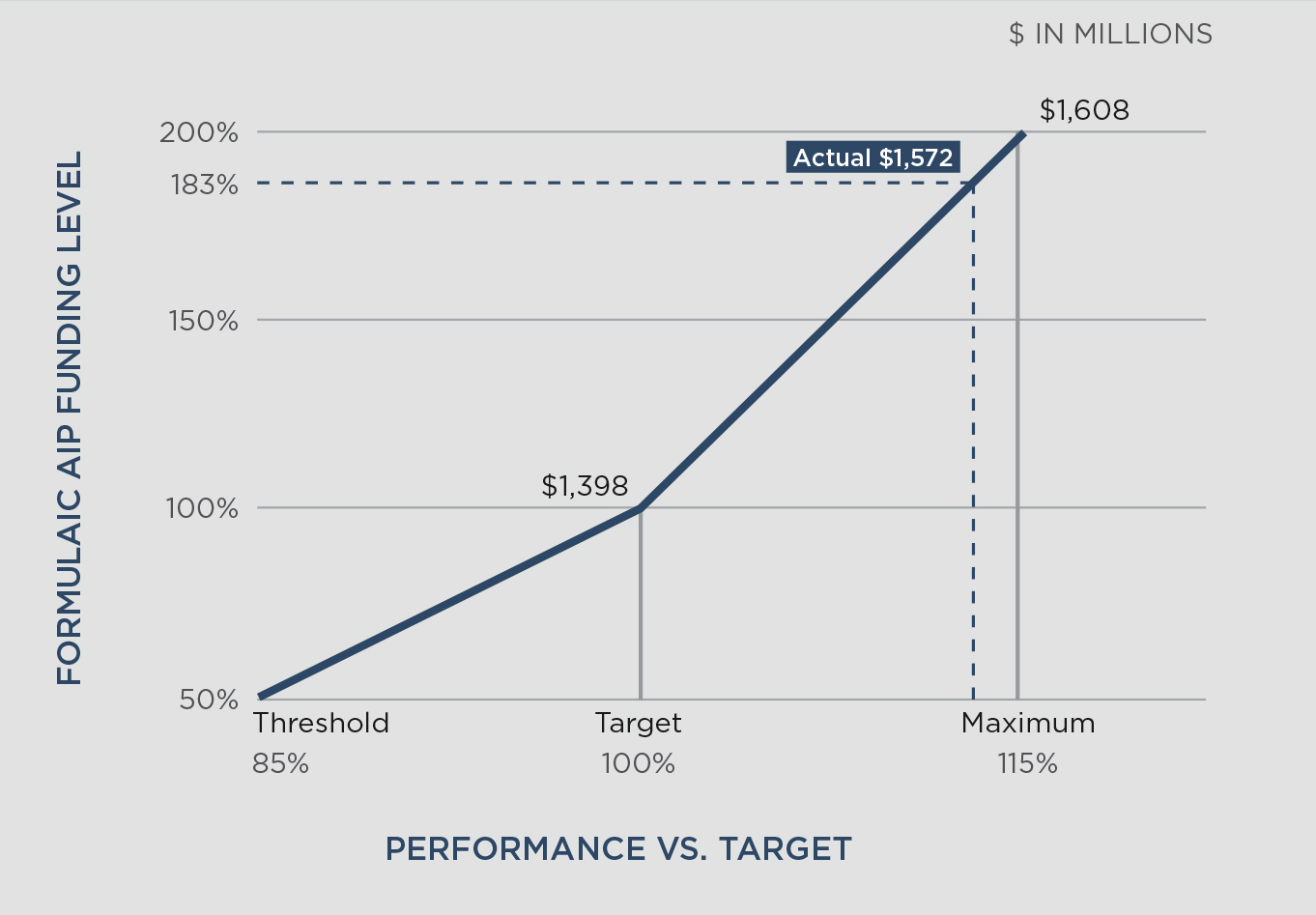 | ||
The Hartford Financial Services Group, Inc.2015 Proxy Statement
47
| 44 | www.thehartford.com |
Compensation Discussion and Analysis
| COMPENSATION MATTERS | ||
| Compensation | |||
As discussed on page42,
2014 Compensation Core Earnings
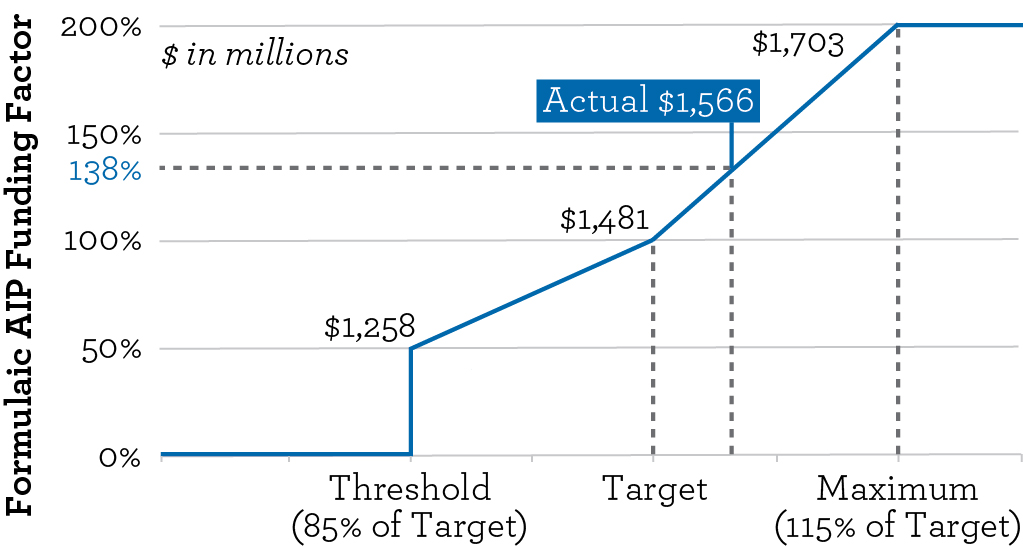

Step 2: Qualitative Review
Thelevel, the Compensation Committee undertook a qualitative review focused on the following:
www.thehartford.com
48
Compensation Discussion and Analysis
|
| |
Quality of |
The company’s earnings were above operating plan, driven by net investment income
| |
| Risk & Compliance | The company was named one of the world’s most ethical companies by Ethisphere Institute for the ninth time in 2017, reflecting a strong ethics and compliance program that emphasizes leadership accountability and prevention of ethical lapses and compliance issues. | |
| Peer Relative Performance | The company outperformed | |
| Expense Management | Excluding one-time items, the company exceeded its 2017 expense reduction targets. | |
Non-Financial and StrategicObjectives | The company acquired Aetna’s U.S. group life and disability business, announced an agreement to sell Talcott Resolution, reduced pension liabilities by $1.6 billion, and continued productivity improvements and strategic investments in technology and data analytics capabilities. | |

Step 3 is described for each NEO under2014 Named Executive Officer Compensation and Performance beginning on page50.
Certification of Performance Share Awards for the 2012-2014 Performance Period
On February 28, 2012, the Compensation Committee granted Senior Executives performance shares tied to relative TSR against a peer group of 14 companies. These performance shares vested as of December 31, 2014, the end of the three year performance period for the award. The company's TSR performance during the performance period ranked 4th out of the 14 peer companies. This performance was above the 82nd percentile and resulted in a payout of 165% of target as certified by the Compensation Committee on February 22, 2015.
Details of the 2012 performance shares are given on page 32 of our Proxy Statement filed with the Securities and Exchange Commission on April 5, 2013.
Realizable Pay & Realized Pay
In recent years, we have electedvery competitive market, were relatively flat to include disclosure on one- and three-year realizable pay and realized pay in order to illustrate the impact of stock price performance on total compensation awarded by the independent directors to the CEO. We believe that disclosure helped our shareholders understand the ultimate economic impact of CEO compensation decisions. However, following our leadership transition in 2014, we felt that realizable pay and realized pay were of limited utility for a number of reasons, including the issues presented by partial-year CEO pay and the fact that the LTI awarded to Mr. Swift in 2014 was designed for his position as a seasoned CFO and not the CEO. Accordingly, we are not including realizable and realized pay disclosure in this Compensation Discussion and Analysis.
The Hartford Financial Services Group, Inc.2015 Proxy Statement
49
Compensation Discussion and Analysis
2014 Named Executive Officer Compensation and Performance
Active Named Executive Officers
We underwent a significant leadership transition in 2014. The Board appointed a new executive management team following Liam McGee's decision in June to step down as CEO and President. The summary immediately below provides context for mid-year 2014 compensation decisions described in this section.
February 28, 2017.
•Executed a seamlessSwift’s leadership, transition into his new role, quickly establishing relationships with key internal and external stakeholders, and maintaining the organization's focus and productivity without disruption.
•company:
•reached agreement with Prudential to transfer significant pension benefit responsibility
market, as measured by the IBM Kenexa survey of global companies
| 2018 Proxy Statement | 45 | |
| COMPENSATION MATTERS | ||
February 28, 2017.
•Ledrobotics and artificial intelligence within Operations, enhancing the successful sale of the Japan annuities business, a critical strategic initiative, closing the deal within three months of signing.
•Delivered a capital release from Talcott Resolution well in excess of the 2014 capital plan,customer experience
•Executed a smooth transition to her new role as CFO, establishing relationships with key internal and external stakeholders,inclusion maintaining top quartile scores for both employee engagement results and retaining key talent within her organization.
www.thehartford.com
50
Compensation Discussion and Analysis
Douglas Elliot
Mr. Elliot hasRupp served as President of The Hartford sinceChief Risk Officer from November 2, 2011 to July 1, 2014. Previously, he served2017 and continued as Presidentan employee of our Commercial Markets division. In this prior role,the company in an advisory capacity until his retirement on February 2, 2018. For 2017, the Compensation Committee approved a base salary of $750,000, an AIP target of $1,000,000, and a 2014 LTI award of $2,000,000 granted in the form of 50% stock options and 50% performance shares on March 4, 2014. When Mr. Elliot became President in July, the Compensation Committee increased his salary to $900,000, his AIP target to $1,600,000, and his LTI award target to $4,000,000 based on his significantly expanded responsibilities. No additional LTI award was made at the time he transitioned to the role of President.
Based on the process outlined beginning on page47, the Compensation Committee approved an AIP award of $1,800,000 (138% of target based on his pro-rated salary throughout the year), consistent with the company AIP funding factor, taking into account that Mr. Elliot:
•Delivered strong financial results across all business lines, with core earnings, margins, premium growth, and managed expenses that exceeded plans.
•Further strengthened partnerships with agents and brokers in all businesses, and initiated a fresh and comprehensive review of Personal Lines since assuming responsibility for that business.
•Led improvement across employee engagement, diversity and inclusion, and talent retention metrics.
Brion Johnson
Mr. Johnson has served as Chief Investment Officer and President of HIMCO since May 16, 2012. On August 1, 2014, he was also appointed President of Talcott Resolution. For 2014, the Compensation Committee approved a base salary of $450,000, an AIP target of $1,000,000 and an LTI award of $1,100,000 granted in the form of 50% stock options and 50% performance shares on March 4, 2014. When Mr. Johnson became President of Talcott Resolution, the Compensation Committee increased his salary to $500,000 and his AIP target to $1,100,000 in recognition of his expanded responsibilities. No additional LTI award was made at the time he transitioned to the role of President of Talcott Resolution.
Based on the process outlined beginning on page47, the Compensation Committee approved an AIP award of $1,450,000 (139% of target based on his pro-rated salary throughout the year), in line with the company funding factor, taking into account that Mr. Johnson:
•Delivered net investment income in excess of plan, with general account outperforming plan by 76 basis points and one-third of investment strategies delivering top quartile investment performance against relevant benchmarks.
•Strengthened and built out the fundamental equity capabilities of HIMCO, including establishing structure and recruiting board of directors for HIMCO Variable Insurance Trust.
•Executed a smooth transition in taking on responsibility for Talcott Resolution, maintaining strong employee engagement results and retaining key talent.
Robert Rupp
Mr. Rupp joined the company as Executive Vice President and CRO on November 2, 2011. For 2014, the Compensation Committee established a target total annual compensation opportunity for Mr. Rupp based on market data for CROs at financial services companies as described underBenchmarking on page46. This included a base salary of $600,000, an AIP target $1,200,000 of $1,200,000 and an LTI award of $1,400,000 granted in the form of 50% stock options and 50% performance shares on March 4, 2014.
February 28, 2017. Based onupon the process outlined beginning on page47,time Mr. Rupp served as Chief Risk Officer during 2017 and the Compensation Committee approvedsuccessful transition of his responsibilities to a new Chief Risk Officer, Mr. Rupp received an AIP award of $1,600,000 (133%$1,500,000 (125% of target).
| 46 | www.thehartford.com |
| COMPENSATION MATTERS | ||
•measurement period would have resulted in payouts of 50%, 100% and 200% of target, respectively.Provided key risk management support
| • | The company’s TSR during the performance period was at the 40th percentile, resulting in a payout of 75% of target for the TSR component of the awards |
Exchange Commission on April 7, 2016.
•18 companies for measuring TSR performance.Improved overall scores on employee engagement and diversity and inclusion metrics.
Former CEO
Liam McGee
In June 2014, we announced Liam McGee's decision to resign as President and CEO, and the appointment of a new executive leadership team, with Mr. Swift assuming the role of CEO on July 1, 2014. In order to ensure an orderly transition, the independent directors felt that it was important to retain Mr. McGee's services beyond his resignation as President and CEO. Accordingly, the company entered into a transition agreement with Mr. McGee for advisory and transitional support through April 1, 2015.
Mr. McGee's transition agreement provided for a reduced annualized base salary of $1 million, a 2014 AIP award based on Mr. McGee's actual base salary earned during 2014 and the final company AIP funding factor without any adjustment to
The Hartford Financial Services Group, Inc.2015 Proxy Statement
51
Compensation Discussion and Analysis
reflect individual performance or other factors, and no 2015 LTI award. The agreement also provided that upon termination, outstanding equity awards granted to Mr. McGee would receive retirement treatment under our 2010 Incentive Stock Plan. This means that all options outstanding at least one year would fully vest and all other equity awards (other than the special performance share award granted on October 30, 2013, which does not pro rata vest upon retirement per the terms of the award agreement) would pro rata vest (subject to satisfaction of performance conditions). The independent directors felt it was appropriate to grant Mr. McGee retirement treatment given the specific facts and circumstances of his resignation, which was driven by the accelerated progress of our successful transformation as well as health issues. Mr. McGee did not receive any additional compensation for his service on the Board or FIRMCo, or as Chairman of the Board.
Pursuant to the terms of his transition agreement, the independent directors approved a 2014 AIP award of $3,260,250 (138% of target based on his pro-rated salary throughout the year) consistent with the company AIP funding factor. Mr. McGee passed away prior to the April 1, 2015 separation date contemplated by the transition agreement. As a result, Mr. McGee's outstanding equity awards received death benefit treatment in accordance with the normal provisions of our 2010 Incentive Stock Plan, rather than retirement treatment pursuant to his transition agreement. Under the terms of our 2010 Incentive Stock Plan, all of Mr. McGee's outstanding options fully vested and all other equity awards (other than the special performance share award granted on October 30, 2013) pro rata vested. The October 30, 2013 special equity award was forfeited. For a description of amounts payable upon Mr. McGee's death, seeTreatment of Former CEO on page 69.
Compensation Policies and Practices
Stock Ownership and Retention Guidelines
Senior Executives are expected to meet or exceed certain levels of stock ownership to align their interests with those of shareholders. The Compensation Committee has established the following ownership guidelines for the CEO and other NEOs:
NEOs
| Level | (As a |
| CEO | 6x |
Timing of Equity Grants
Recoupment Policy
Risk Mitigation in Plan Design
www.thehartford.com
52
Compensation Discussion and Analysis
comprehensiveannual review including a review by Mercer, an external consulting firm, and discussed the results of that review with the Compensation Committee. Enterprise Risk Management concluded that current incentive plans do not promote inappropriate risk-taking or encourage the manipulation of reported earnings.
| 2018 Proxy Statement | 47 | |
| COMPENSATION MATTERS | ||
| Feature | Rationale |
| Pay Mix | •A mix of fixed and variable, annual and long-term, and cash and equity compensation encouragesstrategies and actions that are in the •Long-term compensation awards and overlapping vesting periods encourage executives to focus on sustainedcompany results and stock price appreciation |
| Performance Metrics | •Incentive awards based on a variety of performance metrics |
| Equity Incentives | •Stock ownership guidelines align executive and shareholder interests •Equity grants are made only during a trading window following the release of financial results •No reload provisions are included in any stock option awards |
| Plan Design | •Incentive plans are not overly leveraged, cap the maximum payout, and include design featuresintended to balance pay for performance with an appropriate level of risk-taking •The 2014 Incentive Stock Plan does not allow:
- Stock options with an exercise price less than the fair market value of our common stock on the grant date
- Re-pricing (reduction in exercise price) of stock options,
- Single trigger vesting of awards upon a Change of Control if awards are assumed or replaced with substantially equivalent awards |
| Recoupment | •We have a broad incentive compensation recoupment policy in addition to claw-back provisionsunder the 2014 Incentive Stock Plan |
Hedging and Pledging Company Securities
Potential Severance and Change of Control Payments
Senior Executives
We maintain
Our
While we do not have individual employment agreements for active Senior Executives, we may enter into transition agreements for departing Senior Executives.
The Hartford Financial Services Group, Inc.2015 Proxy Statement
53
Report of the Compensation and Management Development Committee
Effect of Tax and Accounting Considerations on Compensation Design
In designing our compensation programs, we consider the tax and accounting impact of our decisions. In doing so, we strive to strike a balance between designing appropriate and competitive compensation programs for our executives, while also maximizing the deductibility of such compensation, and, to the extent reasonably possible, avoiding adverse accounting effects and ensuring that any accounting consequences are appropriately reflected in our financial statements.
| 48 | www.thehartford.com |
| COMPENSATION MATTERS | ||
members has served as an officer or employee of The Hartford and none of The Hartford’s executive officers has served as a member of a compensation committee or board of directors of any other entity that has an executive officer serving as a member of The Hartford’s Board.
2017.
Compensation and Management Development Committee Interlocks and Insider Participation
As of the date of this proxy statement, the Compensation and Management Development Committee consists of Messrs. Fetter (Chairman), Renyi and Swygert and Ms. Mikells, all of whom are independent non-management directors. None of the Compensation and Management Development Committee members has served as an officer or employee of The Hartford and none of the The Hartford's executive officers has served as a member of a compensation committee or board of directors of any other entity that has an executive officer serving as a member of the The Hartford's Board.
www.thehartford.com
54
| 2018 Proxy Statement | 49 | |
Executive Compensation
Executive Compensation
| COMPENSATION MATTERS | ||
Douglas Elliot Name and Principal
PositionYear Salary($) Bonus
($)(1)Stock
Awards
($)(2)Option
Awards
($)(3)Non-Equity
Incentive Plan
Compensation
($)(4)Change in
Pension
Value and
Nonqualified
Deferred
Compensation
Earnings
($)(5)All Other
Compensation
($)(6)Total($) Christopher Swift
Chairman and Chief Executive Officer2014 912,500 1,119,030 1,100,000 2,139,000 45,913 76,341 5,392,784 2013 825,000 3,100,000 1,100,000 1,850,000 - 96,818 6,971,818 2012 825,000 - 1,100,000 1,100,000 1,650,000 161,984 50,873 4,887,857 Beth Bombara
Executive Vice President and Chief Financial Officer2014 560,000 508,650 500,000 1,350,000 44,171 65,200 3,028,021
President2014 825,000 1,017,300 1,000,000 1,800,000 21,126 69,297 4,732,723 2013 750,000 - 3,000,000 1,000,000 1,700,000 - 84,835 6,534,835 2012 750,000 - 900,000 900,000 1,000,000 130,274 26,513 3,706,787 Brion Johnson
Chief Investment Officer and President, HIMCO and Talcott Resolution2014 458,333 559,515 550,000 1,450,000 8,336 62,600 3,088,784 Robert Rupp
Executive Vice President and Chief Risk Officer2014 600,000 712,110 700,000 1,600,000 4,649 66,893 3,683,652 2013 600,000 - 1,900,000 700,000 1,500,000 645 82,874 4,783,519 2012 600,000 1,235,000 700,000 700,000 1,200,000 58,550 21,000 4,514,550 Liam McGee
Former Chairman, President and Chief Executive Officer(7)2014 1,050,000 - 15,439,121* 13,495,250* 3,260,250 45,995 188,473 33,479,089* 2013 1,100,000 - 8,750,000 3,750,000 3,740,000 - 330,315 17,670,315 2012 1,100,000 - 3,750,000 3,750,000 2,350,000 148,287 58,974 11,157,261
Name and Principal Position | Year | Salary ($) | Bonus ($) | Stock Awards ($)(1) | Option Awards ($)(2) | Non-Equity Incentive Plan Compensation ($)(3) | Change in Pension Value and Nonqualified Deferred Compensation Earnings ($)(4) | All Other Compensation ($)(5) | Total ($) | ||||||||||||||||
| Christopher Swift Chairman and Chief Executive Officer | 2017 | 1,100,000 | — | 3,472,500 | 3,750,000 | 4,675,000 | 34,380 | 83,405 | 13,115,285 | ||||||||||||||||
| 2016 | 1,075,000 | — | 3,404,473 | 3,575,000 | 1,925,000 | 17,769 | 81,879 | 10,079,121 | |||||||||||||||||
| 2015 | 1,000,000 | — | 3,289,280 | 3,200,000 | 2,450,000 | 5,764 | 77,375 | 10,022,419 | |||||||||||||||||
| Beth Bombara Executive Vice President and Chief Financial Officer | 2017 | 700,000 | — | 810,250 | 875,000 | 1,900,000 | 34,380 | 65,400 | 4,385,030 | ||||||||||||||||
| 2016 | 687,500 | — | 833,263 | 875,000 | 770,000 | 13,122 | 65,300 | 3,244,185 | |||||||||||||||||
| 2015 | 643,750 | — | 848,018 | 825,000 | 1,200,000 | — | 65,300 | 3,582,068 | |||||||||||||||||
| Douglas Elliot President of The Hartford | 2017 | 925,000 | — | 2,315,000 | 2,500,000 | 3,150,000 | 15,738 | 67,526 | 8,973,264 | ||||||||||||||||
| 2016 | 918,750 | — | 2,202,194 | 2,312,500 | 1,295,000 | 8,490 | 67,368 | 6,804,302 | |||||||||||||||||
| 2015 | 900,000 | — | 2,261,380 | 2,200,000 | 2,000,000 | 3,101 | 67,006 | 7,431,487 | |||||||||||||||||
| Brion Johnson Chief Investment Officer and President, HIMCO and Talcott Resolution | 2017 | 525,000 | — | 694,500 | 750,000 | 2,300,000 | 6,199 | 68,150 | 4,343,849 | ||||||||||||||||
| 2016 | 525,000 | — | 642,803 | 675,000 | 1,100,000 | 3,393 | 68,050 | 3,014,246 | |||||||||||||||||
| 2015 | 518,750 | — | 616,740 | 600,000 | 1,400,000 | 1,286 | 65,300 | 3,202,076 | |||||||||||||||||
| William Bloom, EVP Operations Technology & Data | 2017 | 550,000 | — | 463,000 | 500,000 | 1,575,000 | 14,846 | 67,845 | 3,170,691 | ||||||||||||||||
| Robert Rupp Former Chief Risk Officer | 2017 | 600,000 | — | 648,200 | 700,000 | 1,500,000 | 3,227 | 65,400 | 3,516,827 | ||||||||||||||||
| 2016 | 600,000 | — | 666,610 | 700,000 | 1,000,000 | 3,117 | 65,300 | 3,035,027 | |||||||||||||||||
| 2015 | 600,000 | — | 719,530 | 700,000 | 1,400,000 | 2,443 | 65,300 | 3,487,273 | |||||||||||||||||
Salary($) Bonus($) Stock
Awards($)Option
Awards($)Non-Equity
Incentive Plan
Compensation($)Change in
Pension
Value and
Nonqualified
Deferred
Compensation
Earnings($)All Other
Compensation($)Total($) 2014 Compensation (prior to Accounting Adjustments) 1,050,000 3,814,875 3,750,000 3,260,250 45,995 188,743 12,109,593 Financial Accounting Cost Adjustments 11,624,246 9,745,250 21,369,496 2014 Summary Compensation Table 1,050,000 - 15,439,121 13,495,250 3,260,250 45,995 188,473 33,479,089 No financial accounting cost resulted for Mr. McGee's unvested October 2013 special performance share award because, consistent with the original award terms, that award was forfeited.
The Hartford Financial Services Group, Inc.2015 Proxy Statement
55
Executive Compensation
| (1) | This column | |
| NEO | 2017 Performance Shares (February 28, 2017 grant date) | 2016 Performance Shares (March 1, 2016 grant date) | 2015 Performance Shares (March 3, 2015 grant date) | ||||||||
| C. Swift | $ | 7,084,289 | $ | 6,739,911 | $ | 6,067,995 | |||||
| B. Bombara | $ | 1,652,967 | $ | 1,649,599 | $ | 1,564,400 | |||||
| D. Elliot | $ | 4,722,829 | $ | 4,359,731 | $ | 4,171,707 | |||||
| B. Johnson | $ | 1,416,895 | $ | 1,272,557 | $ | 1,137,710 | |||||
| W. Bloom | $ | 944,566 | |||||||||
| R. Rupp | $ | 1,322,410 | $ | 1,319,729 | $ | 1,327,393 | |||||
| (2) | This column reflects the full aggregate grant date fair value for the fiscal years ended December 31, 2017, 2016 and 2015 calculated in accordance with FASB ASC Topic 718; amounts are not reduced for forfeitures during the applicable vesting periods. Other assumptions used in the calculation of these amounts are included in the company's Annual Reports on Form 10-K for 2017 (footnote 19), 2016 (footnote 19) and 2015 (footnote 17). |
| (3) | This column reflects cash AIP awards paid for the respective years. |
| 50 | www.thehartford.com |
| COMPENSATION MATTERS | ||
| (4) | This column reflects the actuarial increase, if any, in the present value of the |
| (5) | This column reflects amounts described in the |
NEO 2014 Performance Shares (March 4, 2014 grant date)* 2013 Performance Shares (March 5, 2013 grant date) 2013 Special Equity Grant (October 30, 2013 grant date) 2012 Performance Shares (February 28, 2012 grant date) Mr. Swift $2,090,738 $2,200,000 $2,000,000 $2,200,000 Ms. Bombara $950,336 Mr. Elliot $1,900,671 $2,000,000 $2,000,000 $1,800,000 Mr. Johnson $1,045,335 Mr. Rupp $1,330,470 $1,400,000 $1,200,000 $1,400,000 Mr. McGee $7,127,414 $7,500,000 $10,000,000 $7,500,000 *Reflects adjustment for no payment of dividends on unvested performance shares. Under the 2010 and 2014 Incentive Stock Plans, no more than 500,000 shares in the aggregate can be earned by an individual employee with respect to RSUs and performance share awards made in a single calendar year. As a result, the number of shares ultimately distributed to an employee (or former employee) with respect to awards made in the same year will be reduced, if necessary, so that the number does not exceed this limit. (3) The amounts shown in this column reflect the full aggregate grant date fair value for the fiscal years ended December 31, 2012, 2013, and 2014 calculated in accordance with FASB ASC Topic 718. Assumptions used in the calculation of these amounts are included in footnote 19 to the company's audited financial statements for the fiscal years ended December 31, 2012 and 2013, and in footnote 18 to the company's audited financial statements for the fiscal year ended December 31, 2014, included in the company's 2012, 2013 and 2014 Annual Reports on Form 10-K, respectively. Amounts in this column are not reduced for estimated forfeitures during the applicable vesting periods. (4) The amounts shown in this column reflect cash AIP awards paid for the respective years. (5) The amounts shown in this column reflect the actuarial increase in the present value of the accumulated benefits of the NEOs under all pension plans established by the company. The amounts were calculated using discount rate and form of payment assumptions consistent with those used in the company's GAAP financial statements. Actuarial assumptions for 2014 are described in further detail in the footnote to thePension Benefits Table on page 62. For Messrs. McGee, Swift, and Elliot, the change in pension values for 2013 are ($1,141), ($16,786), and ($7,165), respectively, and therefore not reported in the table. (6) The amounts shown in this column are described in theSummary Compensation Table—All Other Compensation below. (7) As part of Mr. McGee's transition agreement dated June 9, 2014, Mr. McGee's salary was reduced to $1,000,000 effective July 1, 2014 and Mr. McGee would have received retirement treatment on outstanding, unvested equity awards (except his performance share award granted on October 30, 2013, which would be forfeited as of his date of termination). Additional provisions of this transition agreement, including treatment for Mr. McGee's 2014 AIP award, are described inTreatment of FormerCEO on page 69. Following Mr. McGee's death on February 13, 2015, all of his outstanding options vested in full and all of his outstanding performance share awards (except for his performance share award granted on October 30, 2013, which was forfeited) pro-rata vested in accordance with the terms of the 2010 Incentive Stock Plan applicable upon the death of an employee.
The following
Name Year Perquisites($) Amount Paid or Accrued pursuant
to a plan or arrangement in
connection with any termination
of employment or CIC($)Contributions or other
allocations to defined
contribution plans
($)(1)Total($) Christopher Swift 2014 11,141 (2) - 65,200 76,341 Beth Bombara 2014 0 - 65,200 65,200 Douglas Elliot 2014 4,097 (3) - 65,200 69,297 Brion Johnson 2014 0 - 62,600 62,600 Robert Rupp 2014 1,693 (4) - 65,200 66,893 Liam McGee 2014 72,886 (5) 50,387(6) 65,200 188,473
www.thehartford.com
56
| Name | Year | Perquisites ($) | Contributions or Other Allocations to Defined Contribution Plans ($)(1) | Total ($) | |||||||
| Christopher Swift | 2017 | 18,038 | (2) | 65,367 | 83,405 | ||||||
| Beth Bombara | 2017 | — | 65,400 | 65,400 | |||||||
| Douglas Elliot | 2017 | 2,126 | (3) | 65,400 | 67,526 | ||||||
| Brion Johnson | 2017 | 2,750 | (4) | 65,400 | 68,150 | ||||||
| William Bloom | 2017 | 2,445 | (5) | 65,400 | 67,845 | ||||||
| Robert Rupp | 2017 | — | 65,400 | 65,400 | |||||||
Executive Compensation
| (1) | This column |
| (2) | Perquisite amounts for Mr. Swift |
| (3) | Perquisite amounts for Mr. Elliot |
| (4) | Perquisite amounts for Mr. |
| (5) | Perquisite amounts for Mr. |
| 2018 Proxy Statement | 51 | |
The Hartford Financial Services Group, Inc.2015 Proxy Statement
57
| COMPENSATION MATTERS | ||
Executive Compensation
Grants of Plan Based Awards Table
The followingThis table discloses the actual number of stock options, performance shares and RSUsinformation about equity awards granted to the company's NEOs in 20142017 pursuant to the 20102014 Incentive Stock Plan and the grant date fair value of these awards.Plan. The table also discloses potential payouts under the company's AIP and performance share awards. Actual AIP payouts are reported in theSummary Compensation Tableon page55 50 under the heading "Non-Equity“Non-Equity Incentive Plan Compensation." The equity” Equity awards have been rounded to the nearest whole share option or unit.
Name Plan Grant Date Estimated Future Payouts Under
Non-Equity Incentive Plan
Awards(1) Estimated Future Payouts Under
Equity Incentive Plan
Awards(2)All Other
Stock
Awards:
Number of
Shares of
Stock or
Units (#)All Other
Option
Awards:
Number of
Securities
Underlying
Options
(#)(3)Exercise
or Base
Price of
Option
Awards
($/Sh)Grant
Date Fair
Value of
Stock and
Options
Awards
($)(4)Threshold($) Target($) Maximum($) Threshold(#) Target(#) Maximum(#) Christopher
Swift2014 AIP 775,000 1,550,000 3,100,000 Stock Options 3/4/2014 103,872 35.83 1,100,000 Performance
Shares3/4/2014 7,676 30,701 61,402 1,119,030 Beth Bombara 2014 AIP 375,000 750,000 1,500,000 Stock Options 3/4/2014 47,214 35.83 500,000 Performance
Shares3/4/2014 3,489 13,955 27,910 508,650 Douglas
Elliot2014 AIP 650,000 1,300,000 2,600,000 Stock Options 3/4/2014 94,429 35.83 1,000,000 Performance
Shares3/4/2014 6,978 27,910 55,820 1,017,300 Brion Johnson 2014 AIP 520,900 1,041,700 2,083,400 Stock Options 3/4/2014 51,936 35.83 550,000 Performance
Shares3/4/2014 3,838 15,350 30,700 559,515 Robert
Rupp2014 AIP 600,000 1,200,000 2,400,000 Stock Options 3/4/2014 66,100 35.83 700,000 Performance
Shares3/4/2014 4,885 19,537 39,074 712,110 Liam
McGee2014 AIP 1,181,300 2,362,500 4,725,000 Stock Options 3/4/2014 354,108 35.83 3,750,000 Performance
Shares3/4/2014 26,166 104,661 209,322 3,814,875
* Mr. Johnson's AIP target was increased effective August 1, 2014. The amounts shown under the "Threshold" column represent the payout amount for achieving the minimum level of performance for which an amount is payable under the AIP (no amount is payable if this level of performance is not reached). The amounts shown under the "Maximum" column are 200% of target and represent, in the Compensation Committee's practice, the maximum amount payable. However, to reward extraordinary performance, the Compensation Committee may, in its sole discretion, authorize individual AIP awards of up to the lesser of 300% of the target annual incentive payment level or the Internal Revenue Code section 162(m) limit. The actual 2014 AIP award for each of the NEOs is reported in the column entitled "Non-Equity Incentive Plan Compensation" in theSummary Compensation Table. (1) The amounts shown in these columns represent pro-rated threshold, target and maximum awards payable to the NEOs under the company's AIP for 2014, rounded up to the next hundred dollar increment. Consistent with company practice, the NEO's threshold, target and maximum AIP award opportunities are based on pro-rated salary for 2014. The table below shows initial 2014 AIP target incentive opportunities and the revised 2014 AIP target incentive opportunities approved mid-year for Messrs. Swift, Elliot and Johnson and Ms. Bombara to reflect their increased responsibilities following the CEO transition. Mr. Rupp's AIP target incentive opportunity did not change in 2014. Mr. McGee's target annual incentive opportunity was based on a salary of $1,100,000 as established by the independent directors in February, 2014 and was reduced when his salary was reduced to $1,000,000 on July 1, 2014. NEO AIP Target effective 1/1/2014 AIP Target effective 7/1/2014* 2014 Pro-rated AIP Target Christopher Swift $1,100,000 $2,000,000 $1,550,000 Beth Bombara $650,000 $850,000 $750,000 Douglas Elliot $1,000,000 $1,600,000 $1,300,000 Brion Johnson $1,000,000 $1,100,000 $1,041,700 Liam McGee $2,475,000 $2,225,000 $2,362,500
www.thehartford.com
58
| Name | Plan | Grant Date | Estimated Future Payouts Under Non-Equity Incentive Plan Awards(1) | Estimated Future Payouts Under Equity Incentive Plan Awards(2) | All Other Stock Awards: Number of Shares of Stock or Units (#) | All Other Option Awards: Number of Securities Underlying Options (#)(3) | Exercise or Base Price of Option Awards ($/Sh) | Grant Date Fair Value of Stock and Option Awards ($)(4) | ||||||||||||||||||||||||
Threshold ($) | Target ($) | Maximum ($) | Threshold (#) | Target (#) | Maximum (#) | |||||||||||||||||||||||||||
| C. Swift | 2017 AIP | 1,375,000 | 2,750,000 | 5,000,000 | ||||||||||||||||||||||||||||
| Stock Options | 2/28/2017 | 302,908 | 48.89 | 3,750,000 | ||||||||||||||||||||||||||||
Performance Shares | 2/28/2017 | 13,423 | 76,703 | 153,406 | 3,472,500 | |||||||||||||||||||||||||||
| B. Bombara | 2017 AIP | 550,000 | 1,100,000 | 2,200,000 | ||||||||||||||||||||||||||||
| Stock Options | 2/28/2017 | 70,679 | 48.89 | 875,000 | ||||||||||||||||||||||||||||
Performance Shares | 2/28/2017 | 3,132 | 17,897 | 35,794 | 810,250 | |||||||||||||||||||||||||||
| D. Elliot | 2017 AIP | 925,000 | 1,850,000 | 3,700,000 | ||||||||||||||||||||||||||||
| Stock Options | 2/28/2017 | 201,939 | 48.89 | 2,500,000 | ||||||||||||||||||||||||||||
Performance Shares | 2/28/2017 | 8,949 | 51,135 | 102,270 | 2,315,000 | |||||||||||||||||||||||||||
| B. Johnson | 2017 AIP | 675,000 | 1,350,000 | 2,700,000 | ||||||||||||||||||||||||||||
| Stock Options | 2/28/2017 | 60,582 | 48.89 | 750,000 | ||||||||||||||||||||||||||||
Performance Shares | 2/28/2017 | 2,685 | 15,341 | 30,682 | 694,500 | |||||||||||||||||||||||||||
| W. Bloom | 2017 AIP | 400,000 | 800,000 | 1,600,000 | ||||||||||||||||||||||||||||
| Stock Options | 2/28/2017 | 40,388 | 48.89 | 500,000 | ||||||||||||||||||||||||||||
Performance Shares | 2/28/2017 | 1,790 | 10,227 | 20,454 | 463,000 | |||||||||||||||||||||||||||
| R. Rupp | 2017 AIP | 600,000 | 1,200,000 | 2,400,000 | ||||||||||||||||||||||||||||
| Stock Options | 2/28/2017 | 56,543 | 48.89 | 700,000 | ||||||||||||||||||||||||||||
Performance Shares | 2/28/2017 | 2,506 | 14,318 | 28,636 | 648,200 | |||||||||||||||||||||||||||
Executive Compensation
| (1) | Consistent with company practice, the NEO’s threshold, target and maximum AIP award opportunities are based on salary for 2017. The “Threshold” column shows the payout amount for achieving the minimum level of performance for which an amount is payable under the AIP (no amount is payable if this level of performance is not reached). The “Maximum” column shows the maximum amount payable at 200% of target, subject to the limit set out in the Executive Bonus Program approved by shareholders in 2014; the amount for Mr. Swift has been reduced to $5,000,000 to reflect this plan limit. To reward extraordinary performance, the Compensation Committee may, in its sole discretion, authorize individual AIP awards of up to the lower of 300% of the target annual incentive payment level or the Executive Bonus Program limit. The actual 2017 AIP award for each NEO is reported in the “Non-Equity Incentive Plan Compensation” column in theSummary Compensation Table. |
| (2) | The |
| (3) | The |
| (4) | The NYSE closing price per share of the |
| 52 | www.thehartford.com |
| COMPENSATION MATTERS | ||
Name Option Awards Stock Awards Grant Date Number of
Securities
Underlying
Unexercised
Options
(#)
Exercisable(1)Number of
Securities
Underlying
Unexercised
Options
(#)
Unexercisable(1)Option
Exercise
Price($)Option
Expiration
DateNumber
of Shares
or Units
of Stock
That
Have Not
Vested
(#)(2)Market
Value of
Shares or
Units of
Stock That
Have Not
Vested ($)(3)Equity
Incentive
Plan
Awards:
Number of
Unearned
Shares,
Units or
Other Rights
That Have
Not Vested
(#)(4)Equity
Incentive
Plan Awards:
Market or
Payout Value
of Unearned
Shares, Units
or Other
Rights That
Have Not
Vested
($)(3)Christopher
Swift3/1/2011 92,937 - 28.91 3/1/2021 2/28/2012 98,965 49,483 20.63 2/28/2022 3/5/2013 47,129 94,259 24.15 3/5/2023 91,098 3,797,876 10/30/2013 29,763 1,240,819 29,248 1,219,349 3/4/2014 - 103,872 35.83 3/4/2024 30,701 1,279,925 Beth
Bombara3/1/2011 13,104 - 28.91 3/1/2021 2/28/2012 - 7,198 20.63 2/28/2022 3/5/2013 17,138 34,276 24.15 3/5/2023 33,126 1,381,023 10/30/2013 17,858 744,500 17,549 731,618 3/4/2014 - 47,214 35.83 3/4/2024 13,955 581,784 Douglas
Elliot5/4/2011 81,320 - 28.05 5/4/2021 2/28/2012 30,971 40,486 20.63 2/28/2022 3/5/2013 42,845 85,690 24.15 3/5/2023 82,816 3,452,599 10/30/2013 29,763 1,240,819 29,248 1,219,349 3/4/2014 - 94,429 35.83 3/4/2024 27,910 1,163,568 Brion
Johnson2/28/2012 15,271 636,648 3/5/2013 19,280 38,651 24.15 3/5/2023 37,268 1,553,703 10/30/2013 17,858 744,500 17,549 731,618 3/4/2014 - 51,936 35.83 3/4/2024 15,350 639,942
The Hartford Financial Services Group, Inc.2015 Proxy Statement
59
| Name | Option Awards | Stock Awards | ||||||||||||||||||||||
| Grant Date | Number of Securities Underlying Unexercised Options Exercisable(#)(1) | Number of Securities Underlying Unexercised Options Unexercisable(#)(1) | Option Exercise Price ($) | Option Expiration Date | Number of Shares or Units of Stock That Have Not Vested (#)(2) | Market Value of Shares or Units of Stock That Have Not Vested ($) | Equity Incentive Plan Awards: Number of Unearned Shares, Units or Other Rights That Have Not Vested (#)(3) | Equity Incentive Plan Awards: Market or Payout Value of Unearned Shares, Units or Other Rights That Have Not Vested ($)(4) | ||||||||||||||||
| Christopher Swift | 3/1/2011 | 92,937 | — | 28.91 | 3/1/2021 | |||||||||||||||||||
| 2/28/2012 | 148,448 | — | 20.63 | 2/28/2022 | ||||||||||||||||||||
| 3/5/2013 | 141,388 | — | 24.15 | 3/5/2023 | ||||||||||||||||||||
| 10/30/2013 | 31,424 | 1,768,543 | ||||||||||||||||||||||
| 3/4/2014 | 103,872 | — | 35.83 | 3/4/2024 | ||||||||||||||||||||
| 3/3/2015 | 201,258 | 100,629 | 41.25 | 3/3/2025 | ||||||||||||||||||||
| 3/1/2016 | 98,160 | 196,321 | 43.59 | 3/1/2026 | 82,014 | 4,615,748 | ||||||||||||||||||
| 2/28/2017 | — | 302,908 | 48.89 | 2/28/2027 | 76,703 | 4,316,845 | ||||||||||||||||||
| Beth Bombara | 3/1/2011 | 13,104 | — | 28.91 | 3/1/2021 | |||||||||||||||||||
| 2/28/2012 | 7,198 | — | 20.63 | 2/28/2022 | ||||||||||||||||||||
| 3/5/2013 | 51,414 | — | 24.15 | 3/5/2023 | ||||||||||||||||||||
| 10/30/2013 | 18,855 | 1,061,159 | ||||||||||||||||||||||
| 3/4/2014 | 47,214 | — | 35.83 | 3/4/2024 | ||||||||||||||||||||
| 3/3/2015 | 51,886 | 25,944 | 41.25 | 3/3/2025 | ||||||||||||||||||||
| 3/1/2016 | 24,025 | 48,051 | 43.59 | 3/1/2026 | 20,073 | 1,129,708 | ||||||||||||||||||
| 2/28/2017 | — | 70,679 | 48.89 | 2/28/2027 | 17,897 | 1,007,243 | ||||||||||||||||||
| Douglas Elliot | 5/4/2011 | 81,320 | — | 28.05 | 5/4/2021 | |||||||||||||||||||
| 2/28/2012 | 71,457 | — | 20.63 | 2/28/2022 | ||||||||||||||||||||
| 3/5/2013 | 128,535 | — | 24.15 | 3/5/2023 | ||||||||||||||||||||
| 10/30/2013 | 31,424 | 1,768,543 | ||||||||||||||||||||||
| 3/4/2014 | 94,429 | — | 35.83 | 3/4/2024 | ||||||||||||||||||||
| 3/3/2015 | 138,364 | 69,183 | 41.25 | 3/3/2025 | ||||||||||||||||||||
| 3/1/2016 | 63,495 | 126,991 | 43.59 | 3/1/2026 | 53,051 | 2,985,710 | ||||||||||||||||||
| 2/28/2017 | — | 201,939 | 48.89 | 2/28/2027 | 51,135 | 2,877,878 | ||||||||||||||||||
| Brion Johnson | 3/5/2013 | 57,841 | — | 24.15 | 3/5/2023 | |||||||||||||||||||
| 10/30/2013 | 18,855 | 1,061,159 | ||||||||||||||||||||||
| 3/4/2014 | 51,936 | — | 35.83 | 3/4/2024 | ||||||||||||||||||||
| 3/3/2015 | 37,736 | 18,868 | 41.25 | 3/3/2025 | ||||||||||||||||||||
| 3/1/2016 | 18,533 | 37,068 | 43.59 | 3/1/2026 | 15,485 | 871,496 | ||||||||||||||||||
| 2/28/2017 | — | 60,582 | 48.89 | 2/28/2027 | 15,341 | 863,391 | ||||||||||||||||||
| William Bloom | 3/3/2015 | 22,012 | 11,007 | 41.25 | 3/3/2025 | |||||||||||||||||||
| 3/1/2016 | 10,983 | 21,966 | 43.59 | 3/1/2026 | 9,176 | 516,425 | ||||||||||||||||||
| 8/1/2016 | 19,181 | 1,079,507 | ||||||||||||||||||||||
| 2/28/2017 | — | 40,388 | 48.89 | 2/28/2027 | 10,227 | 575,576 | ||||||||||||||||||
| Robert Rupp | 11/4/2011 | 62,230 | — | 17.83 | 11/4/2021 | |||||||||||||||||||
| 2/28/2012 | 54,467 | — | 20.63 | 2/28/2022 | ||||||||||||||||||||
| 3/5/2013 | 89,974 | — | 24.15 | 3/5/2023 | ||||||||||||||||||||
| 10/30/2013 | 18,855 | 1,061,159 | ||||||||||||||||||||||
| 3/4/2014 | 66,100 | — | 35.83 | 3/4/2024 | ||||||||||||||||||||
| 3/3/2015 | 44,025 | 22,013 | 41.25 | 3/3/2025 | ||||||||||||||||||||
| 3/1/2016 | 19,220 | 38,441 | 43.59 | 3/1/2026 | 16,059 | 903,801 | ||||||||||||||||||
| 2/28/2017 | — | 56,543 | 48.89 | 2/28/2027 | 14,318 | 805,817 | ||||||||||||||||||
Executive Compensation
Name Option Awards Stock Awards Grant Date Number of
Securities
Underlying
Unexercised
Options
(#)
Exercisable(1)Number of
Securities
Underlying
Unexercised
Options
(#)
Unexercisable(1)Option
Exercise
Price($)Option
Expiration
DateNumber
of Shares
or Units
of Stock
That
Have Not
Vested
(#)(2)Market
Value of
Shares or
Units of
Stock That
Have Not
Vested ($)(3)Equity
Incentive
Plan
Awards:
Number of
Unearned
Shares,
Units or
Other Rights
That Have
Not Vested
(#)(4)Equity
Incentive
Plan Awards:
Market or
Payout Value
of Unearned
Shares, Units
or Other
Rights That
Have Not
Vested
($)(3)Robert
Rupp11/4/2011 92,230 - 17.83 11/4/2021 2/28/2012 52,978 31,489 20.63 2/28/2022 3/5/2013 29,991 59,983 24.15 3/5/2023 57,972 2,416,853 10/30/2013 17,858 744,500 17,549 731,618 3/4/2014 - 66,100 35.83 3/4/2024 19,537 814,498 Liam
McGee(5)3/1/2011 302,045 - 28.91 3/1/2021 2/28/2012 112,460 168,691 20.63 2/28/2022 3/5/2013 160,668 321,337 24.15 3/5/2023 310,560 12,947,246 10/30/2013 146,242 6,096,829 3/4/2014 354,108 35.83 3/4/2024 104,661 4,363,317
| (1) | Stock options granted to the NEOs vest and become exercisable 1/3 per year on each anniversary of the grant |
| 2018 Proxy Statement | 53 | |
| COMPENSATION MATTERS | ||
| (2) | This column |
| (3) | This column |
shares. See
|
www.thehartford.com
60
Executive Compensation
Option Exercises and Stock Vested Table
The followingThis table sets forth certainprovides information regarding option awards exercised and stock awards that vested during 2014 for the company's NEOs.2017. The numbers have been rounded to the nearest whole dollar share or unit.
Name Option Awards Stock Awards Number of Shares
Acquired on Exercise (#)Value Realized
on Exercise
($)(1)Number of Shares
Acquired on Vesting
(#)(2)Value Realized
on Vesting
($)(3)Christopher Swift - - 124,546 4,935,291 Beth Bombara 14,394 192,927 17,953 712,153 Douglas Elliot 50,000 843,500 104,981 4,165,803 Brion Johnson - - 7,998 331,658 Robert Rupp 20,000 391,695 85,611 3,496,951 Liam McGee 224,922 3,631,748 418,774 16,620,219
(1) The amounts in this column reflect the value realized upon the exercise of vested stock options during 2014. The value realized is the difference between the fair market value of common stock on the date of exercise and the exercise price of the option. All options were exercised pursuant to pre-planned trading plans in accordance with Rule 10b5-1 of the Securities Exchange Act of 1934. (2) The numbers in this column include the vesting of RSUs granted in 2011 and settled in shares for Messrs. Swift, Elliot, Rupp and McGee and Ms. Bombara. Messrs. Swift and McGee and Ms. Bombara received the 2011 RSUs, which vested in full on March 1, 2014, as part of the 2011 annual grant; Mr. Elliot and Mr. Rupp received the 2011 RSUs, which vested on May 4, 2014 and November 4, 2014, respectively, as sign-on awards. This column also includes performance shares granted on February 28, 2012 which vested on December 31, 2014 and were paid out in 2015 based on a 165% payout factor as a result of the company's performance against the award's relative TSR performance objective for the three-year performance period January 1, 2012 - December 31, 2014, which the Compensation Committee certified on February 22, 2015. The following table illustrates the breakdown between vested RSUs and vested Performance Shares included in the number of vested shares listed in the table above: Vested RSUs (#) Vested Performance Shares (#) Mr. Swift 36,568 87,978 Ms. Bombara 5,156 12,797 Mr. Elliot 32,998 71,983 Mr. Johnson - 7,998 Mr. Rupp 29,625 55,986 Mr. McGee 118,847 299,927 (3) The amounts shown in this column reflect the value of vested RSU and performance share awards. The value of the RSU awards is based on the NYSE closing price per share of the company's common stock on the date of vesting. The value of performance share awards is based on the NYSE closing price per share of the company's common stock on February 20, 2015 ($41.47), the last business day prior to the date the Compensation Committee certified the vesting percentage, which occurred on a day when the NYSE was closed.
| Name | Option Awards | Stock Awards | |||||||
Number of Shares Acquired on Exercise (#)(1) | Value Realized on Exercise ($)(1) | Number of Shares Acquired on Vesting (#)(2) | Value Realized on Vesting ($)(3) | ||||||
| Christopher Swift | 80,679 | 4,352,634 | |||||||
| Beth Bombara | 20,800 | 1,122,160 | |||||||
| Douglas Elliot | 55,466 | 2,992,408 | |||||||
| Brion Johnson | 15,127 | 816,091 | |||||||
William Bloom (4) | 39,875 | 2,205,901 | |||||||
| Robert Rupp | 17,649 | 952,153 | |||||||
| (1) | No options were exercised by the NEOs during 2017. |
| (2) | The performance shares granted on March 3, 2105 vested on December 31, 2017 and paid out at 104% of target following the Compensation Committee’s February 21, 2018 certification of company performance against two equally weighted measures: |
| (3) | The taxable value of performance share awards is based on the NYSE closing price per share of the company's common stock on February 21, 2018 ($53.95), the date the date the Compensation Committee certified the vesting percentage. |
| (4) | The amount shown for Mr. Bloom reflects (a) $1,729,825 as a result of the vesting of his sign-on RSU award, which was granted on August 1, 2017, and (b) $476,076 as a result of the vesting of the performance shares granted on March 3, 2015. |
The Hartford Financial Services Group, Inc.2015 Proxy Statement
61
| 54 | www.thehartford.com |
Executive Compensation
| COMPENSATION MATTERS | ||
Name Plan Name Number of Years
Credited Service
(#)(1)Present Value of
Accumulated Benefit
($)(2)Actual Cash
Balance Account($)Payments During
Last Fiscal Year($)Christopher Swift Retirement Plan 2.83 58,815 63,422 - Excess Pension Plan 2.83 327,108 352,730 - Beth Bombara Retirement Plan 8.67 123,710 139,386 - Excess Pension Plan 8.67 153,796 173,285 - Douglas Elliot Retirement Plan 1.74 40,970 43,956 - Excess Pension Plan 1.74 144,011 154,507 - Brion Johnson Retirement Plan 1.24 25,298 27,096 - Excess Pension Plan 1.24 48,721 52,184 - Robert Rupp Retirement Plan 1.16 31,390 32,050 - Excess Pension Plan 1.16 38,751 39,567 - Liam McGee(3) Retirement Plan 3.25 98,071 101,268 - Excess Pension Plan 3.25 496,195 512,370 -
his earlier period of employment.
| Name | Plan Name | Number of Years Credited Service (#)(1) | Present Value of Accumulated Benefit ($)(2) | Actual Cash Balance Account or Accrued Benefit ($) | Payments During Last Fiscal Year ($) | ||||||||
| Christopher Swift | Retirement Plan | 2.83 | 67,641 | 69,920 | — | ||||||||
| Excess Pension Plan | 2.83 | 376,195 | 388,869 | — | |||||||||
| Beth Bombara | Retirement Plan | 8.67 | 144,789 | 153,667 | — | ||||||||
| Excess Pension Plan | 8.67 | 180,002 | 191,039 | — | |||||||||
| Douglas Elliot | Retirement Plan | 1.74 | 47,023 | 48,459 | — | ||||||||
| Excess Pension Plan | 1.74 | 165,287 | 170,337 | — | |||||||||
| Brion Johnson | Retirement Plan | 1.24 | 29,016 | 29,872 | — | ||||||||
| Excess Pension Plan | 1.24 | 55,881 | 57,530 | — | |||||||||
William Bloom(3) | Retirement Plan | 3.50 | 124,398 | 11,198 | — | ||||||||
| Excess Pension Plan | 3.50 | 1,301 | 117 | — | |||||||||
| Robert Rupp | Retirement Plan | 1.16 | 35,322 | 35,334 | — | ||||||||
| Excess Pension Plan | 1.16 | 43,606 | 43,621 | — | |||||||||
| (1) | Benefit accruals ceased as of December 31, 2012 under |
| (2) | The present value of accumulated benefits under each Plan is calculated |
| (3) |
Retirement benefits were accrued under a cash balance formula for employees hired on or after January 1, 2001 and before January 1, 2013, including the NEOs.
cash balance formula until December 31, 2012. Effective December 31, 2012, the cash balance formula under the Retirement Plan and the Excess Pension Plan was frozen for all Plan participants, including the NEOs. As a result, employees no longer accrue further benefits under the cash balance formula, except that existing account balances continueInterest continues to accrue interest. Employees also continue to earn service credit under the cash balance formula towards vesting in their benefits.
The interestbe credited on previously accrued amounts, is determined each year to be equal to the greaterat a rate of 3.3% andor based on the 10-year10 year Treasury rate, determined before the start of the year. Vestedwhichever is greater. All Plan participants are currently vested in their account balances, under the cash balance formulawhich they may be receivedelect to receive in the form of a single lump sum payment upon termination of employment or the participant may elect to receive an actuarially-equivalent form of life annuity. An employee is vested upon completionannuity following termination of three years of service.
employment.
www.thehartford.com
62
| 2018 Proxy Statement | 55 | |
Executive Compensation
| COMPENSATION MATTERS | ||
Name of Fund Rate of Return
(as of December 31, 2014) Name of Fund Rate of Return
(as of December 31, 2014) The Hartford Stock Fund 21.53 Vanguard Target Retirement 2010 Trust 6.02 ISP International Equity Fund(1) -3.71 Vanguard Target Retirement 2015 Trust 6.65 ISP Active Large Cap Equity Fund(2) 10.73 Vanguard Target Retirement 2020 Trust 7.22 ISP Small/Mid Cap Equity Fund(3) 9.41 Vanguard Target Retirement 2025 Trust 7.25 Hartford Index Fund 13.65 Vanguard Target Retirement 2030 Trust 7.28 ISP High Yield Bond Fund 1.57 Vanguard Target Retirement 2035 Trust 7.26 Hartford Stable Value Fund 2.34 Vanguard Target Retirement 2040 Trust 7.29 Hartford Total Return Bond HLS Fund 5.89 Vanguard Target Retirement 2045 Trust 7.29 SSGA Real Asset Fund -1.06 Vanguard Target Retirement 2050 Trust 7.29 Vanguard Prime Money Market Fund 0.05 Vanguard Target Retirement 2055 Trust 7.27 Vanguard Target Retirement Income Trust 5.72 Vanguard Target Retirement 2060 Trust 7.25
| Name of Fund | Rate of Return (for the year ended Dec. 31, 2017) | Name of Fund | Rate of Return (for the year ended Dec. 31, 2017) | |||
| The Hartford Stock Fund | 20.18 | % | Vanguard Target Retirement 2015 Trust | 11.56 | % | |
ISP International Equity Fund(1) | 24.83 | % | Vanguard Target Retirement 2020 Trust | 14.19 | % | |
ISP Active Large Cap Equity Fund(2) | 26.09 | % | Vanguard Target Retirement 2025 Trust | 16.04 | % | |
ISP Small/Mid Cap Equity Fund(3) | 17.94 | % | Vanguard Target Retirement 2030 Trust | 17.63 | % | |
| Hartford Index Fund | 21.80 | % | Vanguard Target Retirement 2035 Trust | 19.22 | % | |
| Hartford Stable Value Fund | 2.27 | % | Vanguard Target Retirement 2040 Trust | 20.84 | % | |
| Hartford Total Return Bond HLS Fund | 5.16 | % | Vanguard Target Retirement 2045 Trust | 21.50 | % | |
| SSGA Real Asset Fund | 8.62 | % | Vanguard Target Retirement 2050 Trust | 21.51 | % | |
| Vanguard Federal Money Market Fund | 0.81 | % | Vanguard Target Retirement 2055 Trust | 21.52 | % | |
| Vanguard Target Retirement Income Trust | 8.61 | % | Vanguard Target Retirement 2060 Trust | 21.52 | % | |
Vanguard Target Retirement 2010 Trust(4) | 5.15 | % | Vanguard Target Retirement 2065 Trust(5) | 7.51 | % | |
| (1) | The ISP International Equity Fund is a multi-fund portfolio made up of two underlying mutual funds that provides a blended rate of return. The underlying funds |
| (2) | The ISP Active Large Cap Equity Fund is a multi-fund portfolio made up of |
| (3) | The ISP Small/Mid Cap Equity Fund is a multi-fund portfolio made up of four underlying funds |
| (4) | The Vanguard Target Retirement 2010 Trust Fund was merged into the Vanguard Target Retirement Income Trust as of July 20, 2017. |
| (5) | The Vanguard Target Retirement 2065 Trust Fund was added as an investment option on July 20, 2017. The rate of return shown represents return from the date it was added to the plan until December 31, 2017. |
The Hartford Financial Services Group, Inc.2015 Proxy Statement
63
| 56 | www.thehartford.com |
Executive Compensation
| COMPENSATION MATTERS | ||
Name Executive
Contributions
in Last FY
($)(1)Registrant
Contributions
in Last FY
($)(2)Aggregate
Earnings
in Last FY
($)(3)Aggregate
Withdrawals /
Distributions($)Aggregate
Balance
at Last FYE
($)(4)Christopher Swift 44,400 44,400 16,013 - 350,811 Beth Bombara 44,400 44,400 4,192 - 189,859 Douglas Elliot 44,400 44,400 5,091 - 240,702 Brion Johnson 44,400 44,400 9,726 - 115,176 Robert Rupp 44,400 44,400 11,587 - 240,119 Liam McGee 44,400 44,400 25,349 - 523,177
2017.
| Name | Executive Contributions in Last FY ($)(1) | Registrant Contributions in Last FY ($)(2) | Aggregate Earnings in Last FY ($)(3) | Aggregate Withdrawals / Distributions ($) | Aggregate Balance at Last FYE ($)(4) | |||||||||
| Christopher Swift | 43,800 | 43,800 | 97,186 | — | 741,214 | |||||||||
| Beth Bombara | 43,800 | 43,800 | 10,229 | — | 478,853 | |||||||||
| Douglas Elliot | 43,800 | 43,800 | 11,459 | — | 533,404 | |||||||||
| Brion Johnson | 43,800 | 43,800 | 89,718 | — | 493,288 | |||||||||
| William Bloom | 43,800 | 43,800 | 32,010 | — | 217,554 | |||||||||
| Robert Rupp | 43,800 | 43,800 | 97,241 | — | 611,517 | |||||||||
| (1) | The amounts shown |
| (2) | The amounts shown |
| (3) | The amounts shown |
| (4) | The amounts shown represent the cumulative amount that has been credited to each |
Deferred Distribution of Vested Equity
The table below shows the value of equity compensation for Ms. Bombara that vested in 2013 and was distributed in 2014.(1)
Name Executive
Contributions
in Last FY($)Registrant
Contributions
in Last FY($)Aggregate
Earnings
in Last FY
($)(2)Aggregate
Withdrawals /
Distributions
($)(3)Aggregate
Balance
at Last FYE($)Christopher Swift - - Beth Bombara RSUs - - (5,686) (115,182) - Douglas Elliot - - - Brion Johnson - - - Robert Rupp - - - Liam McGee - - -
| 2018 Proxy Statement | 57 |
Potential Payments Upon Termination or Change of Control
www.thehartford.com
64
Executive Compensation
Senior Executive Severance Pay Plan
Involuntary Termination (Other than for Cause)
A participant in the Senior Executive Plan whoprovisions.
months following the termination date.
| 58 | www.thehartford.com |
| COMPENSATION MATTERS | ||
A participant in the AIP who meets the criteria for retirement treatment would be eligible to receive a pro rata AIP award, in a discretionary amount, under the company's AIP for the year in which termination occurs, payable no later than the March 15 following the calendar year of termination. In accordance with the terms of the 2010 Incentive Stock Plan and the 2014 Incentive Stock Plan, such an employee would also (1) vest pro rata in any outstanding unvested performance share and RSU
The Hartford Financial Services Group, Inc.2015 Proxy Statement
65
Executive Compensation
awards (other than the October 2013 special equity awards), and (2) vest fully in any outstanding unvested stock options, provided that the option has been outstanding for at least one year from the date of grant. For this purpose, an employee is eligible for retirement treatment if (i) the employee is at least age 50, has at least 10 years of service and the sum of the employee's age and service is equal to at least 70, or (ii) the employee is at least age 65 with at least 5 years of service.
The value of amounts shown for accelerated stock option and other LTI vesting is calculated using the NYSE closing price per share of the company'scompany’s common stock on December 31, 201429, 2017 of $41.69.
$56.28.
| Payment Type | Christopher Swift | Beth Bombara | Douglas Elliot | Brion Johnson | William Bloom | Robert Rupp | |||||||||||||||
| VOLUNTARY TERMINATION OR RETIREMENT | |||||||||||||||||||||
2017 AIP Award ($)(1) | — | — | — | — | — | — | |||||||||||||||
Accelerated Stock Option Vesting ($)(2) | — | — | — | — | — | 1,179,952 | |||||||||||||||
Accelerated Performance Share Vesting ($)(3) | — | — | — | — | — | 1,408,632 | |||||||||||||||
Accelerated Other LTI Vesting ($)(3) | — | — | — | — | — | — | |||||||||||||||
| TOTAL TERMINATION BENEFITS ($) | — | — | — | — | — | 2,588,584 | |||||||||||||||
| INVOLUNTARY TERMINATION – NOT FOR CAUSE | |||||||||||||||||||||
2017 AIP Award ($)(1) | 4,675,000 | 1,900,000 | 3,150,000 | 2,300,000 | 1,575,000 | 1,500,000 | |||||||||||||||
Cash Severance ($)(4) | 7,700,000 | 3,600,000 | 5,550,000 | 3,750,000 | 2,700,000 | 3,600,000 | |||||||||||||||
Accelerated Stock Option Vesting ($)(2) | 2,291,454 | 577,230 | 1,533,215 | 431,020 | 253,250 | 1,179,952 | |||||||||||||||
Accelerated Performance Share Vesting ($)(3) | 4,516,189 | 1,088,962 | 2,949,804 | 868,794 | 536,123 | 1,408,632 | |||||||||||||||
Accelerated Other LTI Vesting ($)(3) | — | — | — | — | — | — | |||||||||||||||
Benefits Continuation and Outplacement ($)(5) | 38,918 | 29,258 | 34,047 | 38,831 | 38,918 | 33,939 | |||||||||||||||
| TOTAL TERMINATION BENEFITS ($) | 19,221,561 | 7,195,450 | 13,217,066 | 7,388,645 | 5,103,291 | 7,722,523 | |||||||||||||||
CHANGE OF CONTROL/ INVOLUNTARY TERMINATION NOT FOR CAUSE OR TERMINATION FOR GOOD REASON | |||||||||||||||||||||
2017 AIP Award ($)(1) | 4,675,000 | 1,900,000 | 3,150,000 | 2,300,000 | 1,575,000 | 1,500,000 | |||||||||||||||
Cash Severance ($)(4) | 7,700,000 | 3,600,000 | 5,550,000 | 3,750,000 | 2,700,000 | 3,600,000 | |||||||||||||||
Accelerated Stock Option Vesting ($)(2) | 6,242,257 | 1,522,023 | 4,143,665 | 1,201,680 | 742,651 | 1,236,524 | |||||||||||||||
Accelerated Performance Share Vesting ($)(3) | 8,932,593 | 2,136,951 | 5,863,588 | 1,734,887 | 1,092,001 | 1,709,618 | |||||||||||||||
Accelerated Other LTI Vesting ($)(3) | 1,768,543 | 1,061,159 | 1,768,543 | 1,061,159 | 1,079,507 | 1,061,159 | |||||||||||||||
Benefits Continuation and Outplacement ($)(5) | 38,918 | 29,258 | 34,047 | 38,831 | 38,918 | 33,939 | |||||||||||||||
Additional Pension Benefits ($)(6) | — | — | — | — | — | — | — | 225 | — | ||||||||||||
| TOTAL TERMINATION BENEFITS ($) | 29,357,311 | 10,249,391 | 20,509,843 | 10,086,557 | 7,228,302 | 9,141,240 | |||||||||||||||
| INVOLUNTARY TERMINATION – DEATH OR DISABILITY | |||||||||||||||||||||
2017 AIP Award ($)(1) | 4,675,000 | 1,900,000 | 3,150,000 | 2,300,000 | 1,575,000 | 1,500,000 | |||||||||||||||
Cash Severance ($)(4) | — | — | — | — | — | — | |||||||||||||||
Accelerated Stock Option Vesting ($)(2) | 6,242,257 | 1,522,023 | 4,143,665 | 1,201,680 | 742,651 | 1,236,524 | |||||||||||||||
Accelerated Performance Share Vesting ($)(3) | 7,395,530 | 1,760,776 | 4,869,346 | 1,444,651 | 920,009 | 1,408,632 | |||||||||||||||
Accelerated Other LTI Vesting ($)(3) | — | — | — | — | — | — | |||||||||||||||
Benefits Continuation and Outplacement ($)(5) | 43,571 | 14,136 | 29,239 | 43,198 | 43,571 | 27,184 | |||||||||||||||
| TOTAL TERMINATION BENEFITS ($) | 18,356,358 | 5,196,935 | — | 12,192,250 | — | 4,989,529 | — | 3,281,231 | 4,172,340 | ||||||||||||
| 2018 Proxy Statement | 59 | |
Payment Type Christopher
SwiftBeth
BombaraDouglas
ElliotBrion
JohnsonRobert
RuppVOLUNTARY TERMINATION OR RETIREMENT 2014 AIP Award ($)(1) - - - - - Accelerated Stock Option Vesting ($)(2) - - - - - Accelerated Performance Share Vesting ($)(3) - - - - - Accelerated Other LTI Vesting ($)(3) - - - - - Total Termination Benefits ($) - - - - - INVOLUNTARY TERMINATION - NOT FOR CAUSE 2014 AIP Award ($)(1) 2,139,000 1,350,000 1,800,000 1,450,000 1,600,000 Cash Severance ($)(4) 6,000,000 2,950,000 5,000,000 3,200,000 3,600,000 Accelerated Stock Option Vesting ($)(2) 1,555,105 374,285 1,334,059 277,641 989,598 Accelerated Performance Share Vesting ($)(3) 1,692,781 654,325 1,538,903 731,284 1,077,270 Accelerated Other LTI Vesting ($)(3) - - - 602,922 - Benefits Continuation and Outplacement ($)(5) 36,839 28,672 32,765 36,953 36,839 Total Termination Benefits ($) 11,423,725 5,357,282 9,705,727 6,298,800 7,303,707 CHANGE OF CONTROL/ INVOLUNTARY TERMINATION NOT
FOR CAUSE OR TERMINATION FOR GOOD REASON2014 AIP Award ($)(1) 2,139,000 1,350,000 1,800,000 1,450,000 1,600,000 Cash Severance ($)(4) 6,000,000 2,950,000 5,000,000 3,200,000 3,600,000 Accelerated Stock Option Vesting ($)(2) 3,304,105 1,029,465 2,908,992 980,705 2,102,606 Accelerated Performance Share Vesting ($)(3) 4,398,212 2,003,913 4,109,217 2,148,411 2,754,542 Accelerated Other LTI Vesting ($)(3) 1,240,819 744,500 1,240,819 1,381,148 744,500 Benefits Continuation and Outplacement ($)(5) 36,839 28,672 32,765 36,953 36,839 Additional Pension Benefits ($)(6) - - - - - Total Termination Benefits ($)(7) 17,118,975 8,106,550 15,091,793 9,197,217 10,838,487
| COMPENSATION MATTERS | ||
2017. Mr. Rupp became retirement eligible under the "Rule of 70" as of January 2, 2018.
50.
50.
www.thehartford.com
66
Executive Compensation
Death or Disability. Disability. Each NEO would receive a 20142017 AIP award comparable to the award that would have been paid had he or she been subject to an involuntary termination (not for Cause).
2017, except for Mr. Rupp, who was eligible to receive full vesting of his 2016 and 2017 stock option awards. Further, if Mr. Rupp met certain conditions prior to termination of employment, he would receive pro rata vesting of his 2015 stock option award.
Change Of Control
.
canceled.
Vested options would need to be exercised within five years of the applicable termination date but not beyond the scheduled expiration date.
2017, except for Mr. Rupp who was eligible to receive retirement treatment on his outstanding performance share awards. Unless the Compensation Committee determined otherwise, Mr. Rupp's RSU award granted on October 30, 2013 would be forfeited, consistent with the terms of that award.
Change Of Control. The NEOs would be entitled to full vesting of all outstanding awards granted prior to October 2013; those awards would be payable immediately provided that the Change of Control also constituted a "change in control" as defined in regulations issued under Section 409A of the Internal Revenue Code. The performance shares and RSUs resulting from the October 2013 special equity grant and the RSUs granted to Mr. Bloom on August 1, 2016 would be forfeited, unless the Compensation Committee determined otherwise.
| 60 | www.thehartford.com |
| COMPENSATION MATTERS | ||
The Hartford Financial Services Group, Inc.2015 Proxy Statement
67
Executive Compensation
Control (i.e., the October 2013 special equity awards and Mr. Bloom's RSU award and the 2014 performance share awards were not honored or replaced, or that the NEOs were terminated at the time of the Change of Control without Cause), based on $41.69,$56.28, the NYSE closing stock price per share of the company's common stock on December 31, 2014,29, 2017, and, in the case of performance shares, a payout at target. (TheThe Compensation Committee could determine that performance share awards would pay out at greater than the target amount).
amount.
canceled.
(6) Pension Payments Upon a Change of Control
In the event of a Change of Control, each executive would receive a lump sum equal to the value of the executive's cash balance formula account under the Excess Pension Plan, provided that the Change of Control also constituted a "change in control" as defined in regulations issued under Section 409A of the Internal Revenue Code. All NEOs were vested in their cash balance account as of December 31, 2014.
(7) Other Benefits in the Event of
In addition to the termination benefits shown in the table, in the event of death, an
www.thehartford.com
68
Executive Compensation
On June 9, 2014, the company entered into a transition agreement with Mr. McGee that provided for:
•A reduction in Mr. McGee's annual salarycontinuation from $1.1 million to $1 million as of July 1, 2014.
•A 2014 AIP award based on Mr. McGee's actual base salary earned during 2014 and the final company AIP funding factor without any adjustment to reflect individual performance or other factors; this amount ($3,260,250) was paid in March 2015 and is reflected in theSummary Compensation Table.
•Provision of a post-career transition service for Mr. McGee in 2014, valued at $50,387.
Following his death on February 13, 2015, only certain provisions of the transition agreement apply. For equity awards, the company's regular policies and plan provisions for deceased employees apply, including full vesting of outstanding stock option awards and pro rata vesting of performance share awards as of the date of death:
•Outstanding stock options granted on February 28, 2012, March 5, 2013, and March 4, 2014 vested in full with an adjusted option expiration date of five years following the date of employment termination. As of December 31, 2014, the value of the accelerated vesting was $11,263,956, which was calculated based on the NYSE closing price per share of the company's common stock as of that date ($41.69).
•A pro rata portion of the performance shares granted on March 5, 2013 and March 4, 2014 vested (subjecttermination due to the satisfaction of performance objectives) for the portion of each performance period Mr. McGee was employed, with payment to be made after the end of each three year performance period on the scheduled payout date based on the approved payout factor (0%-200%). As of December 31, 2014, the value of the accelerated vesting, assuming a target payout, was $5,770,897, which was calculated based on the portion of each performance period that had elapsed as of December 31, 2014 and the NYSE closing price per share of the company's common stock as of that date ($41.69).
•long term disability.The 2013 special equity award (granted to Mr. McGee on October 30, 2013) was forfeited, consistent with the terms of that award.
In accordance with Mr. McGee's transition agreement, his family can elect to continue, at its expense, company high deductible health plan coverage following his death.
Mr. McGee's vested Excess Savings Plan benefit (see theNon-Qualified Deferred Compensation - Excess Savings Plan Table on page 64) and pension benefits (see the Pension Benefits Table on page 62) will be distributed following his death.
Definitions
•Prior
•Upon
•
•
•
| 2018 Proxy Statement | 61 | |
| COMPENSATION MATTERS | ||
•
•
The Hartford Financial Services Group, Inc.2015 Proxy Statement
69
Executive Compensation
beginning of such period (the "Incumbent Directors"“Incumbent Directors”) cease (for any reason other than death) to constitute at least a majority of the Board or the board of directors of any successor to the company, provided that any director who was not a director at the beginning of such period shall be deemed to be an Incumbent Director if such director (A) was elected to the Board by, or on the recommendation of or with the approval of, at least two-thirds of the directors who then qualified as Incumbent Directors either actually or by prior operation of this clause, and (B) was not designated by a person who has entered into an agreement with the company to effect a merger or sale transaction described above.
•
•
•
•
•
www.thehartford.com
70
| 62 | www.thehartford.com |
Advisory Approval of 2014 Compensation of Named Executive Officers
Item 3 Advisory Approval of 2014 Compensation of Named Executive Officers
Section 14A of the Securities Exchange Act of 1934, as amended, provides our shareholders with the opportunity to vote to approve, on an advisory basis, the compensation of our NEOs as disclosed in this proxy statement in accordance with the rules of the SEC. We currently intend to hold these votes on an annual basis. Accordingly, the next such vote will be held at our 2016 Annual Meeting.
As described in detail in theCompensation Discussion and Analysis beginning on page37, our executive compensation program is designed to promote long-term shareholder value creation and support our strategy by: (1) encouraging profitable growth consistent with prudent risk management, (2) attracting and retaining key talent, and (3) appropriately aligning pay with short- and long-term performance. The advisory vote on this resolution is not intended to address any specific element of compensation; rather, it relates to the overall compensation of our NEOs, as well as the philosophy, policies and practices described in this proxy statement. You have the opportunity to vote for, against or abstain from voting on the following resolution relating to executive compensation:
RESOLVED, that the shareholders approve, on an advisory basis, the compensation of the named executive officers, as disclosed pursuant to the compensation disclosure rules of the Securities and Exchange Commission, including the Compensation Discussion and Analysis, the compensation tables and the narrative discussion contained in this proxy statement.
Because the required vote is advisory, it will not be binding upon the Board. The Compensation Committee will, however, take into account the outcome of the vote when considering future executive compensation arrangements.
The Board recommends that shareholders vote "FOR" the foregoing resolution to approve our compensation of named executive officers as disclosed in theCompensation Discussion and Analysis, the compensation tables and the narrative discussion contained in this proxy statement.
The Hartford Financial Services Group, Inc.2015 Proxy Statement
71
| INFORMATION ON STOCK OWNERSHIP | ||
Information on Stock Ownership
Information on Stock Ownership

www.thehartford.com
72
Information on Stock Ownership
Directors and Executive Officers
The following table shows, as of March 23, 2015:19, 2018: (1) the number of shares of our common stock beneficially owned by each director, director nominee, and NEO*,NEO, and (2) the aggregate number of shares of common stock and common stock-based equity (including RSUs, performance shares granted at target and stock options that will not vest or become exercisable within 60 days, as applicable) held by all directors, director nominees, and Section 16 executive officers as a group.
Neither the common stock
*As a result of his death on February 13, 2015, the common stock owned by Mr. McGee is not included in this table.
Name of Beneficial Owner Common Stock(1) Total(2) Robert B. Allardice, III 51,178 51,178 Beth Bombara 70,317 282,763 Douglas Elliot 327,382 822,518 Trevor Fetter 50,757 50,757 Brion Johnson 73,230 267,752 Kathryn A. Mikells 47,911 47,911 Michael G. Morris 62,874 62,874 Thomas A. Renyi 44,326 44,326 Julie G. Richardson(3) 13,713 13,713 Teresa W. Roseborough(4) 622 622 Virginia P. Ruesterholz 9,563 9,563 Robert Rupp 277,196 518,270 Charles B. Strauss(5) 52,162 52,162 Christopher J. Swift 453,904 1,085,135 H. Patrick Swygert 42,192 42,192 All directors, director nominees and Section 16 executive officers as a group
(21 persons)2,056,385 4,175,927
19, 2018.
| Name of Beneficial Owner | Common Stock(1) | Total(2) | ||
| Robert B. Allardice, III | 30,573 | 30,573 | ||
| William A. Bloom | 94,920 | 220,884 | ||
| Beth Bombara | 279,617 | 487,360 | ||
| Carlos Dominguez | 743 | 743 | ||
Douglas Elliot(3) | 1,270,163 | 1,313,507 | ||
| Trevor Fetter | 66,362 | 66,362 | ||
| Brion Johnson | 273,518 | 454,037 | ||
| Stephen P. McGill | 1,240 | 1,240 | ||
| Kathryn A. Mikells | 65,071 | 65,071 | ||
| Michael G. Morris | 76,156 | 76,156 | ||
| Thomas A. Renyi | 64,980 | 64,980 | ||
Julie G. Richardson(4) | 31,973 | 31,973 | ||
| Teresa W. Roseborough | 12,746 | 12,746 | ||
| Virginia P. Ruesterholz | 25,531 | 25,531 | ||
| Robert Rupp | 545,015 | 545,015 | ||
| Charles B. Strauss | 62,557 | 62,557 | ||
Christopher J. Swift(3)(5) | 2,061,944 | 2,114,916 | ||
| H. Patrick Swygert | 45,351 | 45,351 | ||
Greig Woodring(6) | 1,324 | 1,324 | ||
| All directors, director nominees and Section 16 executive officers as a group (25 persons) | 5,484,830 | 6,413,552 | ||
| (1) | All shares of common stock are owned directly except as otherwise indicated below. Pursuant to SEC regulations, shares of common stock beneficially owned include shares of |
| (2) | This column shows the |
| (3) | The amount shown for Messrs. Elliot and Swift reflects retirement eligibility as of March 19, 2018 or within 60 days thereafter, as applicable. |
| (4) | The amount shown includes 1,500 shares of common stock held by three separate trusts for which Ms. Richardson serves as |
| (5) | The amount shown includes |
| (6) | The amount shown includes 84 shares of common stock held by trust for which Mr. Woodring serves a trustee. |
The Hartford Financial Services Group, Inc.2015 Proxy Statement
73
| 2018 Proxy Statement | 63 | |
Information on Stock Ownership
| INFORMATION ON STOCK OWNERSHIP | ||
Name and Address of Beneficial Owner Amount and Nature of Beneficial Ownership Percent of Class(1) The Vanguard Group
100 Vanguard Blvd.
Malvern, PA 1935531,707,571 (2) 7.34% State Street Corporation
One Lincoln Street
Boston, MA 0211125,688,335 (3) 6.0%
| Name and Address of Beneficial Owner | Amount and Nature of Beneficial Ownership | Percent of Class(1) |
| The Vanguard Group 100 Vanguard Blvd. Malvern, PA 19355 | 35,985,992(2) | 10.08% |
| BlackRock Inc. 55 East 52nd Street New York, NY 10055 | 28,643,442(3) | 8.0% |
| JPMorgan Chase & Co. 270 Park Avenue New York, NY 10017 | 25,497,417(4) | 7.1% |
| State Street Corporation One Lincoln Street Boston, MA 02111 | 22,146,229(5) | 6.21% |
| (1) | The percentages contained in this column are based solely on information provided in Schedules 13G or 13G/A filed with the SEC by each of the beneficial owners listed above regarding their respective holdings of our common stock as of December 31, |
| (2) | This information is based solely on information contained in a Schedule 13G/A filed on February |
| (3) | This information is based solely on information contained in a Schedule 13G/A filed on February 8, 2018 by BlackRock, Inc. to report that it was the beneficial owner of 28,643,442 shares of our common stock as of December 31, 2017. BlackRock has (i) sole power to vote or to direct the vote with respect to 24,810,835 of such shares; and (ii) sole power to dispose or direct the disposition of 28,643,442 of such shares. |
| (4) | This information is based solely on information contained in a Schedule 13G filed on January 22, 2018 by JPMorgan Chase & Co. to report that it was the beneficial owner of 25,497,417 shares of our common stock as of December 31, 2017. JPMorgan has (i) sole power to vote or to direct the vote with respect to 23,703,978 of such shares; (ii) shared power to vote or to direct the vote of 96,951 of such shares; (iii) sole power to dispose or to direct the disposition of 25,305,888 of such shares; and (iv) shared power to dispose or to direct the disposition of 189,483 of such shares. |
| (5) | This information is based solely on information contained in a Schedule 13G filed on February |
www.thehartford.com
74
| 64 | www.thehartford.com |
Information about The Hartford's Annual Meeting of Shareholders
Information about The Hartford's Annual Meeting of Shareholders

The Hartford Financial Services Group, Inc.2015 Proxy Statement
75
| INFORMATION ABOUT THE MEETING | ||
Householding of Proxy Materials
Householding of Proxy Materials
SEC rules permit companies and intermediaries such as brokers to satisfy delivery requirements for proxy statements and notices with respect to two or more shareholders sharing the same address by delivering a single proxy statement or a single notice addressed to those shareholders. This process, which is commonly referred to as "householding,"“householding,” provides cost savings for companies. Some brokers household proxy materials, delivering a single proxy statement or notice to multiple shareholders sharing an address unless contrary instructions have been received from the affected shareholders. Once you have received notice from your broker that they will be householding materials to your address, householding will continue until you are notified otherwise or until you revoke your consent. If, at any time, you no longer wish to participate in householding and would prefer to receive a separate proxy statement or notice, please notify your broker. You may also call (800) 542-1061 or write to: Householding Department, 51 Mercedes Way, Edgewood, New York 11717, and include your name, the name of your broker or other nominee, and your account number(s). You can also request prompt delivery of copies of the proxy statementNotice of 2018 Annual Meeting of Shareholders, Proxy Statement and Form 10-K for the fiscal year ended December 31, 20142017 Annual Report by writing to Donald C. Hunt, Vice President and Corporate Secretary, The Hartford Financial Services Group, Inc., One Hartford Plaza, Hartford, CT 06155.
5, 2018.
A:Instead of mailing a printed copy of our proxy materials to each shareholder of record, the SEC permits us to furnish proxy materials by providing access to those documents on the Internet. Shareholders will not receive printed copies of the proxy materials unless they request them. The notice instructs you as to how to submit your proxy on the Internet. If you would like to receive a paper or email copy of our proxy materials, you should follow the instructions in the notice for requesting those materials.
| A: | Instead of mailing a printed copy of our proxy materials to each shareholder of record, the SEC permits us to furnish proxy materials by providing access to those documents on the Internet. Shareholders will not receive printed copies of the proxy materials unless they request them. The notice instructs you as to how to submit your proxy on the Internet. If you would like to receive a paper or email copy of our proxy materials, you should follow the instructions in the notice for requesting those materials. |
A:Other than the items of business described in this proxy statement, we are not aware of any other business to be acted upon at the Annual Meeting. If you grant a proxy, the persons named as proxyholders, Alan J. Kreczko, Executive Vice President and General Counsel, and Donald C. Hunt, Vice President and Corporate Secretary, will have the discretion to vote your shares on any additional matters properly presented for a vote at the Annual Meeting in accordance with Delaware law and our By-laws.
| A: | Other than the items of business described in this proxy statement, we are not aware of any other business to be acted upon at the Annual Meeting. If you grant a proxy, the persons named as proxyholders, David C. Robinson, Executive Vice President and General Counsel, and Donald C. Hunt, Vice President and Corporate Secretary, will have the discretion to vote your shares on any additional matters properly presented for a vote at the Annual Meeting in accordance with Delaware law and our By-laws. |
A:Holders of our common stock at the close of business on March 23, 2015 (the "Record Date") may vote at the Annual Meeting. On the Record Date, we had 421,836,602 shares of common stock outstanding and entitled to be voted at the Annual Meeting. You may cast one vote for each share of common stock you hold on all matters presented at the Annual Meeting.
| A: | Holders of our common stock at the close of business on March 19, 2018 (the “Record Date”) may vote at the Annual Meeting. On the Record Date, we had 360,924,503 shares of common stock outstanding and entitled to be voted at the Annual Meeting. You may cast one vote for each share of common stock you hold on all matters presented at the Annual Meeting. |
www.thehartford.com
76
| 2018 Proxy Statement | 65 | |
Frequently Asked Questions
INFORMATION ABOUT THE MEETING | ||
| Proposal | |||
| 1 | Election of Directors | A director will be elected if the number of shares voted | |
| 2 | To ratify the appointment of | An affirmative vote requires the majority of those shares present in person or represented by proxy and entitled to vote | |
| 3 | To approve, on a non-binding, advisory basis, the compensation of our named executive officers as disclosed in this proxy statement | ||
"shareholder“shareholder of record"record” and a "street name"“street name” holder?A:These terms describe the manner in which your shares are held. If your shares are registered directly in your name through Computershare, our transfer agent, you are a "shareholder of record." If your shares are held in the name of a brokerage firm, bank, trust or other nominee as custodian on your behalf, you are a "street name" holder.A: These terms describe the manner in which your shares are held. If your shares are registered directly in your name through Computershare, our transfer agent, you are a “shareholder of record.” If your shares are held in the name of a brokerage firm, bank, trust or other nominee as custodian on your behalf, you are a “street name” holder. A: Subject to the limitations described below, you may vote by proxy: By internet using your computerBy telephone ![]()

![]()

By mailing your Proxy Card In person ![]()

![]()

Cast your ballot, sign your proxy card and send by mail Shareholders of record may join us in person at the Annual Meeting.Meeting
The Hartford Financial Services Group, Inc.2015 Proxy Statement
77
| 66 | www.thehartford.com |
Frequently Asked Questions
| INFORMATION ABOUT THE MEETING | ||
A:If you are a shareholder of record, you may vote your shares in person at the Annual Meeting. If you hold your shares in street name, you must obtain a legal proxy from your broker, banker, trustee or nominee, giving you the right to vote the shares at the Annual Meeting.
| A: | If you are a shareholder of record, you may vote your shares in person at the Annual Meeting. If you hold your shares in “street name,” you must obtain a legal proxy from your broker, banker, trustee or nominee giving you the right to vote your shares at the Annual Meeting. |
A:If you cast a vote of "abstention" on a proposal, your shares cannot be voted otherwise unless you change your vote (see below). Because they are considered to be present and entitled to vote for purposes of determining voting results, abstentions will have the effect of a vote against Proposal #2 and Proposal #3. Note, however, that abstentions will have no effect on Proposal #1, since only votes "for" or "against" a director nominee will be considered in determining the outcome.
| A: | If you cast a vote of “abstention” on a proposal, your shares cannot be voted otherwise unless you change your vote (see below). Because they are considered to be present and entitled to vote for purposes of determining voting results, abstentions will have the effect of a vote against Proposal #2 and Proposal #3. Note, however, that abstentions will have no effect on Proposal #1, since only votes “for” or “against” a director nominee will be considered in determining the outcome. |
A:A quorum is required for our shareholders to conduct business at the Annual Meeting. The presence at the Annual Meeting, in person or by proxy, of the holders of a majority of the shares entitled to vote on the Record Date will constitute a quorum, permitting us to conduct the business of the meeting. Abstentions and proxies submitted by brokers (even with limited voting power such as for discretionary matters only) will be considered "present" at the Annual Meeting and counted in determining whether there is a quorum present.
| A: | A quorum is required for our shareholders to conduct business at the Annual Meeting. The presence at the Annual Meeting, in person or by proxy, of the holders of a majority of the shares entitled to vote on the Record Date will constitute a quorum, permitting us to conduct the business of the meeting. Abstentions and proxies submitted by brokers (even with limited voting power such as for discretionary matters only) will be considered “present” at the Annual Meeting and counted in determining whether there is a quorum present. |
A:Yes. If you are a shareholder of record, you may revoke your proxy at any time before it is exercised by:
| A: | Yes. If you are a shareholder of record, you may revoke your proxy at any time before it is exercised by: |
| 1. | entering a new vote using the Internet or |
| 2. | giving written notice of revocation to our Corporate Secretary; |
| 3. | submitting a subsequently dated and properly completed proxy card; or |
| 4. | attending the Annual Meeting and revoking your proxy (your attendance at the Annual Meeting |
A:We will announce preliminary voting results at the Annual Meeting and publish the results in a Form 8-K filed with the SEC within four business days after the date of the Annual Meeting.
| A: | We will announce preliminary voting results at the Annual Meeting and publish the results in a Form 8-K filed with the SEC within four business days after the date of the Annual Meeting. |
www.thehartford.com
78
| 2018 Proxy Statement | 67 | |
Frequently Asked Questions
INFORMATION ABOUT THE MEETING | ||
A:We must receive proposals submitted by shareholders for inclusion in the 2016 proxy statement relating to the 2016 Annual Meeting no later than the close of business on December 10, 2015. Any proposal received after that date will not be included in our proxy materials for 2016. In addition, all proposals for inclusion in the 2016 proxy statement must comply with all of the requirements of Rule 14a-8 under the Securities Exchange Act of 1934. No proposal may be presented at the 2016 Annual Meeting unless we receive notice of the proposal by Friday, February 19, 2016. Proposals should be addressed to Donald C. Hunt, Vice President and Corporate Secretary, The Hartford Financial Services Group, Inc., One Hartford Plaza, Hartford, CT 06155. All proposals must comply with the requirements set forth in our By-laws, a copy of which may be obtained from our Corporate Secretary or on the Corporate Governance page of the investor relations section of our website athttp://ir.thehartford.com.
| A: | We must receive proposals submitted by shareholders for inclusion in the 2019 proxy statement relating to the 2019 Annual Meeting no later than the close of business on December 6, 2018. Any proposal received after that date will not be included in our proxy materials for 2019. In addition, all proposals for inclusion in the 2019 proxy statement must comply with all of the requirements of Rule 14a-8 under the Securities Exchange Act of 1934. No proposal may be presented at the 2019 Annual Meeting unless we receive notice of the proposal by Friday, February 15, 2019. Proposals should be addressed to Donald C. Hunt, Vice President and Corporate Secretary, The Hartford Financial Services Group, Inc., One Hartford Plaza, Hartford, CT 06155. All proposals must comply with the requirements set forth in our By-laws, a copy of which may be obtained from our Corporate Secretary or on the Corporate Governance page of the investor relations section of our website at http://ir.thehartford.com. |
A:General information about The Hartford is available on our website atwww.thehartford.com. You may view the Corporate Governance page of the investor relations section of our website athttp://ir.thehartford.com for the following information, which is also available in print without charge to any shareholder who requests it in writing:
| A: | General information about The Hartford is available on our website at www.thehartford.com. You may view the Corporate Governance page of the investor relations section of our website athttp://ir.thehartford.comfor the following information, which is also available in print without charge to any shareholder who requests it in writing: |
| SEC Filings | •Copies of this proxy statement •Annual Report on Form 10-K for the fiscal year ended December 31, 2017 •Other filings we have made with the SEC | ||
| Governance Documents | •Articles of Incorporation •By-laws •Corporate Governance Guidelines (including guidelines for determining director independence and qualifications) •Charters of the •Code of Ethics and Business Conduct •Code of Ethics and Business Conduct for Members of the Board of Directors •Code of Ethics and Political Compliance | ||
The Hartford Financial Services Group, Inc.2015 Proxy Statement
79
| 68 | www.thehartford.com |
Other Information
Other Information
| INFORMATION ABOUT THE MEETING | ||
This
2017.


5, 2018
www.thehartford.com
80
| 2018 Proxy Statement | 69 | |
Appendix A
Appendix A: Definitions of "Compensation Core Earnings" and "Compensation Core ROE"
| APPENDIX A | ||
Earnings” and a reconciliation of this non-GAAP financial measure to 2017 GAAP net income.
| ($ in millions) | |||
| 2017 GAAP Net Income | $ | (3,131 | ) |
| Less adjustments: | |||
| Net realized capital gains (losses), excluded from core earnings, before tax | 160 | ||
| Loss on reinsurance transactions, before tax | — | ||
| Pension settlement, before tax | (750 | ) | |
| Integration and transaction costs associated with acquired business, before tax | (17 | ) | |
| Income tax benefit (expense), including amounts related to before tax items excluded from core earnings | (669 | ) | |
| Income (loss) from discontinued operations, after tax | (2,869 | ) | |
= Core Earnings(1) | $ | 1,014 | |
| Adjusted for, after tax: | |||
| Income (losses) associated with the cumulative effect of accounting changes | — | ||
| Total catastrophe losses, including reinstatement premiums, state catastrophe fund assessments and terrorism losses, that are (below) or above the annual catastrophe budget | 291 | ||
| Prior accident year reserve development associated with asbestos and environmental reserves, net of reinsurance recoveries | — | ||
Entire amount of a (gain) or loss (or such percentage of a gain or loss as determined by the Compensation Committee) associated with any other unusual or non-recurring item, including but not limited to reserve development, significant policyholder behavior changes or transactions in Talcott Resolution, litigation and regulatory settlement charges and prior/current year non-recurring tax benefits or charges(2) | 267 | ||
| = Compensation Core Earnings | $ | 1,572 | |
| (1) | As reported in the company’s Investor Financial Supplement for the year ended December 31, 2017 furnished to the SEC. |
| (2) | Includes $278 of earnings from Talcott Resolution through September 30, 2017, as described on page 44, $(1) of earnings from the group life and disability business acquired from Aetna Inc. on November 1, 2017, and $(10) after tax in additional AIP accrual. |
| 70 | www.thehartford.com |
| APPENDIX A | ||
| Year Ended Dec. 31, 2017 | |
| Net income margin | 8.4% |
| Less: Effect of net realized capital gains (losses), net of tax | 0.1% |
| Less: Effect of integration and transaction costs, net of tax | (0.9)% |
| Less: Impact of tax reform | 4.0% |
| = Core earnings margin | 5.2% |
| Last Twelve Months Ended Dec. 31, 2017 | |
| Net Income ROE | (20.6)% |
| Less: Net realized capital gains (losses), | 1.1 |
| Less: Loss on reinsurance transactions, before tax | — |
| Less: Pension settlement, before tax | (4.9) |
| Less: Integration and | (0.1) |
| Less: Income tax (expense) benefit on | (4.4) |
| (18.9) | |
| =Core Earnings ROE | 6.7% |
| Commercial Lines | Personal Lines | |
| Combined Ratio | 97.3 | 104.2 |
| Less: Impact of catastrophes and PYD on combined ratio | 5.3 | 11.3 |
| = Underlying Combined Ratio | 92.0 | 93.0 |
| 2018 Proxy Statement | 71 | |
For purposes
will not be available until the end of the performance period in 2019. Reconciliations to GAAP net income for 2015 performance share awards are provided in the columns on the right, with any variations from the 2017 definition explained in the notes below the table.
| 2017 | 2016 | 2015 | |||||||
| GAAP Net Income | $ | (3,131 | ) | $ | 896 | $ | 1,682 | ||
| Less adjustments: | |||||||||
Net realized capital gains/losses after-tax and deferred acquisition costs ("DAC"), except for those net realized capital gains/losses resulting from net periodic settlements on credit derivatives and net periodic settlements on fixed annuity cross-currency swaps (these included net realized capital gains and/or losses are directly related to offsetting items included in the income statement, such as net investment income), before tax | 160 | (112 | ) | (15 | ) | ||||
| The impact of the unlock due to change in estimated gross profits (DAC Unlock) | — | — | — | ||||||
| Restructuring costs, before tax | — | — | (20 | ) | |||||
Loss on extinguishment of debt, before tax | — | — | (21 | ) | |||||
Loss on reinsurance transactions, before tax | — | (650 | ) | — | |||||
| Pension settlement gain (loss), before tax | (750 | ) | — | — | |||||
| Integration and transaction costs associated with acquired business | (17 | ) | — | — | |||||
Income tax benefit (expense) | (669 | ) | 463 | 114 | |||||
| Income from discontinued operations, after tax | (2,869 | ) | 283 | 493 | |||||
| = Core Earnings | 1,014 | 912 | 1,131 | ||||||
| Adjusted for after-tax: | |||||||||
| Income (losses) associated with the cumulative effect of accounting changes, and accounting extraordinary items; | — | — | — | ||||||
Total catastrophe losses, including reinstatement premiums, state catastrophe fund assessments and terrorism losses that are (below) or above the catastrophe budget.(1) | 284 | 6 | (82 | ) | |||||
| Prior accident year reserve development associated with asbestos and environmental reserves | — | 174 | 134 | ||||||
| Entire amount of a (gain) loss associated with litigation and regulatory settlement charges and/or with prior/current year non-recurring tax benefits or charges | — | (14 | ) | (49 | ) | ||||
Income/(losses) associated with discontinued operations through the last date externally reported as core earnings(2) | 278 | 423 | 520 | ||||||
| = Compensation Core Earnings | 1,576 | 1,501 | 1,654 | ||||||
Divided by the 12-month average equity, excluding accumulated other comprehensive income(3) | 15,036 | 17,606 | 17,882 | ||||||
| = Compensation Core ROE | 10.48 | % | 8.53 | % | 9.25 | % | |||
| Average of 2015, 2016 and 2017 Compensation Core ROE = 9.42% | |||||||||
| Amendment to the definition of Compensation Core ROE following the agreement to sell Talcott Resolution, as described on p. 40. For 2017, the amount represents Talcott Resolution earnings through September 30, 2017. |
| 72 | www.thehartford.com |
The Hartford Financial Services Group, Inc.2015 Proxy Statement
81
Appendix B
Appendix B: Supplemental Peer Groups
 | VOTE BY INTERNET - www.proxyvote.com Use the Internet to transmit your voting instructions and for electronic delivery of information up until 11:59 P.M. Eastern Daylight Time on May 15, 2018. Have your proxy card in hand when you access the web site and follow the instructions to obtain your records and to create an electronic voting instruction form. | |
THE HARTFORD FINANCIAL SERVICES GROUP, INC. ONE HARTFORD PLAZA MAILSTOP# H0-1-09 HARTFORD PLAZA HARTFORD, CT 06155 | ||
ELECTRONIC DELIVERY OF FUTURE PROXY MATERIALS If you would like to reduce the costs incurred by our company in mailing proxy materials, you can consent to receiving all future proxy statements, proxy cards and annual reports electronically via e-mail or the Internet. To sign up for electronic delivery, please follow the instructions above to vote using the Internet and, when prompted, indicate that you agree to receive or access proxy materials electronically in future years. | ||
www.thehartford.com
82
Appendix B
VOTE BY PHONE - 1-800-690-6903 Use any touch-tone telephone to transmit your voting instructions up until 11:59 P.M. Eastern Daylight Time on May 15, 2018. Have your proxy card in hand when you call and then follow the instructions. | ||
The Hartford Financial Services Group, Inc.2015 Proxy Statement
83
Appendix B
www.thehartford.com
84
In loving memory of our colleague,leader and friend,
Liam E. McGee
Our thoughts and prayers are withthe entire McGee family.
Your teammates at The Hartford

| 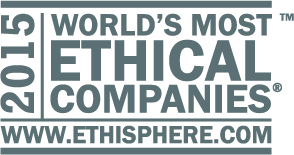  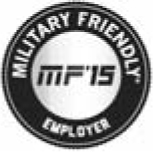    VOTE BY MAIL Mark, sign and date your proxy card and return it in the postage-paid envelope we have provided or return it to Vote Processing, c/o Broadridge, 51 Mercedes Way, Edgewood, NY 11717. |
 | ||||
|  | |||
| ||||

THE HARTFORD FINANCIAL SERVICES GROUP, INC.ONE HARTFORD PLAZAMAILSTOP# H0-1-09 HARTFORD PLAZAHARTFORD, CT 06155
VOTE BY INTERNET - www.proxyvote.comUse the Internet to transmit your voting instructions and for electronic delivery of information up until 11:59 P.M. Eastern Daylight Time on May 19, 2015. Have your proxy card in hand when you access the web site and follow the instructions to obtain your records and to create an electronic voting instruction form.
ELECTRONIC DELIVERY OF FUTURE PROXY MATERIALSIf you would like to reduce the costs incurred by our company in mailing proxy materials, you can consent to receiving all future proxy statements, proxy cards and annual reports electronically via e-mail or the Internet. To sign up for electronic delivery, please follow the instructions above to vote using the Internet and, when prompted, indicate that you agree to receive or access proxy materials electronically in future years.
VOTE BY PHONE - 1-800-690-6903Use any touch-tone telephone to transmit your voting instructions up until 11:59 P.M. Eastern Daylight Time on May 19, 2015. Have your proxy card in hand when you call and then follow the instructions.
VOTE BY MAILMark, sign and date your proxy card and return it in the postage-paid envelope we have provided or return it to Vote Processing, c/o Broadridge, 51 Mercedes Way, Edgewood, NY 11717.
TO VOTE, MARK BLOCKS BELOW IN BLUE OR BLACK INK AS FOLLOWS: | |
| KEEP THIS PORTION FOR YOUR RECORDS | |
| DETACH AND RETURN THIS PORTION ONLY | |
| THIS PROXY CARD IS VALID ONLY WHEN SIGNED AND DATED. | |
| THE HARTFORD FINANCIAL SERVICES GROUP, INC. | ||||||||||||||||||||||||||||||
| The Board of Directors recommends you vote "FOR" all nominees for election as directors: | ||||||||||||||||||||||||||||||
| 1. Election of Directors | For | Against | Abstain | ||||||||||||||||||
| 1a. | Robert B. Allardice, III | o | o | o | The Board of Directors recommends you vote "FOR" proposals 2 and 3. | For | Against | Abstain | |||||||||||||
| 1b. | Carlos Dominguez | o | o | o | 2. | Ratification of the appointment of Deloitte & Touche LLP as the independent registered public accounting firm of the Company for the fiscal year ending December 31, | |||||||||||||||
| 1c. | Trevor Fetter | o | o | o | 3. | Management proposal to approve, on a non-binding advisory basis, the compensation of the Company's named executive officers as disclosed in the Company's proxy statement | |||||||||||||||
| o | o | o | |||||||||||||||||||
| 1d. | Stephen P. McGill | o | o | o | |||||||||||||||||
| 1e. | Kathryn A. Mikells | o | o | o | |||||||||||||||||
| 1f. | Michael G. Morris | o | o | o | |||||||||||||||||
| 1g. | Thomas A. Renyi | o | o | o | |||||||||||||||||
NOTE: meeting or any adjournment thereof. | |||||||||||||||||||||
| 1h. | Julie G. Richardson | o | o | o | |||||||||||||||||
| For address changes and/or comments, mark here. | ☐ | ||||||||||||||||||||
| 1i. | Teresa W. Roseborough | o | o | o | |||||||||||||||||
| 1j. | Virginia P. Ruesterholz | o | o | o | |||||||||||||||||
| 1k. | Christopher J. Swift | o | o | o | |||||||||||||||||
| 1l. | Greig Woodring | o | o | o | |||||||||||||||||
| Please sign exactly as your name(s) appear(s) hereon. When signing as attorney, executor, administrator, or other fiduciary, please give full title as such. Joint owners should each sign personally. All holders must sign. If a corporation or partnership, please sign in full corporate or partnership name by authorized officer. | |||||||||||||||||||||
| | |||||||||||||||||||||
| Signature [PLEASE SIGN WITHIN BOX] | Date | Signature (Joint Owners) | Date | ||||||||||||||||||


The Hartford Financial Services Group, Inc.2015
THE HARTFORD FINANCIAL SERVICES GROUP, INC.
Important Notice Regarding the Availability of Proxy Materials for the Annual MeetingMeeting:
The undersigned hereby appoints Alan J. Kreczko, Executive Vice President and General Counsel, and Donald C. Hunt, Vice President and Corporate Secretary, and each of them, as proxies of the undersigned, each with power to appoint his or her substitute, and hereby authorizes each or any of them to vote, as designated on the reverse side of this proxy, all shares of common stock of The Hartford Financial Services Group, Inc. (the "Company") held of record, and all shares held in the Company's Dividend Reinvestment and Cash Payment Plan, the Hartford Investment and Savings Plan ("ISP") and the Hartford Deferred Restricted Stock Unit Plan ("Stock Unit Plan"), which the undersigned is entitled to vote if personally present at the2018 Annual Meeting of Shareholders, of the Company to be heldProxy Statement and 2017 Annual Report are available at 12:30 P.M. E.D.T. on May 20, 2015, at the Wallace Stevens Theater at the Company's Home Office, One Hartford Plaza, Hartford, CT 06155, and at any adjournments or postponements thereof, and confers discretionary authority upon each such proxy to vote upon any other matter properly brought before the meeting.
If you own additional shares of common stock in a "street name" capacity (i.e. through a broker, nominee or some other agency that holds common stock for your account), including shares held in the Company's Employee Stock Purchase Plan, those shares are represented by a separate proxy provided by your broker or other nominee.
Shares of common stock for the accounts of Company employees who participate in the ISP and the Stock Unit Plan are held of record and are voted by the respective trustees of these plans. This card provides instructions to plan trustees for voting plan shares. To allow sufficient time for the trustees to tabulate the vote of plan shares, you must vote by telephone or online or return this proxy so that it is received by 5:00 p.m. E.D.T. on May 18, 2015.
Please specify your choices by marking the appropriate boxes on the reverse side of this Proxy. The shares represented by this Proxy will be voted as you designate on the reverse side.IF NO DESIGNATION IS MADE, THE SHARES WILL BE VOTED AS THE BOARD OF DIRECTORS RECOMMENDS: "FOR" THE ELECTION OF DIRECTOR NOMINEES NAMED IN ITEM 1; AND "FOR" ITEMS 2 and 3. Please sign, date, and return this Proxy, or vote by telephone or through the Internet.www.proxyvote.com
| E06601-P73626-Z67212 |
THE HARTFORD FINANCIAL SERVICES GROUP, INC. Annual Meeting of Shareholders May 16, 2018 12:30 P.M. | |||
| This proxy is solicited by the Board of Directors | |||
| The undersigned hereby appoints David C. Robinson, Executive Vice President and General Counsel, and Donald C. Hunt, Vice President and Corporate Secretary, and each of them, as proxies of the undersigned, each with power to appoint his or her substitute, and hereby authorizes each or any of them to vote, as designated on the reverse side of this proxy, all shares of common stock of The Hartford Financial Services Group, Inc. (the "Company") held of record, and all shares held in the Company's Dividend Reinvestment and Cash Payment Plan, the Hartford Investment and Savings Plan ("ISP") and the Hartford Deferred Restricted Stock Unit Plan ("Stock Unit Plan"), which the undersigned is entitled to vote if personally present at the Annual Meeting of Shareholders of the Company to be held at 12:30 P.M. E.D.T. on May 16, 2018, at the Wallace Stevens Theater at the Company's Home Office, One Hartford Plaza, Hartford, CT 06155, and at any adjournments or postponements thereof, and confers discretionary authority upon each such proxy to vote upon any other matter properly brought before the meeting. | |||
| If you own additional shares of common stock in a "street name" capacity (i.e. through a broker, nominee or some other agency that holds common stock for your account), including shares held in the Company's Employee Stock Purchase Plan, those shares are represented by a separate proxy provided by your broker or other nominee. | |||
| Shares of common stock for the accounts of Company employees who participate in the ISP and the Stock Unit Plan are held of record and are voted by the respective trustees of these plans. This card provides instructions to plan trustees for voting plan shares. To allow sufficient time for the trustees to tabulate the vote of plan shares, you must vote by telephone or online or return this proxy so that it is received by 5:00 p.m. E.D.T. on May 14, 2018. | |||
Please specify your choices by marking the appropriate boxes on the reverse side of this Proxy. The shares represented by this Proxy will be voted as you designate on the reverse side. IF NO DESIGNATION IS MADE, THE SHARES WILL BE VOTED AS THE BOARD OF DIRECTORS RECOMMENDS: "FOR" THE ELECTION OF DIRECTOR NOMINEES NAMED IN ITEM 1, AND "FOR" ITEMS 2 AND 3. Please sign, date, and return this Proxy, or vote by telephone or through the Internet. | |||
| Address change/comments: | |||
| (If you noted any Address Changes and/or Comments above, please mark the corresponding box on the reverse side.) | |||
| Continued and to be signed on reverse side | |||
| THE HARTFORD FINANCIAL SERVICES GROUP, INC. | Meeting Information | ||||
 | Meeting Type: | Annual Meeting | |||
| For holders as of: | March 19, 2018 | ||||
| Date: May 16, 2018 | Time: 12:30 PM EDT | ||||
| Location: | The Hartford Financial Services Group, Inc. Wallace Stevens Theater One Hartford Plaza Hartford, CT 06155 | ||||
THE HARTFORD FINANCIAL SERVICES GROUP, INC. ONE HARTFORD PLAZA MAILSTOP# H0-1-09 HARTFORD PLAZA HARTFORD, CT 06155 | |||||
| You are receiving this communication because you hold shares in the company named above. | |||||
This is not a ballot. You cannot use this notice to vote these shares. This communication presents only an overview of the more complete proxy materials that are available to you on the Internet. You may view the proxy materials online at www.proxyvote.com or easily request a paper copy (see reverse side). | |||||
| We encourage you to access and review all of the important information contained in the proxy materials before voting. | |||||
| See the reverse side of this notice to obtain proxy materials and voting instructions. | |||||
—Before You Vote— | ||||
| How to Access the Proxy Materials | ||||
| Proxy Materials Available to VIEW or RECEIVE: | ||||
| Notice of 2018 Annual Meeting of Shareholders, Proxy Statement and 2017 Annual Report | ||||
| How to View Online: | ||||
| Have the information that is printed in the box marked by the arrow | XXXX XXXX XXXX XXXX | (located on the following | ||
page) and visit: www.proxyvote.com. | ||||
| How to Request and Receive a PAPER or E-MAIL Copy: | ||||
| If you want to receive a paper or e-mail copy of these documents, you must request one. There is NO charge for requesting a copy. Please choose one of the following methods to make your request: | ||||
1) BY INTERNET: www.proxyvote.com | ||||
2) BY TELEPHONE: 1-800-579-1639 | ||||
3) BY E-MAIL*: sendmaterial@proxyvote.com | ||||
| * If requesting materials by e-mail, please send a blank e-mail with the information that is printed in the box marked | ||||
| by the arrow | XXXX XXXX XXXX XXXX | (located on the following page) in the subject line. Requests, instructions | ||
| and other inquiries sent to this e-mail address will NOT be forwarded to your investment advisor. | ||||
| Please make requests for paper or e-mail copies using any of the methods above on or before May 2, 2018 to facilitate timely delivery. | ||||
Vote In Person: Many shareholder meetings have attendance requirements including, but not limited to, the possession of an attendance ticket issued by the entity holding the meeting. Please check the meeting materials for any special requirements for meeting attendance. At the meeting, you will need to request a ballot to vote these shares. | ||
Vote By Internet: To vote now by Internet, go to www.proxyvote.com. Have the information that is printed in the box marked | ||
| by the arrow ➔ | XXXX XXXX XXXX XXXX | (located on the following page) available and follow the instructions. |
Vote By Mail: You can vote by mail by requesting a paper copy of the materials, which will include a proxy card. | ||
| Voting Items | |||||
| The Board of Directors recommends you vote | |||||
| FOR all nominees for election as directors: | |||||
| 1. | Election of Directors | The Board of Directors recommends you vote FOR proposals 2 and 3. | |||
| 1a. | Robert B. Allardice, III | 2. | Ratification of the appointment of Deloitte & Touche LLP as the independent registered public accounting firm of the Company for the fiscal year ending December 31, 2018 | ||
| 1b. | Carlos Dominguez | 3. | Management proposal to approve, on a non-binding advisory basis, the compensation of the Company's named executive officers as disclosed in the Company's proxy statement | ||
| 1c. | Trevor Fetter | ||||
| 1d. | Stephen P. McGill | ||||
| 1e. | Kathryn A. Mikells | ||||
| 1f. | Michael G. Morris | NOTE: Such other business as may properly come before the meeting or any adjournment thereof. | |||
| 1g. | Thomas A. Renyi | ||||
| 1h. | Julie G. Richardson | ||||
| 1i. | Teresa W. Roseborough | ||||
| 1j. | Virginia P. Ruesterholz | ||||
| 1k. | Christopher J. Swift | ||||
| 1l. | Greig Woodring | ||||